Paul van Yperen's Blog, page 179
November 3, 2020
Rosine Deréan
French actress Rosine Deréan (1910-2001) was a popular star of the French cinema of the 1930s. Her best-known films are the melodrama Les deux orphelines (1933) and the romantic drama Lac aux dames (1934). She was married to Claude Dauphin and was a member of the French Resistance during the Second World War.
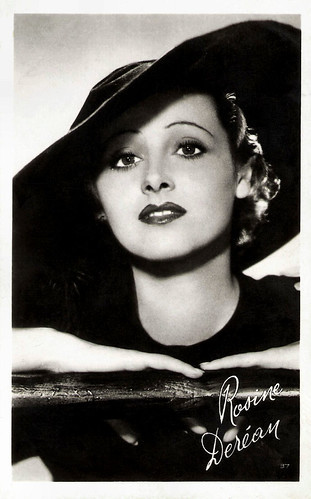
French postcard, no. 37.
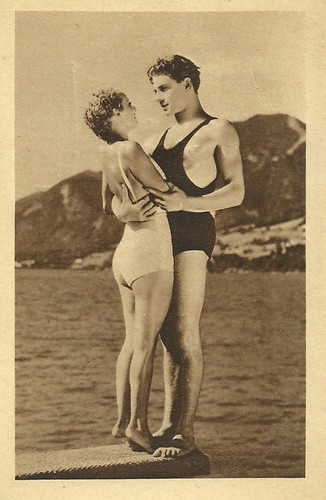
French postcard, Imprimerie A. Breger Frères, Paris. Issued for the cinema Max-Linder Pathé, 24, Boulevard Poissonière, Paris, where the film was presented 14-20 September 1934. Jean-Pierre Aumont and Rosine Dérean in Lac au dames/Ladies Lake (Marc Allégret, 1934). The film is situated at Lake Konstanz. In Germany, the film was presented as Hell in Frauensee ('Frauensee' was the title of the novel by Vicki Baum the film was based on).
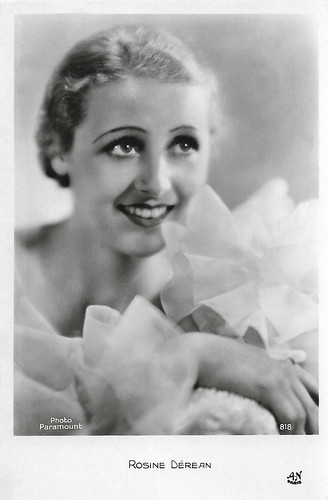
French postcard by A.N., Paris, no. 818. Photo: Paramount.
The Two Orphans
Rosine Deréan was born as Rosine Jeanne Schlotterbeck in 1910 in Paris, France. She was the daughter of actress Yane Exiane, who was a star at the Folies-Bergère and appeared in some silent films.
Rosine took her stage name from the character Sophie de Réan, the naughty heroine of the children's book 'Les Malheurs de Sophie' (Sophie's Misfortunes, 1858) by the Countess of Ségur.
In 1931, without any acting training, she made her film debut opposite Harry Baur and René Lefèvre in the exotic mystery Les cinq gentlemen maudits/Moon Over Morocco (Julien Duvivier, 1931).
Her career was launched, and the following year, she played in seven films. First, she appeared in the crime film Le chien jaune/The Yellow Dog (Jean Tarride, 1932), with Abel Tarride (the director's father) and Rolla Norman . It is an adaptation of the novel 'Maigret and the Yellow Dog' by the Belgian writer Georges Simenon.
She also co-starred in the drama La belle marinière/The Beautiful Sailor (Harry Lachman, 1932) starring Pierre Blanchar , Madeleine Renaud , and Jean Gabin . It was made by the French subsidiary of Paramount Pictures at the company's Joinville Studios.
With Renée Saint-Cyr , she played in the historical drama Les deux orphelines/The Two Orphans (Maurice Tourneur, 1933). The film was based on the play 'The Two Orphans' which had been turned into several films. Tourneur altered the story slightly by moving it forward from the French Revolution to the Napoleonic Era.
L'or (1934) was the French-language version of the German Science-Fiction film Gold (Karl Hartl, 1934). The film involves a British scientist who is attempting to create a device that turns base materials into gold. Director Karl Hartl developed Gold after the international success of Ufa's Science-Fiction film Der Tunnel/The Tunnel (Kurt Hoffmann, 1933).
Gold was Ufa's super production of that time and reportedly took 14 months to shoot. Brigitte Helm reprised her role in the French version, while Rosine Dérean replaced Lien Deyers . Serge de Poligny directed the scenes in French with the scripted adapted to French by Jacques Thierry.
Her next film was the French drama Lac aux dames/Ladies Lake (Marc Allégret, 1934) in which she co-starred with Jean-Pierre Aumont , Simone Simon , and Ila Meery . The film, based on a novel by Vicki Baum, was released by the French branch of Tobis Film.
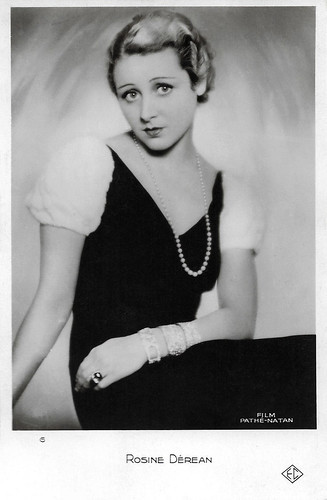
French postcard by EC (Editions Chantal, Paris), no. 6. Photo: Film Pathé-Natan.
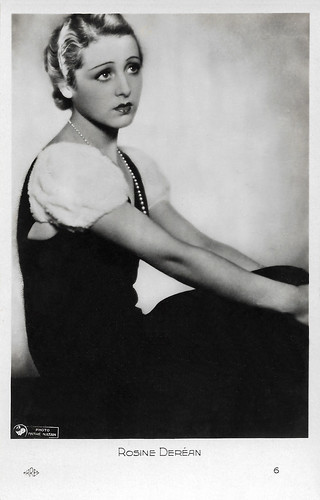
French postcard by Erres, no. 6. Photo: Pathé Nathan.
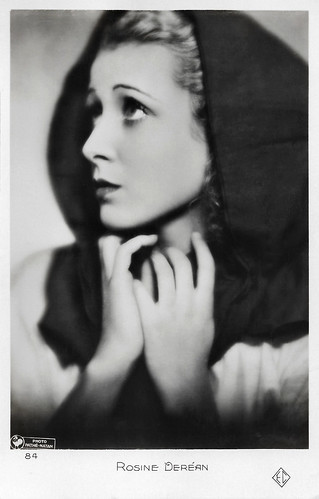
French postcard by EC (Editions Chantal), no. 84. Photo: Pathé-Natan.
The Story of a Cheat
Rosine Dérean played a jewel thief in Le Roman d'un tricheur/The Story of a Cheat (1936), starring, written, and directed by Sacha Guitry . It was adapted from Guitry's only novel, 'Les Mémoires d'un tricheur' (1935). Dérean also appeared in Guitry's Faisons un rêve.../Let's Make a Dream (Sacha Guitry, 1936), and Les Perles de la couronne/The Pearls of the Crown (Sacha Guitry, 1937).
In 1937, she married actor Claude Dauphin , with whom she would have a son, André Legrand-Dauphin. That year, she also had a supporting role in the crime film Arsène Lupin détective/Arsene Lupin, Detective (Henri Diamant-Berger, 1937) starring Jules Berry , Gabriel Signoret , and Suzy Prim .
She then acted in a few stage productions. In 1940, she appeared as herself in the comedy Les surprises de la radio/Radio Surprises (Marcel Aboulker, 1940) starring Marguerite Moreno and Armand Bernard .
Claude Dauphin joined the Resistance during the war and moved to London in 1942 to join the Forces Françaises Libres (Free French Forces). Rosine retired to their chateau at 'La Bourdillière' in the small village of Genillé, in Touraine. A patriot and a committed resistance member, she hid English pilots there. In 1943, following a denunciation, she was arrested. Rosine was deported to the Ravensbruck concentration camp where she was a prisoner until 1945. She narrowly escaped death.
Upon her return, she separated from her husband and gradually disappeared from public life. She had a small part in the crime film L'assassin n'est pas coupable/The Murderer is Not Guilty (René Delacroix, 1946) starring Albert Préjean , Jacqueline Gauthier and Jules Berry . Her final film appearance was in Agence matrimoniale/Matrimonial Agency (Jean-Paul Le Chanois, 1952), starring Bernard Blier . In 1952 she also divorced Claude Dauphin .
She retired and ended her life in Genillé, where she lived in the former abbey of La Bourdillière. In 2001, Rosine Dérean passed away in Genillé, shortly after her 91st birthday. She was cremated at the crematorium of Esvres-les-Tours (Indre-et-Loire) and her ashes scattered in Genillé.
For her work during the war, she was decorated with the Légion d'honneur (Legion of Honour) and the Croix de Guerre avec palme (the War Cross with palm). Her son passed away in 2008. In 2009, the municipality of Genillé inaugurated a village hall in her name. In 2017, Christophe Meunier published the biography 'Rosine DEREAN, le roman d'une actrice'.
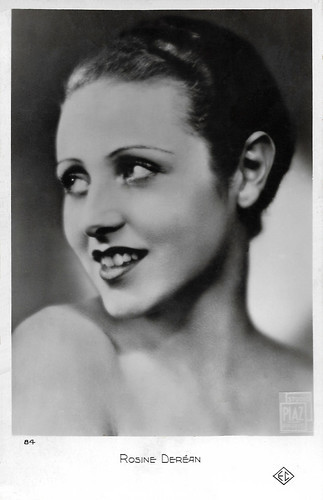
French postcard by EC, Paris, no. 84. Photo: Studio Piaz, Paris.
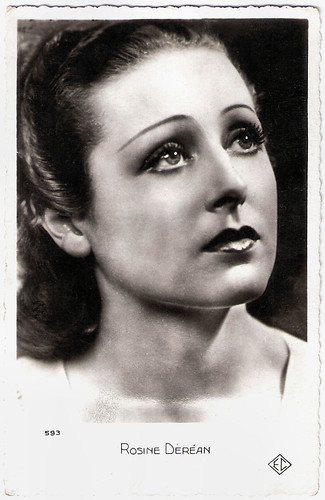
French postcard by EC, no. 593.
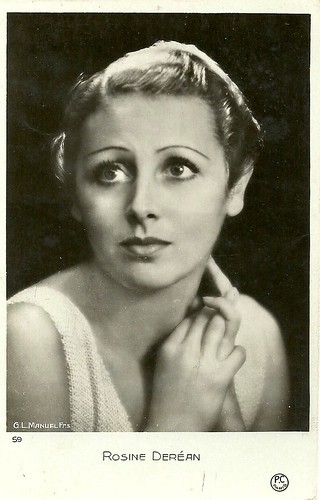
French postcard by P.C., Paris, no. 59. Photo: G.L. Manuel Frères.
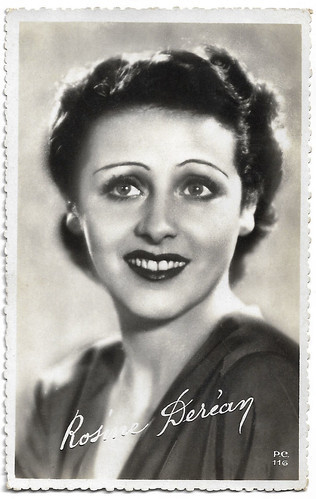
French postcard by P.C., Paris, no. 116.
Sources: Yvan Foucart (L'Encinémathèque - French), Wikipedia (French and English) and .

French postcard, no. 37.

French postcard, Imprimerie A. Breger Frères, Paris. Issued for the cinema Max-Linder Pathé, 24, Boulevard Poissonière, Paris, where the film was presented 14-20 September 1934. Jean-Pierre Aumont and Rosine Dérean in Lac au dames/Ladies Lake (Marc Allégret, 1934). The film is situated at Lake Konstanz. In Germany, the film was presented as Hell in Frauensee ('Frauensee' was the title of the novel by Vicki Baum the film was based on).

French postcard by A.N., Paris, no. 818. Photo: Paramount.
The Two Orphans
Rosine Deréan was born as Rosine Jeanne Schlotterbeck in 1910 in Paris, France. She was the daughter of actress Yane Exiane, who was a star at the Folies-Bergère and appeared in some silent films.
Rosine took her stage name from the character Sophie de Réan, the naughty heroine of the children's book 'Les Malheurs de Sophie' (Sophie's Misfortunes, 1858) by the Countess of Ségur.
In 1931, without any acting training, she made her film debut opposite Harry Baur and René Lefèvre in the exotic mystery Les cinq gentlemen maudits/Moon Over Morocco (Julien Duvivier, 1931).
Her career was launched, and the following year, she played in seven films. First, she appeared in the crime film Le chien jaune/The Yellow Dog (Jean Tarride, 1932), with Abel Tarride (the director's father) and Rolla Norman . It is an adaptation of the novel 'Maigret and the Yellow Dog' by the Belgian writer Georges Simenon.
She also co-starred in the drama La belle marinière/The Beautiful Sailor (Harry Lachman, 1932) starring Pierre Blanchar , Madeleine Renaud , and Jean Gabin . It was made by the French subsidiary of Paramount Pictures at the company's Joinville Studios.
With Renée Saint-Cyr , she played in the historical drama Les deux orphelines/The Two Orphans (Maurice Tourneur, 1933). The film was based on the play 'The Two Orphans' which had been turned into several films. Tourneur altered the story slightly by moving it forward from the French Revolution to the Napoleonic Era.
L'or (1934) was the French-language version of the German Science-Fiction film Gold (Karl Hartl, 1934). The film involves a British scientist who is attempting to create a device that turns base materials into gold. Director Karl Hartl developed Gold after the international success of Ufa's Science-Fiction film Der Tunnel/The Tunnel (Kurt Hoffmann, 1933).
Gold was Ufa's super production of that time and reportedly took 14 months to shoot. Brigitte Helm reprised her role in the French version, while Rosine Dérean replaced Lien Deyers . Serge de Poligny directed the scenes in French with the scripted adapted to French by Jacques Thierry.
Her next film was the French drama Lac aux dames/Ladies Lake (Marc Allégret, 1934) in which she co-starred with Jean-Pierre Aumont , Simone Simon , and Ila Meery . The film, based on a novel by Vicki Baum, was released by the French branch of Tobis Film.

French postcard by EC (Editions Chantal, Paris), no. 6. Photo: Film Pathé-Natan.

French postcard by Erres, no. 6. Photo: Pathé Nathan.

French postcard by EC (Editions Chantal), no. 84. Photo: Pathé-Natan.
The Story of a Cheat
Rosine Dérean played a jewel thief in Le Roman d'un tricheur/The Story of a Cheat (1936), starring, written, and directed by Sacha Guitry . It was adapted from Guitry's only novel, 'Les Mémoires d'un tricheur' (1935). Dérean also appeared in Guitry's Faisons un rêve.../Let's Make a Dream (Sacha Guitry, 1936), and Les Perles de la couronne/The Pearls of the Crown (Sacha Guitry, 1937).
In 1937, she married actor Claude Dauphin , with whom she would have a son, André Legrand-Dauphin. That year, she also had a supporting role in the crime film Arsène Lupin détective/Arsene Lupin, Detective (Henri Diamant-Berger, 1937) starring Jules Berry , Gabriel Signoret , and Suzy Prim .
She then acted in a few stage productions. In 1940, she appeared as herself in the comedy Les surprises de la radio/Radio Surprises (Marcel Aboulker, 1940) starring Marguerite Moreno and Armand Bernard .
Claude Dauphin joined the Resistance during the war and moved to London in 1942 to join the Forces Françaises Libres (Free French Forces). Rosine retired to their chateau at 'La Bourdillière' in the small village of Genillé, in Touraine. A patriot and a committed resistance member, she hid English pilots there. In 1943, following a denunciation, she was arrested. Rosine was deported to the Ravensbruck concentration camp where she was a prisoner until 1945. She narrowly escaped death.
Upon her return, she separated from her husband and gradually disappeared from public life. She had a small part in the crime film L'assassin n'est pas coupable/The Murderer is Not Guilty (René Delacroix, 1946) starring Albert Préjean , Jacqueline Gauthier and Jules Berry . Her final film appearance was in Agence matrimoniale/Matrimonial Agency (Jean-Paul Le Chanois, 1952), starring Bernard Blier . In 1952 she also divorced Claude Dauphin .
She retired and ended her life in Genillé, where she lived in the former abbey of La Bourdillière. In 2001, Rosine Dérean passed away in Genillé, shortly after her 91st birthday. She was cremated at the crematorium of Esvres-les-Tours (Indre-et-Loire) and her ashes scattered in Genillé.
For her work during the war, she was decorated with the Légion d'honneur (Legion of Honour) and the Croix de Guerre avec palme (the War Cross with palm). Her son passed away in 2008. In 2009, the municipality of Genillé inaugurated a village hall in her name. In 2017, Christophe Meunier published the biography 'Rosine DEREAN, le roman d'une actrice'.

French postcard by EC, Paris, no. 84. Photo: Studio Piaz, Paris.

French postcard by EC, no. 593.

French postcard by P.C., Paris, no. 59. Photo: G.L. Manuel Frères.

French postcard by P.C., Paris, no. 116.
Sources: Yvan Foucart (L'Encinémathèque - French), Wikipedia (French and English) and .
Published on November 03, 2020 22:00
November 2, 2020
Charlemagne (1933)
Raimu and Marie Glory were the stars of the French film Charlemagne (Pierre Colombier, 1933). This Pathé Natan production was based on the comic play 'The Admirable Crichton' by J.M. Barrie.
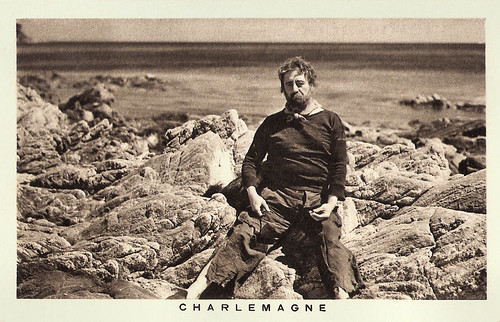
French postcard by Rasiogravure A. Breger Frères, Paris for Victor-Hugo Théâtre Pathé Natan. Photo: Raimu in Charlemagne (Pierre Colombier, 1933).
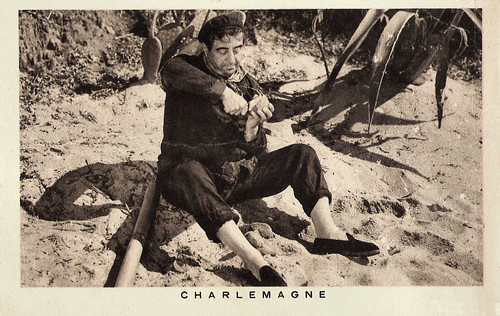
French postcard by Rasiogravure A. Breger Frères, Paris for Victor-Hugo Théâtre Pathé Natan. Photo: Raimu in Charlemagne (Pierre Colombier, 1933).
Swept away and not dressing
Charlemagne is a 1933 French comedy-drama directed by Pierre Colombier and starring Raimu and Marie Glory . Other cast members are Léon Bélières, Jean Dax , Gaston Jacquet and Lucien Baroux .
A group of seven upper-class passengers of a ship is saved from drowning by a stoker and brought to a desert island. The stoker then proposes to the sailor Charlemagne ( Raimu ) to become the king of the peninsula.
Yves Mirande wrote the screenplay, based on the 1902 comic stage play 'The Admirable Crichton' by Scottish novelist and playwright J. M. Barrie, best known as the creator of 'Peter Pan'.
Barrie took the title from the sobriquet of a fellow Scot, the polymath James Crichton, a 16th-century genius and athlete. The plot may derive from 'Robinson's Eiland', an 1896 German play by Ludwig Fulda. In this satire, a group of Berlin officials (including a capitalist, a professor and a journalist) is shipwrecked on an island, where a secretary, Arnold, becomes the natural leader of the group.
The play was filmed several times, including a silent British version, The Admirable Crichton (1918) directed by G. B. Samuelson and starring Basil Gill . In 1919 it was filmed by Cecil B. DeMille as Male and Female starring Gloria Swanson .
An early Hollywood sound version, the screwball musical We're Not Dressing (Norman Taurog, 1934), is about a beautiful yacht owner (Carole Lombard) who becomes stranded on an island with her socialite friends, a wacky husband-and-wife research team (George Burns and Gracie Allen), and a singing sailor (Bing Crosby).
A popular sound version is the British-American production The Admirable Crichton (Lewis Gilbert, 1957) starring Kenneth More. Lina Wertmüller directed an Italian version, Travolti da un insolito destino nell'azzurro mare d'agosto/Swept Away (1974) starring Giancarlo Giannini and Mariangela Melato. Less successful was the remake, Swept Away (Guy Ritchie, 2002) with Madonna and Adriano Giannini, the son of Giancarlo Giannini.
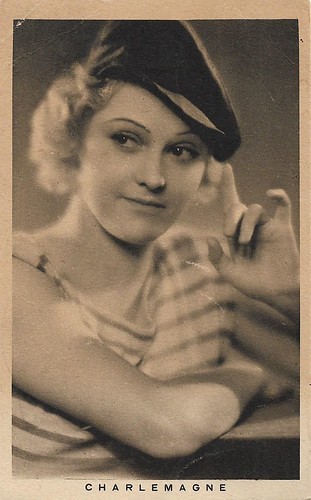
French postcard by Rasiogravure A. Breger Frères, Paris for Victor-Hugo Théâtre Pathé Natan. Photo: Marie Glory in Charlemagne (Pierre Colombier, 1933). Publicity for the release of the film at the Pathé Natan cinema in Lyon as of 22 December 1933.
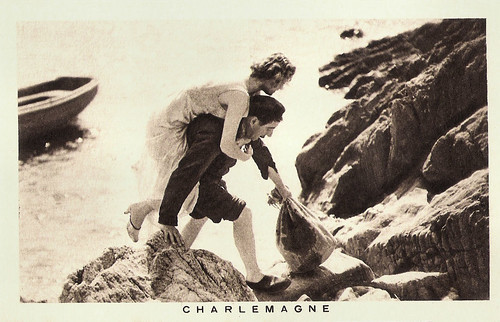
French postcard by Rasiogravure A. Breger Frères, Paris for Victor-Hugo Théâtre Pathé Natan. Photo: Raimu and Marie Glory in Charlemagne (Pierre Colombier, 1933).
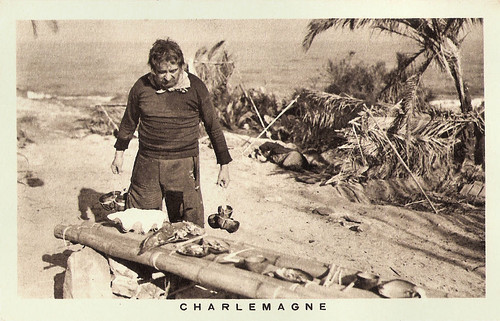
French postcard by Rasiogravure A. Breger Frères, Paris for Victor-Hugo Théâtre Pathé Natan. Photo: Raimu in Charlemagne (Pierre Colombier, 1933).
Sources: Wikipedia and IMDb.

French postcard by Rasiogravure A. Breger Frères, Paris for Victor-Hugo Théâtre Pathé Natan. Photo: Raimu in Charlemagne (Pierre Colombier, 1933).

French postcard by Rasiogravure A. Breger Frères, Paris for Victor-Hugo Théâtre Pathé Natan. Photo: Raimu in Charlemagne (Pierre Colombier, 1933).
Swept away and not dressing
Charlemagne is a 1933 French comedy-drama directed by Pierre Colombier and starring Raimu and Marie Glory . Other cast members are Léon Bélières, Jean Dax , Gaston Jacquet and Lucien Baroux .
A group of seven upper-class passengers of a ship is saved from drowning by a stoker and brought to a desert island. The stoker then proposes to the sailor Charlemagne ( Raimu ) to become the king of the peninsula.
Yves Mirande wrote the screenplay, based on the 1902 comic stage play 'The Admirable Crichton' by Scottish novelist and playwright J. M. Barrie, best known as the creator of 'Peter Pan'.
Barrie took the title from the sobriquet of a fellow Scot, the polymath James Crichton, a 16th-century genius and athlete. The plot may derive from 'Robinson's Eiland', an 1896 German play by Ludwig Fulda. In this satire, a group of Berlin officials (including a capitalist, a professor and a journalist) is shipwrecked on an island, where a secretary, Arnold, becomes the natural leader of the group.
The play was filmed several times, including a silent British version, The Admirable Crichton (1918) directed by G. B. Samuelson and starring Basil Gill . In 1919 it was filmed by Cecil B. DeMille as Male and Female starring Gloria Swanson .
An early Hollywood sound version, the screwball musical We're Not Dressing (Norman Taurog, 1934), is about a beautiful yacht owner (Carole Lombard) who becomes stranded on an island with her socialite friends, a wacky husband-and-wife research team (George Burns and Gracie Allen), and a singing sailor (Bing Crosby).
A popular sound version is the British-American production The Admirable Crichton (Lewis Gilbert, 1957) starring Kenneth More. Lina Wertmüller directed an Italian version, Travolti da un insolito destino nell'azzurro mare d'agosto/Swept Away (1974) starring Giancarlo Giannini and Mariangela Melato. Less successful was the remake, Swept Away (Guy Ritchie, 2002) with Madonna and Adriano Giannini, the son of Giancarlo Giannini.

French postcard by Rasiogravure A. Breger Frères, Paris for Victor-Hugo Théâtre Pathé Natan. Photo: Marie Glory in Charlemagne (Pierre Colombier, 1933). Publicity for the release of the film at the Pathé Natan cinema in Lyon as of 22 December 1933.

French postcard by Rasiogravure A. Breger Frères, Paris for Victor-Hugo Théâtre Pathé Natan. Photo: Raimu and Marie Glory in Charlemagne (Pierre Colombier, 1933).

French postcard by Rasiogravure A. Breger Frères, Paris for Victor-Hugo Théâtre Pathé Natan. Photo: Raimu in Charlemagne (Pierre Colombier, 1933).
Sources: Wikipedia and IMDb.
Published on November 02, 2020 22:00
November 1, 2020
William Desmond
Handsome William Desmond (1878–1949) was an American actor, who appeared in 205 films between 1915 and 1948. He was nicknamed 'The King of the Silent Serials' and acted in numerous silent Westerns and adventure films.
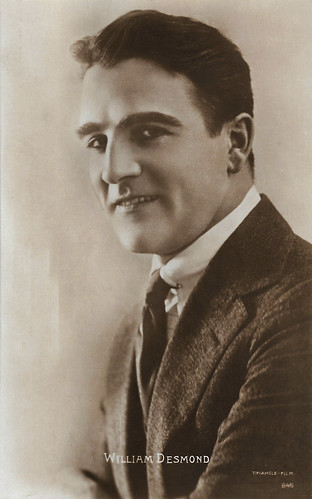
Swedish postcard by Förlag Nordisk Konst, Stockholm, no. 845. Photo: Triangle-Film.
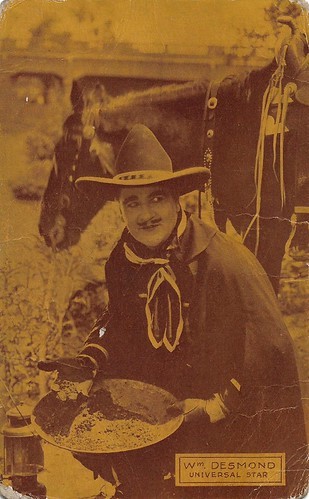
American Arcade card. Photo: Universal.
A silent film star at Triangle
William Desmond was born William Mannion in Dublin, Ireland, in 1878. As a child, he moved with his family to New York, where he spent his childhood and adolescence.
He changed his name to William Desmond when he debuted on the stage. He worked in vaudeville and stage plays before embarking on a film career that would make him a silent film star.
His screen debut dates back to 1915: he appeared in a major role in Oscar Apfel's silent comedy Kilmeny (1915). The film was produced by a small production company, the Oliver Morosco Photoplay Company, and released by Paramount Pictures.
In 1916 he started to work for Triangle in films such as Not My Sister (1916) with Bessie Barriscale, and The Dawn Maker (1916) by and with William S. Hart . Desmond had a starring role as a detective in Flying Colors (1917). In a small part featured his future wife, the actress Mary McIvor.
In the later 1910s, Desmond starred in various Triangle Films directed by Frank Borzage, including Society for Sale (1918) with Gloria Swanson . From 1919 Desmond starred in a series of mostly Westerns, made by small companies and distributed by Pathé Exchange.
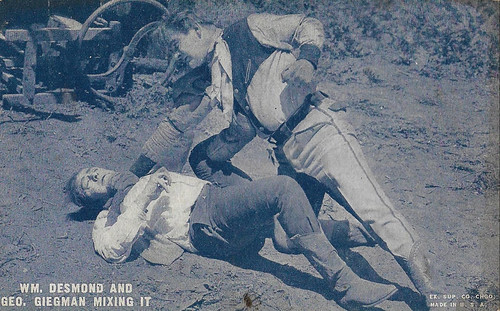
American Arcade card by Exhibit Supply Co., Chicago. Caption: William Desmond and Geo. Giegman Mixing It.
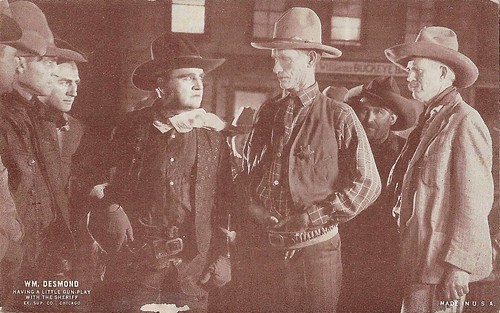
American Arcade card by Exhibit Supply Co., Chicago. Caption: William Desmond, Having a Little Gun-play with the Sheriff.
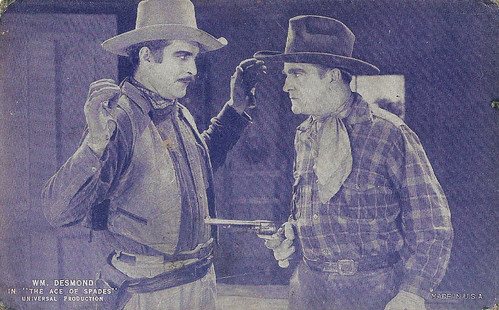
American Arcade card. Photo: Universal. William Desmond in the serial The Ace of Spades (Henry MacRae, 1925).
Western serials until the end
By 1922, William Desmond was working at Universal and did various - often Western - serials there. These included Perils of the Yukon (1922) and Around the World in 18 Days (1923) with Laura La Plante , and The Phantom Fortune (1923) with Esther Ralston.
Other serials were Beasts of Paradise (1923) and The Riddle Rider (1924) with Eileen Sedgwick, The Ace of Spades (1925) with Mary McAlister, The Winking Idol (1926) and Strings of Steel (1926) again with Sedgwick, The Return of the Riddle Rider (1927), The Vanishing Rider (1928), and The Mystery Rider (1928).
At Universal, Desmond also acted in features such as McGuire of the Mounted (1923), Shadows of the North (1923), and The Extra Girl (1923) with Mabel Normand in an early film about Hollywood. By the mid-1920s Desmond did various Universal Westerns with serial queen Helen Holmes.
During his career, Desmond made 213 films as an actor, and he also participated in some films as a guest. In 1921, he produced Fightin 'Mad, a Western comedy directed by Joseph Franz, of which he was the lead actor.
He practically worked until the end. Yet, after the coming of sound cinema Desmond had to be satisfied with supporting parts in crime films and Westerns. he appeared in Western features and serials with Tom Tyler, but also Tom Mix and Harry Carey. These were produced by smaller studios such as Mascot and Monogram but also often by Universal. In later years, Desmond's roles became even smaller, and he even played uncredited parts.
In 1949, William Desmond died of a heart attack in Los Angeles. He was 71. His remains were interred in the Californian city's Chapel of the Pines Crematory.
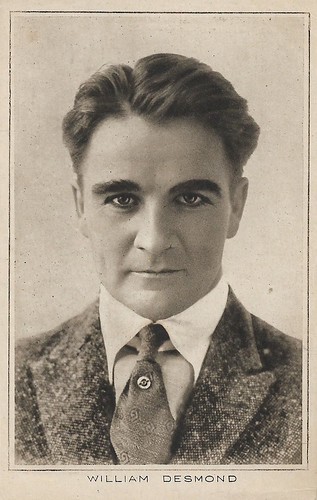
British postcard by "Pictures" Portrait Gallery, London, no. 22.
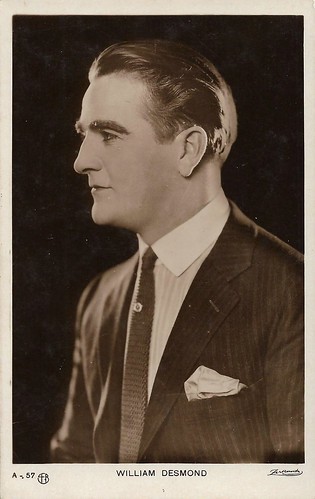
Spanish postcard by EFB (Editorial Fotografica, Barcelona), no. A-57. Photo: Zerkowitz.
Sources: Wikipedia (Italian and English), and .

Swedish postcard by Förlag Nordisk Konst, Stockholm, no. 845. Photo: Triangle-Film.

American Arcade card. Photo: Universal.
A silent film star at Triangle
William Desmond was born William Mannion in Dublin, Ireland, in 1878. As a child, he moved with his family to New York, where he spent his childhood and adolescence.
He changed his name to William Desmond when he debuted on the stage. He worked in vaudeville and stage plays before embarking on a film career that would make him a silent film star.
His screen debut dates back to 1915: he appeared in a major role in Oscar Apfel's silent comedy Kilmeny (1915). The film was produced by a small production company, the Oliver Morosco Photoplay Company, and released by Paramount Pictures.
In 1916 he started to work for Triangle in films such as Not My Sister (1916) with Bessie Barriscale, and The Dawn Maker (1916) by and with William S. Hart . Desmond had a starring role as a detective in Flying Colors (1917). In a small part featured his future wife, the actress Mary McIvor.
In the later 1910s, Desmond starred in various Triangle Films directed by Frank Borzage, including Society for Sale (1918) with Gloria Swanson . From 1919 Desmond starred in a series of mostly Westerns, made by small companies and distributed by Pathé Exchange.

American Arcade card by Exhibit Supply Co., Chicago. Caption: William Desmond and Geo. Giegman Mixing It.

American Arcade card by Exhibit Supply Co., Chicago. Caption: William Desmond, Having a Little Gun-play with the Sheriff.

American Arcade card. Photo: Universal. William Desmond in the serial The Ace of Spades (Henry MacRae, 1925).
Western serials until the end
By 1922, William Desmond was working at Universal and did various - often Western - serials there. These included Perils of the Yukon (1922) and Around the World in 18 Days (1923) with Laura La Plante , and The Phantom Fortune (1923) with Esther Ralston.
Other serials were Beasts of Paradise (1923) and The Riddle Rider (1924) with Eileen Sedgwick, The Ace of Spades (1925) with Mary McAlister, The Winking Idol (1926) and Strings of Steel (1926) again with Sedgwick, The Return of the Riddle Rider (1927), The Vanishing Rider (1928), and The Mystery Rider (1928).
At Universal, Desmond also acted in features such as McGuire of the Mounted (1923), Shadows of the North (1923), and The Extra Girl (1923) with Mabel Normand in an early film about Hollywood. By the mid-1920s Desmond did various Universal Westerns with serial queen Helen Holmes.
During his career, Desmond made 213 films as an actor, and he also participated in some films as a guest. In 1921, he produced Fightin 'Mad, a Western comedy directed by Joseph Franz, of which he was the lead actor.
He practically worked until the end. Yet, after the coming of sound cinema Desmond had to be satisfied with supporting parts in crime films and Westerns. he appeared in Western features and serials with Tom Tyler, but also Tom Mix and Harry Carey. These were produced by smaller studios such as Mascot and Monogram but also often by Universal. In later years, Desmond's roles became even smaller, and he even played uncredited parts.
In 1949, William Desmond died of a heart attack in Los Angeles. He was 71. His remains were interred in the Californian city's Chapel of the Pines Crematory.

British postcard by "Pictures" Portrait Gallery, London, no. 22.

Spanish postcard by EFB (Editorial Fotografica, Barcelona), no. A-57. Photo: Zerkowitz.
Sources: Wikipedia (Italian and English), and .
Published on November 01, 2020 22:00
October 31, 2020
Robert Redford
With his all-American good looks, Robert Redford (1936) was one of the biggest Hollywood stars of the 1970s. In classics as Butch Cassidy and the Sundance Kid (1969), The Sting (1973), and All the President's Men (1976), he was the intelligent, reliable, sometimes sardonic good guy. He received two Oscars: one in 1981 for directing Ordinary People, and one for Lifetime Achievement in 2002. In 2010, the actor, director, producer, businessman, environmentalist, philanthropist, and co-founder of the Sundance Film Festival was appointed Chevalier of the Légion d'honneur in France.

Canadian postcard by Fan Club, no. PC8.

American postcard by Fan Club Post Cards, New York, N.Y., no. PC 22. Paul Newman and Robert Redford in Butch Cassidy and the Sundance Kid (George Roy Hill, 1969).

French postcard in the Collection 'Portraits de Cinema' by Editions Admira, Aix-en-Provence, Serie 6, no. 1 / no. PHN 863. Photo: SNAP Photo / Cosmos. Robert Redford in The Sting (George Roy Hill, 1973).
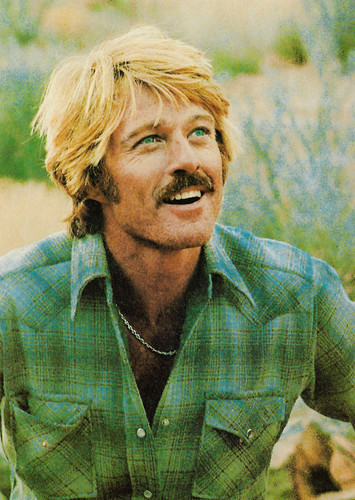
British postcard by Star-Graphics, London, no. S 90. Sent by mail in 1997. Robert Redford in The Electric Horseman (Sydney Pollack, 1979).
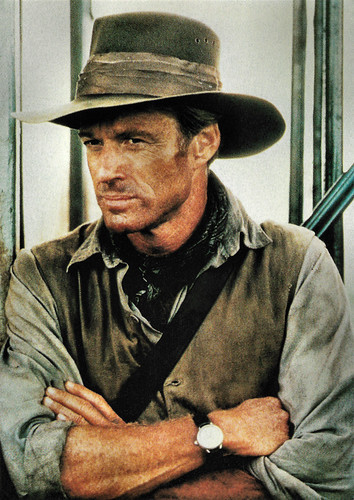
Italian postcard by Vitorius Roma, no. VR 499. Robert Redford in Out of Africa (Sydney Pollack, 1985).
Jane Fonda's stuffy newlywed husband
Charles Robert Redford Jr. was born in Santa Monica, California in 1936. His parents were Martha W. (Hart) and Charles Robert Redford, Sr., a milkman who later worked as an oil company accountant.
Redford's family moved to Van Nuys, California, while his father worked in El Segundo. He attended Van Nuys High School and was interested in art and sports. In 1954, Redford graduated from Van Nuys High School. But his mother died in 1955 from septicemia, and a deeply grieving Redford felt lost emotionally.
Redford won a baseball scholarship to the University of Colorado, but he did not distinguish himself as an athlete there. Instead, "I became the campus drunk and blew out before I could ever get going," he told People magazine in a 1998 interview. After one and a half years, he decided to become an artist and moved to Europe.
His time travelling through Europe was an eye-opening experience for the young Redford, who lived the life of a bohemian. When he returned to America a year and a half later, he was much more focused on my country culturally and politically. He decided on a career as a theatrical designer in New York City, but enrolling at the Pratt Institute and then the American Academy of Dramatic Arts, switching from design to acting.
In 1959, Redford's acting career began on stage, making his Broadway debut with a small role in the comedy 'Tall Story'. It was followed by parts in 'The Highest Tree' (1959) and 'Sunday in New York' (1961).
On TV, he appeared as a guest star on numerous programs, including Maverick (1960), Perry Mason (1960), The Twilight Zone (1962), and The Untouchables (1963). Redford earned an Emmy nomination as Best Supporting Actor for his performance in The Voice of Charlie Pont (Robert Ellis Miller, 1962), starring Bradford Dillman.
Redford made his screen debut in War Hunt (Denis Sanders, 1962), set during the last days of the Korean War. This film also marked the acting debut of director Sydney Pollack, with whom Redford would collaborate on seven films.
His biggest Broadway success was as the stuffy newlywed husband of Elizabeth Ashley in Neil Simon's 'Barefoot in the Park' (1963), directed by Mike Nichols. After this smash hit, he was cast in larger film roles. In the war comedy Situation Hopeless ... But Not Serious (Gottfried Reinhardt, 1965) with Alec Guinness , he played a soldier who has to spend years of his life hiding behind enemy lines.
In Inside Daisy Clover (Robert Mulligan, 1965), he played a bisexual movie star who marries starlet Natalie Wood. It won him a Golden Globe for the best new star. A success was This Property Is Condemned (Sydney Pollack, 1966), again with Natalie Wood. The same year, he co-starred with Jane Fonda in The Chase (Arthur Penn, 1966), also with Marlon Brando . Fonda and Redford were paired again in the film version of Barefoot in the Park (Gene Saks, 1967) and were again co-stars much later in The Electric Horseman (Sydney Pollack, 1979).
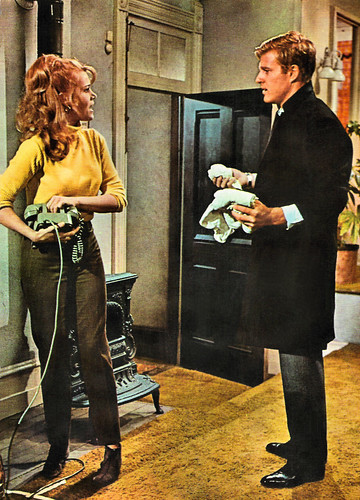
Romanian postcard by Casa Filmului Acin, no. 633. Jane Fonda and Robert Redford in Barefoot in the Park (Gene Saks, 1967).
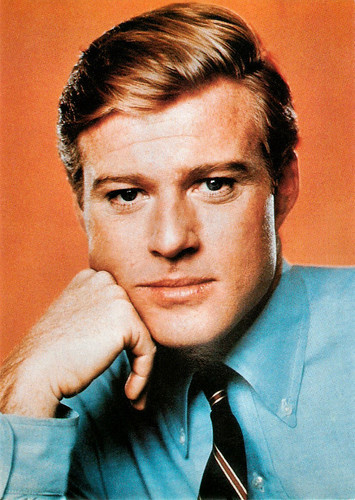
French postcard by Editions F. Nugeron, no. Stars 69. Photo: J. Ritchie.
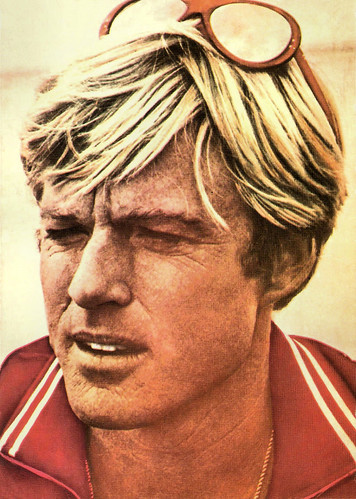
Romanian postcard by Casa Filmului Acin.
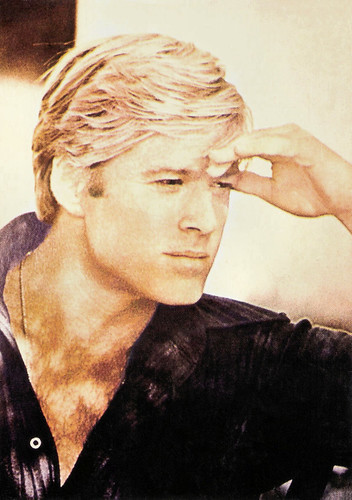
Romanian postcard by Casa Filmului Acin.
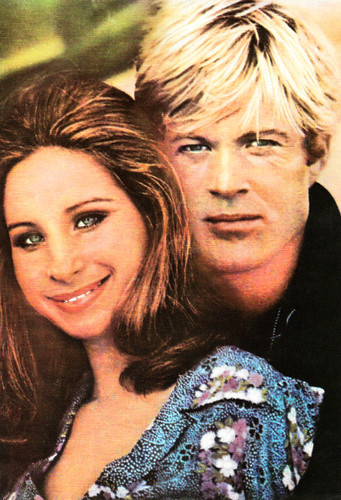
Romanian postcard by Casa Filmului Acin, no. 491. Photo: Barbra Streisand and Robert Redford in The Way We Were (Sydney Pollack, 1973).
Against the stereotype of the blond 'All American'
After this initial success, Robert Redford became concerned about his stereotype image of the blond 'All American'. At the age of 32, he found the property he was looking for in Butch Cassidy and the Sundance Kid (George Roy Hill, 1969), scripted by William Goldman. For the first time, he was teamed with Paul Newman. In the film, he played the outlaw known as the Sundance Kid while Newman portrayed Butch Cassidy. The two proved to be a dynamic duo onscreen and forged a lasting friendship, with the film enjoying both critical and commercial success. Butch Cassidy and the Sundance Kid made him a major bankable star.
Redford sought out more challenging fare and avoided trading on his sex appeal. Critical and box office hits were Jeremiah Johnson (Sydney Pollack, 1972), the hugely popular period drama The Way We Were (Sydney Pollack, 1973) with Barbra Streisand, and the blockbuster crime caper The Sting (George Roy Hill, 1973), the biggest hit of his career, for which Redford received his first Oscar nomination.
Between 1974 and 1976, exhibitors voted Redford as Hollywood's top box-office name with such hits as The Great Gatsby (Jack Clayton, 1974) and the CIA thriller Three Days of the Condor (Sydney Pollack, 1975) with Faye Dunaway .
The popular and acclaimed All the President's Men (Alan J. Pakula, 1976), scripted once again by William Goldman, was a landmark film for Redford. He and Dustin Hoffman played reporters Bob Woodward and Carl Bernstein in an acclaimed drama about the Watergate scandal. He was also the executive producer and the film's serious subject matter and its attempt to create a realistic portrayal of journalism, reflected the actor's offscreen concerns for political causes.
Redford also appeared in the war film A Bridge Too Far (Richard Attenborough, 1977) before starring in the prison drama Brubaker (Stuart Rosenberg, 1980), playing a prison warden attempting to reform the system, and the baseball drama The Natural (Barry Levinson, 1984).
With his enormous salaries, he acquired Utah property, which he transformed into a ranch and the Sundance ski resort. In 1980, he established the Sundance Institute for aspiring filmmakers. Its annual film festival has now become one of the world's most influential.

French postcard by INPI. Photo: Robert Redford and Paul Newman in Butch Cassidy and the Sundance Kid (George Roy Hill, 1969).
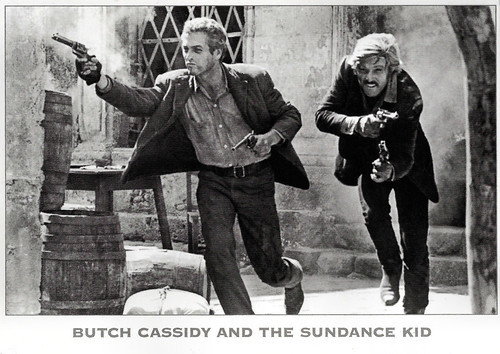
British postcard in the Film & Music Personalities series by Pyramid, Leicester, no. PC 2038. Paul Newman and Robert Redford in Butch Cassidy and the Sundance Kid (George Roy Hill, 1969).
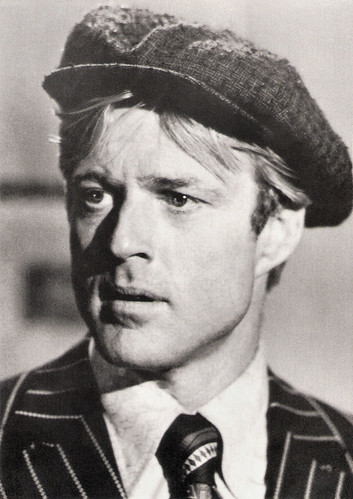
American postcard, no. MPC 903-50. Photo: Robert Redford in The Sting (George Roy Hill, 1973).
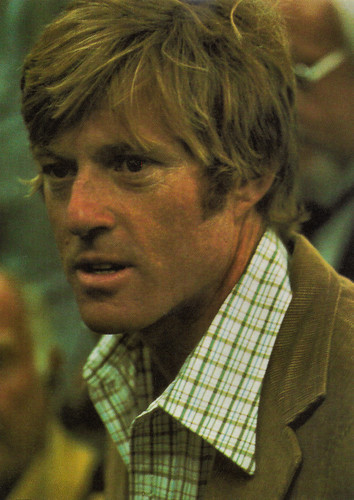
British postcard by Heroes, London, no. PC 593. Photo: Robert Redford in All the President's Men (Alan J. Pakula, 1976).
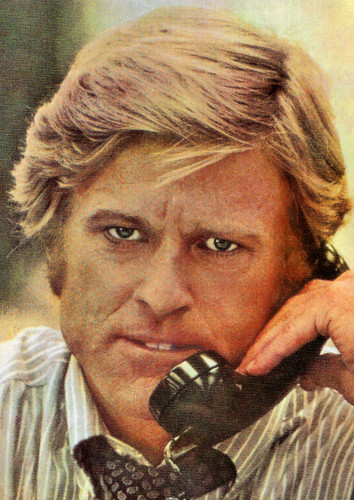
Romanian postcard by Casa Filmului Acin, no. 43080. Photo: Robert Redford in All the President's Men (Alan J. Pakula, 1976).
A newfound focus on directing
Robert Redford continued his involvement in mainstream Hollywood movies, though with a newfound focus on directing. The first film he directed was Ordinary People (1980), which starred Mary Tyler Moore, Donald Sutherland, and Timothy Hutton. The film followed the disintegration of an upper-class American family after the death of a son and was one of the most critically and publicly acclaimed films of the decade. It won a number of Oscars, including the Academy Awards for Best Picture and Best Director, Redford's first Oscar.
His follow-up directorial project, The Milagro Beanfield War (1987), failed to generate the same level of attention. Out of Africa (Sydney Pollack, 1985), with Redford and Meryl Streep , became an enormous critical and box office success and won seven Oscars including Best Picture. It was Redford's biggest success of the decade and Redford and Pollack's most successful film together.
Redford continued as a major star throughout the 1990s and 2000s. His third film as a director, A River Runs Through It (1992) with the young Brad Pitt was a mainstream success. Then, he starred in Indecent Proposal (Adrian Lyne, 1993) as a millionaire businessman who tests a couple's (Demi Moore and Woody Harrelson) morals. It became one of the year's biggest hits.
His film Quiz Show (Robert Redford, 1994), starring Ralph Fiennes and Rob Morrow, explored the real-life corruption of the 1950s game shows. It earned him another Oscar nomination for Best Director. He co-starred with Michelle Pfeiffer in the newsroom romance Up Close & Personal (Jon Avnet, 1996), and with Kristin Scott Thomas in The Horse Whisperer (1998), which he also directed and produced.
Redford continued to work in films with political contexts, such as Havana (Sydney Pollack, 1990), playing Jack Weil, a professional gambler in 1959 Cuba during the Revolution, as well as the caper Sneakers (Phil Alden Robinson, 1992), with River Phoenix. He reteamed with Brad Pitt for Spy Game (Tony Scott, 2001).
Redford stepped back into producing with The Motorcycle Diaries (Walter Salles, 2004), a coming-of-age road film about a young medical student, Ernesto 'Che' Guevera, and his friend Alberto Granado. He reteamed with Meryl Streep 22 years after they starred in Out of Africa, for his personal project, the political drama Lions for Lambs (Robert Redford, 2007), which also starred Tom Cruise . The film was a commercial and critical disappointment.
Redford gave an impressive performance in All Is Lost (J.C. Chandor, 2013) as a man caught in dire, life-threatening circumstances, alone sailing at sea. He received very high acclaim for his role in the film, in which he is its only cast member and has almost no dialogue.
Next, he appeared in the Marvel Studios superhero film Captain America: The Winter Soldier (Anthony Russo, Joe Russo, 2014) playing Alexander Pierce. More recently, he appeared in A Walk in the Woods (Ken Kwapis, 2015) with Nick Nolte and Emma Thompson, and Truth (James Vanderbilt, 2015) as real-world TV journalist Dan Rather and 60 Minutes' controversial coverage of George W. Bush's military service. Since then, he played in The Discovery (Charlie McDowell, 2017) with Mary Steenburgen, and Avengers: Endgame (Anthony Russo, Joe Russo, 2019) with Robert Downey Jr.
In 2018, Redford announced that his starring role in the upcoming crime comedy The Old Man & the Gun (David Lowery, 2018) would bring his long and distinguished acting career to a close. The film is based on the true story of Forrest Tucker, from his audacious escape from San Quentin at the age of 70 to an unprecedented string of heists that confounded authorities and enchanted the public. The Little Songbird at IMDb : "Redford piles on the likeability and charm with effortless ease, really terrific work in a performance that dominates in a good way the film, and some of his best in years."
Between 1958 and 1985, Robert Redford was married to Lola Van Wagenen. The couple had four children: Scott Anthony (1959 - he died of sudden infant death syndrome, aged 2½ months), painter Shauna Jean Redford (1960), writer and producer David 'Jamie' James (1962), and director, and producer Amy Hart Redford (1970). Redford has seven grandchildren. In 2009, Redford married his long-time partner, German painter Sibylle Szaggars.
The Academy of Motion Picture Arts and Sciences recognised his contributions to the medium in 2001 with an honorary award for serving as an "inspiration to independent and innovative filmmakers everywhere." In 2011, Alfred A. Knopf published 'Robert Redford: The Biography' by Michael Feeney Callan, written over fifteen years with Redford's input, and drawn from his personal papers and diaries. In 2016, Redford was awarded the Presidential Medal of Freedom by President Barack Obama.
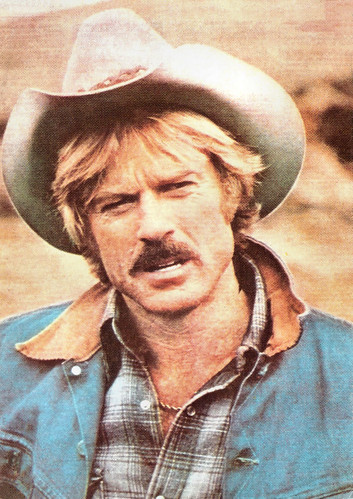
Romanian postcard by Casa Filmului Acin. Photo: Robert Redford in The Electric Horseman (Sydney Pollack, 1979).
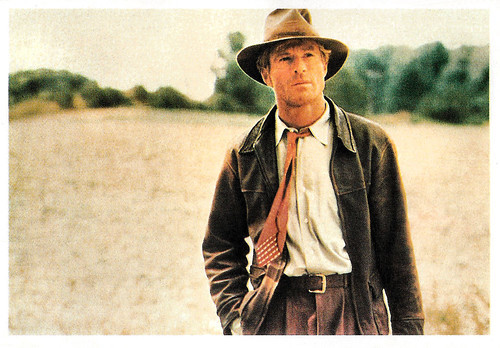
French postcard by Ébullitions, no. 15. Robert Redford in Out of Africa (Sydney Pollack, 1985).
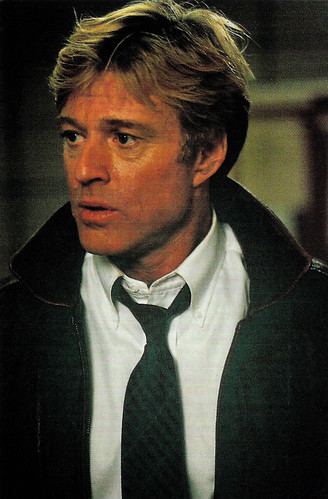
Dutch collectors card, 1987. Photo: Robert Redford in Legal Eagles (Ivan Reitman, 1986).
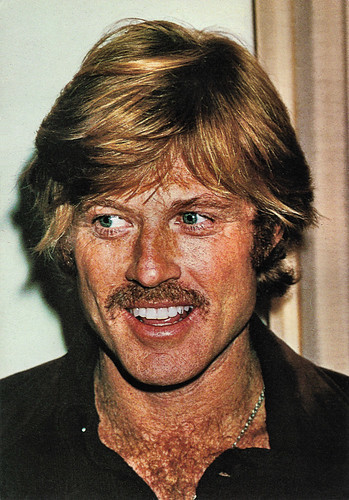
Italian postcard by Photocards Edizioni Beatrice D'Este / Arti Grafiche Riccordi S.p.A, Milano, no. 20166.
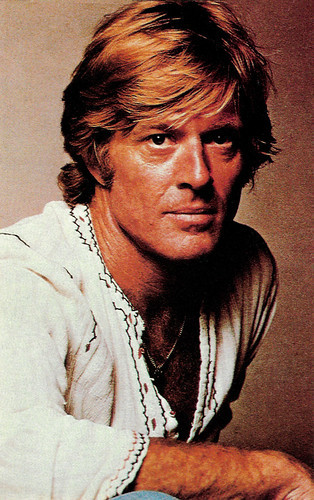
American postcard by Coral-Lee, Rancho Cardova, CA, no. CL/Personality # 119.
Sources: (IMDb), The Little Songbird (IMDb), Biography.com, Wikipedia, and .

Canadian postcard by Fan Club, no. PC8.

American postcard by Fan Club Post Cards, New York, N.Y., no. PC 22. Paul Newman and Robert Redford in Butch Cassidy and the Sundance Kid (George Roy Hill, 1969).

French postcard in the Collection 'Portraits de Cinema' by Editions Admira, Aix-en-Provence, Serie 6, no. 1 / no. PHN 863. Photo: SNAP Photo / Cosmos. Robert Redford in The Sting (George Roy Hill, 1973).

British postcard by Star-Graphics, London, no. S 90. Sent by mail in 1997. Robert Redford in The Electric Horseman (Sydney Pollack, 1979).

Italian postcard by Vitorius Roma, no. VR 499. Robert Redford in Out of Africa (Sydney Pollack, 1985).
Jane Fonda's stuffy newlywed husband
Charles Robert Redford Jr. was born in Santa Monica, California in 1936. His parents were Martha W. (Hart) and Charles Robert Redford, Sr., a milkman who later worked as an oil company accountant.
Redford's family moved to Van Nuys, California, while his father worked in El Segundo. He attended Van Nuys High School and was interested in art and sports. In 1954, Redford graduated from Van Nuys High School. But his mother died in 1955 from septicemia, and a deeply grieving Redford felt lost emotionally.
Redford won a baseball scholarship to the University of Colorado, but he did not distinguish himself as an athlete there. Instead, "I became the campus drunk and blew out before I could ever get going," he told People magazine in a 1998 interview. After one and a half years, he decided to become an artist and moved to Europe.
His time travelling through Europe was an eye-opening experience for the young Redford, who lived the life of a bohemian. When he returned to America a year and a half later, he was much more focused on my country culturally and politically. He decided on a career as a theatrical designer in New York City, but enrolling at the Pratt Institute and then the American Academy of Dramatic Arts, switching from design to acting.
In 1959, Redford's acting career began on stage, making his Broadway debut with a small role in the comedy 'Tall Story'. It was followed by parts in 'The Highest Tree' (1959) and 'Sunday in New York' (1961).
On TV, he appeared as a guest star on numerous programs, including Maverick (1960), Perry Mason (1960), The Twilight Zone (1962), and The Untouchables (1963). Redford earned an Emmy nomination as Best Supporting Actor for his performance in The Voice of Charlie Pont (Robert Ellis Miller, 1962), starring Bradford Dillman.
Redford made his screen debut in War Hunt (Denis Sanders, 1962), set during the last days of the Korean War. This film also marked the acting debut of director Sydney Pollack, with whom Redford would collaborate on seven films.
His biggest Broadway success was as the stuffy newlywed husband of Elizabeth Ashley in Neil Simon's 'Barefoot in the Park' (1963), directed by Mike Nichols. After this smash hit, he was cast in larger film roles. In the war comedy Situation Hopeless ... But Not Serious (Gottfried Reinhardt, 1965) with Alec Guinness , he played a soldier who has to spend years of his life hiding behind enemy lines.
In Inside Daisy Clover (Robert Mulligan, 1965), he played a bisexual movie star who marries starlet Natalie Wood. It won him a Golden Globe for the best new star. A success was This Property Is Condemned (Sydney Pollack, 1966), again with Natalie Wood. The same year, he co-starred with Jane Fonda in The Chase (Arthur Penn, 1966), also with Marlon Brando . Fonda and Redford were paired again in the film version of Barefoot in the Park (Gene Saks, 1967) and were again co-stars much later in The Electric Horseman (Sydney Pollack, 1979).

Romanian postcard by Casa Filmului Acin, no. 633. Jane Fonda and Robert Redford in Barefoot in the Park (Gene Saks, 1967).

French postcard by Editions F. Nugeron, no. Stars 69. Photo: J. Ritchie.

Romanian postcard by Casa Filmului Acin.

Romanian postcard by Casa Filmului Acin.

Romanian postcard by Casa Filmului Acin, no. 491. Photo: Barbra Streisand and Robert Redford in The Way We Were (Sydney Pollack, 1973).
Against the stereotype of the blond 'All American'
After this initial success, Robert Redford became concerned about his stereotype image of the blond 'All American'. At the age of 32, he found the property he was looking for in Butch Cassidy and the Sundance Kid (George Roy Hill, 1969), scripted by William Goldman. For the first time, he was teamed with Paul Newman. In the film, he played the outlaw known as the Sundance Kid while Newman portrayed Butch Cassidy. The two proved to be a dynamic duo onscreen and forged a lasting friendship, with the film enjoying both critical and commercial success. Butch Cassidy and the Sundance Kid made him a major bankable star.
Redford sought out more challenging fare and avoided trading on his sex appeal. Critical and box office hits were Jeremiah Johnson (Sydney Pollack, 1972), the hugely popular period drama The Way We Were (Sydney Pollack, 1973) with Barbra Streisand, and the blockbuster crime caper The Sting (George Roy Hill, 1973), the biggest hit of his career, for which Redford received his first Oscar nomination.
Between 1974 and 1976, exhibitors voted Redford as Hollywood's top box-office name with such hits as The Great Gatsby (Jack Clayton, 1974) and the CIA thriller Three Days of the Condor (Sydney Pollack, 1975) with Faye Dunaway .
The popular and acclaimed All the President's Men (Alan J. Pakula, 1976), scripted once again by William Goldman, was a landmark film for Redford. He and Dustin Hoffman played reporters Bob Woodward and Carl Bernstein in an acclaimed drama about the Watergate scandal. He was also the executive producer and the film's serious subject matter and its attempt to create a realistic portrayal of journalism, reflected the actor's offscreen concerns for political causes.
Redford also appeared in the war film A Bridge Too Far (Richard Attenborough, 1977) before starring in the prison drama Brubaker (Stuart Rosenberg, 1980), playing a prison warden attempting to reform the system, and the baseball drama The Natural (Barry Levinson, 1984).
With his enormous salaries, he acquired Utah property, which he transformed into a ranch and the Sundance ski resort. In 1980, he established the Sundance Institute for aspiring filmmakers. Its annual film festival has now become one of the world's most influential.

French postcard by INPI. Photo: Robert Redford and Paul Newman in Butch Cassidy and the Sundance Kid (George Roy Hill, 1969).

British postcard in the Film & Music Personalities series by Pyramid, Leicester, no. PC 2038. Paul Newman and Robert Redford in Butch Cassidy and the Sundance Kid (George Roy Hill, 1969).

American postcard, no. MPC 903-50. Photo: Robert Redford in The Sting (George Roy Hill, 1973).

British postcard by Heroes, London, no. PC 593. Photo: Robert Redford in All the President's Men (Alan J. Pakula, 1976).

Romanian postcard by Casa Filmului Acin, no. 43080. Photo: Robert Redford in All the President's Men (Alan J. Pakula, 1976).
A newfound focus on directing
Robert Redford continued his involvement in mainstream Hollywood movies, though with a newfound focus on directing. The first film he directed was Ordinary People (1980), which starred Mary Tyler Moore, Donald Sutherland, and Timothy Hutton. The film followed the disintegration of an upper-class American family after the death of a son and was one of the most critically and publicly acclaimed films of the decade. It won a number of Oscars, including the Academy Awards for Best Picture and Best Director, Redford's first Oscar.
His follow-up directorial project, The Milagro Beanfield War (1987), failed to generate the same level of attention. Out of Africa (Sydney Pollack, 1985), with Redford and Meryl Streep , became an enormous critical and box office success and won seven Oscars including Best Picture. It was Redford's biggest success of the decade and Redford and Pollack's most successful film together.
Redford continued as a major star throughout the 1990s and 2000s. His third film as a director, A River Runs Through It (1992) with the young Brad Pitt was a mainstream success. Then, he starred in Indecent Proposal (Adrian Lyne, 1993) as a millionaire businessman who tests a couple's (Demi Moore and Woody Harrelson) morals. It became one of the year's biggest hits.
His film Quiz Show (Robert Redford, 1994), starring Ralph Fiennes and Rob Morrow, explored the real-life corruption of the 1950s game shows. It earned him another Oscar nomination for Best Director. He co-starred with Michelle Pfeiffer in the newsroom romance Up Close & Personal (Jon Avnet, 1996), and with Kristin Scott Thomas in The Horse Whisperer (1998), which he also directed and produced.
Redford continued to work in films with political contexts, such as Havana (Sydney Pollack, 1990), playing Jack Weil, a professional gambler in 1959 Cuba during the Revolution, as well as the caper Sneakers (Phil Alden Robinson, 1992), with River Phoenix. He reteamed with Brad Pitt for Spy Game (Tony Scott, 2001).
Redford stepped back into producing with The Motorcycle Diaries (Walter Salles, 2004), a coming-of-age road film about a young medical student, Ernesto 'Che' Guevera, and his friend Alberto Granado. He reteamed with Meryl Streep 22 years after they starred in Out of Africa, for his personal project, the political drama Lions for Lambs (Robert Redford, 2007), which also starred Tom Cruise . The film was a commercial and critical disappointment.
Redford gave an impressive performance in All Is Lost (J.C. Chandor, 2013) as a man caught in dire, life-threatening circumstances, alone sailing at sea. He received very high acclaim for his role in the film, in which he is its only cast member and has almost no dialogue.
Next, he appeared in the Marvel Studios superhero film Captain America: The Winter Soldier (Anthony Russo, Joe Russo, 2014) playing Alexander Pierce. More recently, he appeared in A Walk in the Woods (Ken Kwapis, 2015) with Nick Nolte and Emma Thompson, and Truth (James Vanderbilt, 2015) as real-world TV journalist Dan Rather and 60 Minutes' controversial coverage of George W. Bush's military service. Since then, he played in The Discovery (Charlie McDowell, 2017) with Mary Steenburgen, and Avengers: Endgame (Anthony Russo, Joe Russo, 2019) with Robert Downey Jr.
In 2018, Redford announced that his starring role in the upcoming crime comedy The Old Man & the Gun (David Lowery, 2018) would bring his long and distinguished acting career to a close. The film is based on the true story of Forrest Tucker, from his audacious escape from San Quentin at the age of 70 to an unprecedented string of heists that confounded authorities and enchanted the public. The Little Songbird at IMDb : "Redford piles on the likeability and charm with effortless ease, really terrific work in a performance that dominates in a good way the film, and some of his best in years."
Between 1958 and 1985, Robert Redford was married to Lola Van Wagenen. The couple had four children: Scott Anthony (1959 - he died of sudden infant death syndrome, aged 2½ months), painter Shauna Jean Redford (1960), writer and producer David 'Jamie' James (1962), and director, and producer Amy Hart Redford (1970). Redford has seven grandchildren. In 2009, Redford married his long-time partner, German painter Sibylle Szaggars.
The Academy of Motion Picture Arts and Sciences recognised his contributions to the medium in 2001 with an honorary award for serving as an "inspiration to independent and innovative filmmakers everywhere." In 2011, Alfred A. Knopf published 'Robert Redford: The Biography' by Michael Feeney Callan, written over fifteen years with Redford's input, and drawn from his personal papers and diaries. In 2016, Redford was awarded the Presidential Medal of Freedom by President Barack Obama.

Romanian postcard by Casa Filmului Acin. Photo: Robert Redford in The Electric Horseman (Sydney Pollack, 1979).

French postcard by Ébullitions, no. 15. Robert Redford in Out of Africa (Sydney Pollack, 1985).

Dutch collectors card, 1987. Photo: Robert Redford in Legal Eagles (Ivan Reitman, 1986).

Italian postcard by Photocards Edizioni Beatrice D'Este / Arti Grafiche Riccordi S.p.A, Milano, no. 20166.

American postcard by Coral-Lee, Rancho Cardova, CA, no. CL/Personality # 119.
Sources: (IMDb), The Little Songbird (IMDb), Biography.com, Wikipedia, and .
Published on October 31, 2020 23:00
Sean Connery (1930-2020)
Scottish superstar Sean Connery (1930-2020) has died today, 31 October 2020. He is best known as the original secret agent 007, starring in seven James Bond films between 1962 and 1983. His film career also included such notable films as Marnie (1964), The Name of the Rose (1986), The Untouchables (1987), and Indiana Jones and the Last Crusade (1989). Connery won an Academy Award, a Golden Globe, and also a BAFTA Award. He was 90.
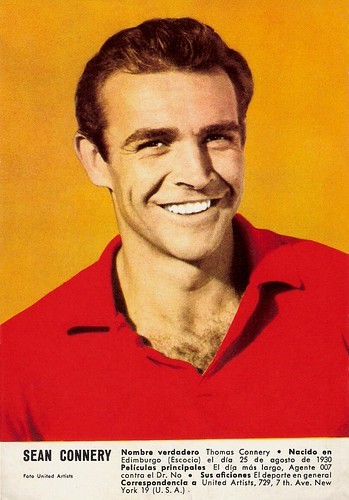
Spanish postcard. Photo: United Artists.
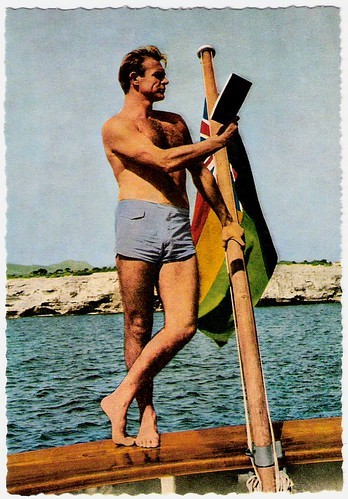
Vintage German postcard. Photo: P.A. Reuter.
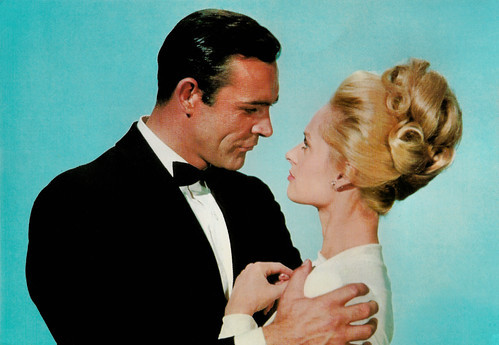
Spanish postcard by Postal Oscarcolor, no. 13. Sean Connery and Tippi Hedren in Marnie (Alfred Hitchcock, 1964).
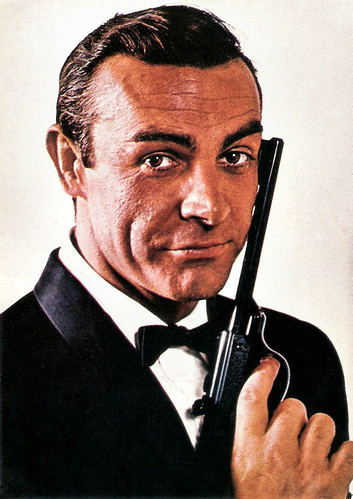
French postcard by Editions F. Nugeron, no. Star57.
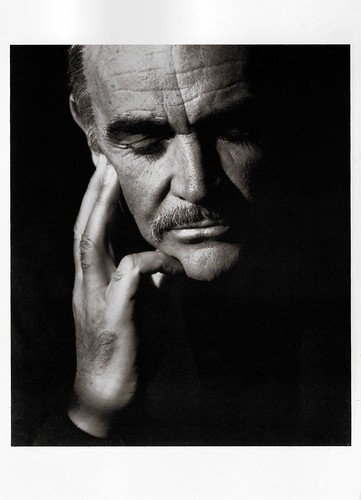
American postcard by Fotofolio, New York, N.Y., no. HR 62. Photo: Herb Ritts. Caption: Sean Connery, Hollywood, 1989.
Mr. Universe
Thomas Sean Connery was born in Edinburgh, Scotland, UK, in 1930. He was the son of Euphemia 'Effie' Connery-Maclean, a cleaning woman, and Joseph Connery, a factory worker, and truck driver. He had a younger brother, Neil.
At 13, he left school and worked as a milkman in Edinburgh with St. Cuthbert's Co-operative Society. In 1947 he joined the Royal Navy, but after three years he was discharged on medical grounds because of severe stomach ulcers. First, he returned to the co-op, then worked as a lorry driver, an artist's model for the Edinburgh College of Art, and as a coffin polisher.
Looking to pick up some extra money, he helped out backstage at the King's Theatre around Christmas of 1951. He became interested in the proceedings, and got a job as a singing and dancing sailor in the chorus of 'South Pacific'. More bit parts followed.
He also took up bodybuilding as a hobby. His official website claims he was third in the 1950 Mr. Universe contest, other sources place him in the 1953 competition.
He made his film debut as an extra in the musical Lilacs in the Spring (Herbert Wilcox, 1955) with Anna Neagle and Errol Flynn .
No Road Back (Montgomery Tully, 1957) was Sean's first major film role, and it was followed by such films as Hell Drivers (Cy Endfield, 1957) starring Stanley Baker , Darby O'Gill and the Little People (Robert Stevenson, 1959), and The Frightened City (John Lemont, 1961) with Herbert Lom .
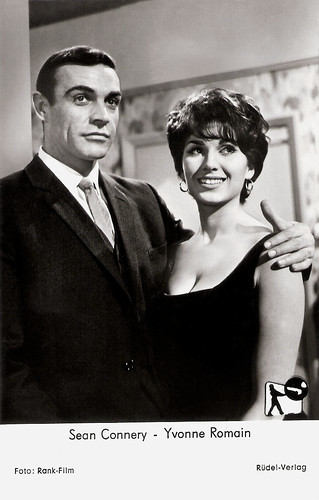
German postcard by Rüdel-Verlag, Hamburg-Bergedorf, no. 4258. Photo: Rank. Sean Connery and Yvonne Romain in The Frightened City (John Lemont, 1961).
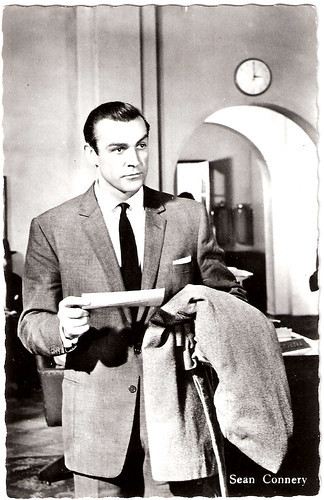
Dutch postcard. Sean Connery in From Russia with Love (Terence Young, 1963).
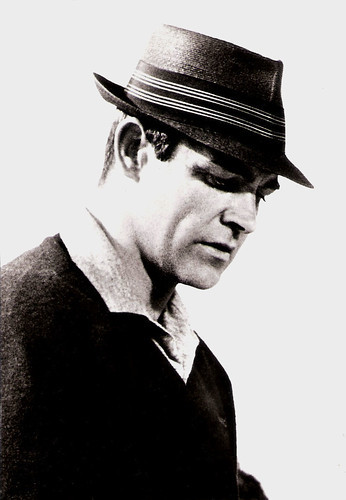
Dutch card, no. AX 6263. Publicity still for Goldfinger (Guy Hamilton, 1964).
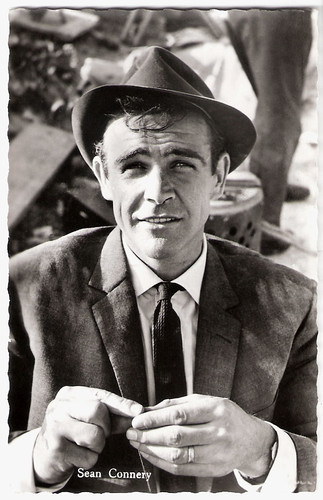
Dutch postcard.
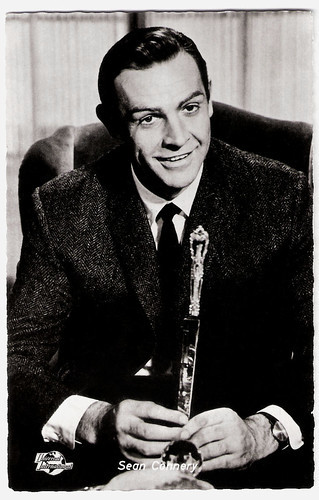
German postcard by Kolibri-Verlag, Minden/Westf., no. 2268. Photo: Universal-International. Sean Connery in Marnie (Alfred Hitchcock, 1964).
Possessive Gangster Boyfriend
Sean Connery played another early film part in Another Time, Another Place (Lewis Allen, 1958) as Lana Turner's romantic interest.
During filming, Turner's possessive gangster boyfriend, Johnny Stompanato, believed she was having an affair with Connery. He stormed onto the set and pointed a gun at Connery, only to have Connery disarm Stompanato and knock him flat on his back.
Shortly thereafter, Stompanato met his end at the hands of Lana Turner 's teenage daughter, Cheryl Crane. The film was released four months ahead of schedule to capitalise on the murder.
Meanwhile, Connery also appeared regularly on television. He played the leads in an ITV Teleplay of Anna Christie (1957) with his later wife Diane Cilento, and in a Canadian TV adaptation of Macbeth (Paul Almond, 1961).
He also had a prominent role in a BBC production of Anna Karenina (Rudolph Cartier, 1961), in which he co-starred with Claire Bloom .
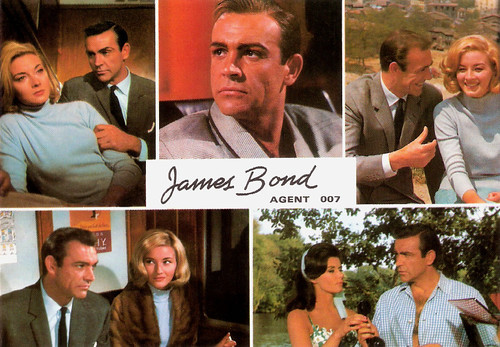
British postcard by Klasik Kards, London, no. 1543. Photos: publicity stills for From Russia with Love (Terence Young, 1963) with Daniela Bianchi and Martine Beswick.
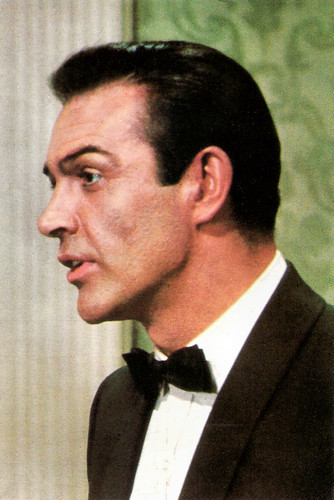
Spanish postcard by Postal Oscarcolor, no. 12.
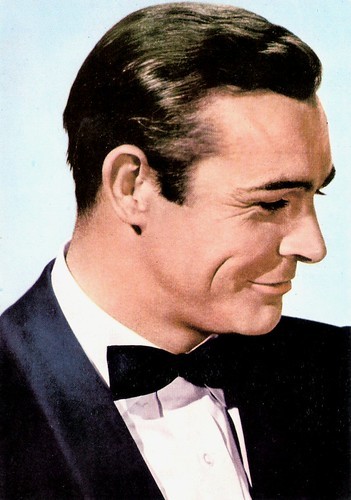
Spanish postcard by Postal Oscarcolor, no. 356, Dep Legal B 17-165-VIII.
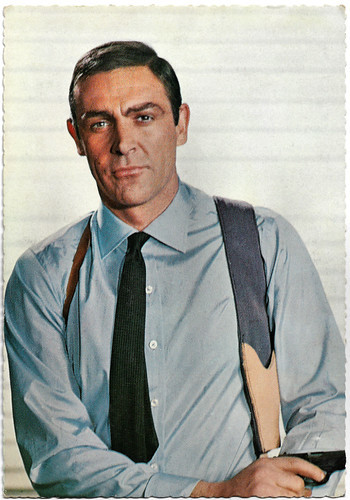
French postcard by E.D.U.G., no. 454. Photo: Lynx. Sean Connery in Thunderball (Terence Young, 1965).
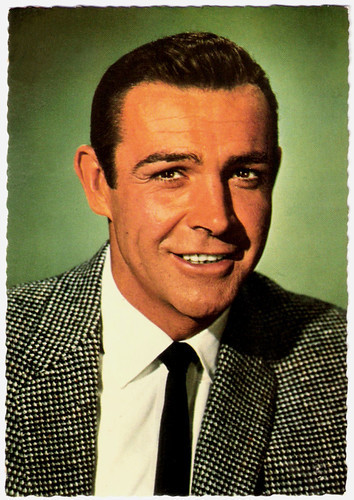
French postcard by E.D.U.G.
Suave and Sophisticated
Sean Connery's big breakthrough came in the role of the suave and sophisticated secret agent James Bond.
He played 007 in seven Bond films: Dr. No (Terence Young, 1962), From Russia with Love (Terence Young, 1963), Goldfinger (Guy Hamilton, 1964), Thunderball (Terence Young, 1965), You Only Live Twice (Lewis Gilbert, 1967), Diamonds Are Forever (Guy Hamilton, 1971), and finally Never Say Never Again (Irvin Kershner, 1983).
All seven films were big box-office hits, if not critically acclaimed as well. Among his many Bond girls were Ursula Andress , Daniela Bianchi , Honor Blackman , Shirley Eaton, Claudine Auger , Karin Dor , Lana Wood, Jill St. John, Barbara Carrera, and Kim Basinger .
At first, James Bond's creator, Ian Fleming, doubted the casting, saying, "He's not what I envisioned of James Bond looks" and "I’m looking for Commander Bond and not an overgrown stunt-man," adding that the muscular Connery was unrefined.
However, Fleming's girlfriend told him Connery had the requisite sexual charisma. Fleming changed his mind after the successful Dr. No premiere. He was so impressed, he created a half-Scottish, half-Swiss heritage for the literary James Bond in the later novels.
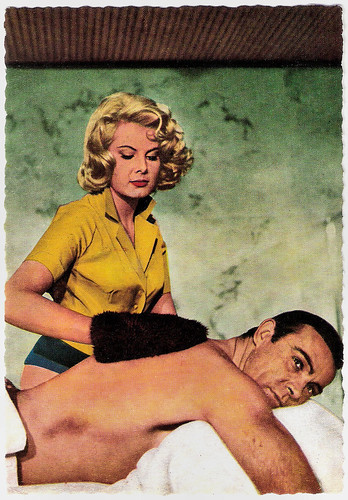
German postcard. Photo: dpa. Sean Connery and Molly Peters in Thunderball (Terence Young, 1965).
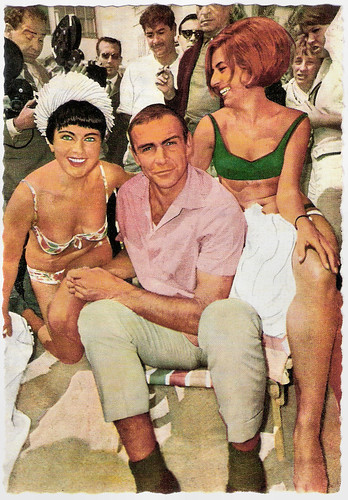
Vintage postcard. Photo: fpa.
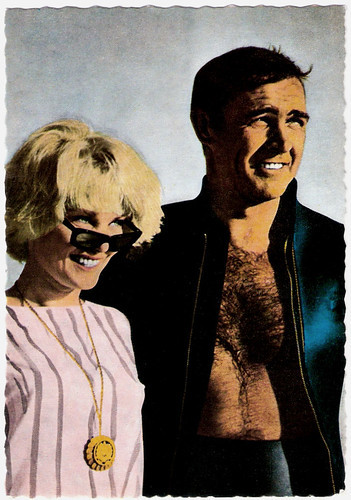
German postcard. Photo: dpa. Publicity still for Thunderball (Terence Young, 1965).
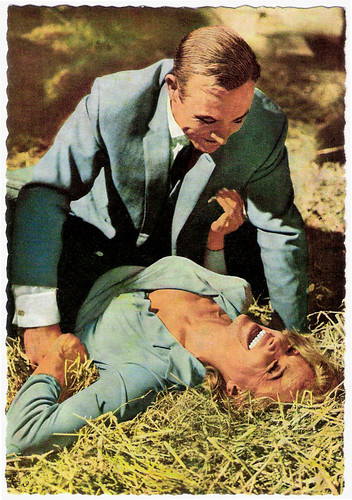
German postcard. Photo: P.A. Reuter. Publicity still for Goldfinger (Guy Hamilton, 1964).
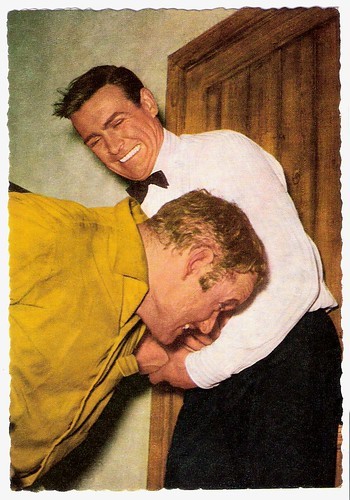
German postcard. Photo: P.A. Reuter. Sean Connery as James Bond.
Stylistic Tutelage
Sean Connery's portrayal of Bond owes much to stylistic tutelage from director Terence Young, polishing the actor while using his physical grace and presence for the action.
While making the Bond films, Connery also starred in other acclaimed films such as The Longest Day (Ken Annakin, Andrew Marton, Bernhard Wicki, 1962), the romantic melodrama Woman of Straw (Basil Dearden, 1964) with Gina Lollobrigida , Marnie (Alfred Hitchcock, 1964), the excellent war film The Hill (Sidney Lumet, 1965), and the Western Shalako (Edward Dmytryk, 1968) with Brigitte Bardot.
Two of his most moving films were The Offence (Sidney Lumet, 1972) and the wise and romantic version of the Robin Hood legend, Robin and Marian (Richard Lester, 1976) with Audrey Hepburn .
Apart from these films and The Man Who Would Be King (John Huston, 1975) with Michael Caine , and The Wind and the Lion (John Milius, 1975), most of Connery's successes in the seventies were as part of ensemble casts in films such as the Agatha Christie mystery Murder on the Orient Express (Sidney Lumet, 1974) and the war epic A Bridge Too Far (Richard Attenborough, 1977).
Four years later, Sean Connery appeared in the Sci-Fi comedy Time Bandits (Terry Gilliam, 1981) as King Agamemnon. The casting choice derives from a joke Michael Palin included in the script, in which he describes the character as being 'Sean Connery — or someone of equal but cheaper stature'. However, when shown the script, Connery was happy to play the supporting role.
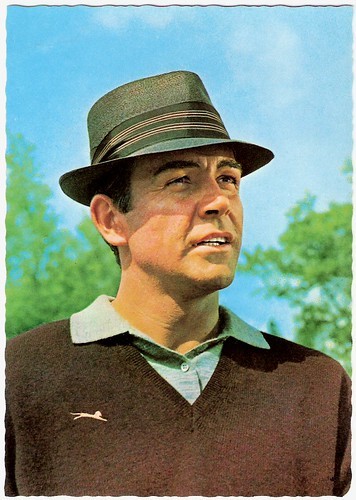
West-German postcard by ISV, no. H 119.
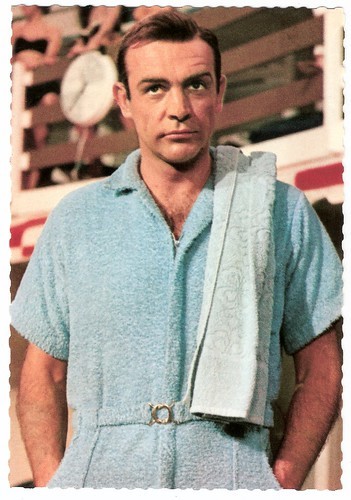
West-German postcard by ISV, no. H 123.
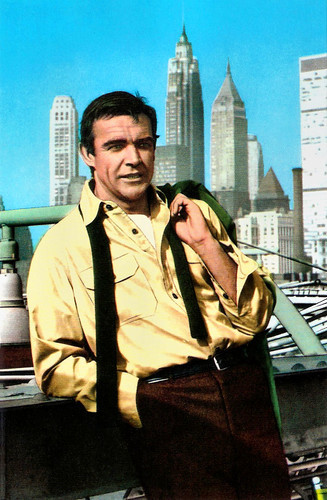
West-German postcard, no. 902/413.
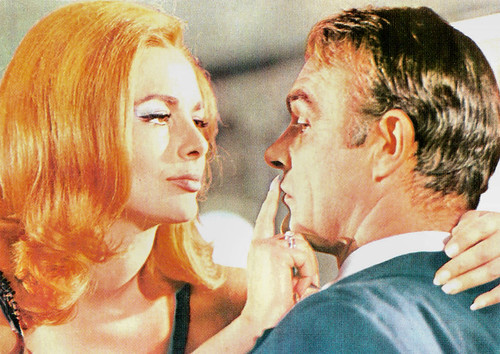
Romanian postcard by Casa Filmului Acin. Luciana Paluzzi and Sean Connery in Thunderball (Terence Young, 1965).
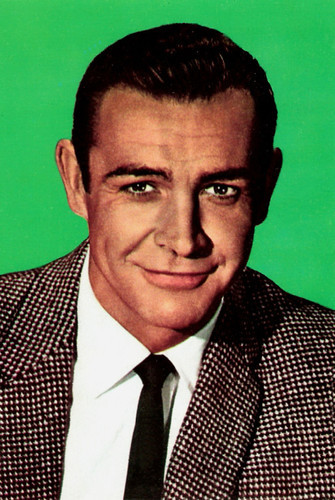
Israelian postcard by Editions de Luxe, no. 104.
A Nightmarish Experience
Never Say Never Again in 1983 was a nightmarish experience for him because of difficulties with the production staff.
After this experience and the following court case, Sean Connery became unhappy with the major studios and for two years did not make any films.
He returned to the screen in the successful European production Der Name der Rose/The Name of the Rose (Jean-Jacques Annaud, 1986), for which he won a BAFTA award.
That same year, a supporting role in Highlander (Russell Mulcahy, 1986) with Christophe(r) Lambert also showcased his ability to play older mentors to younger leads, which would become a recurring role in many of his later films.
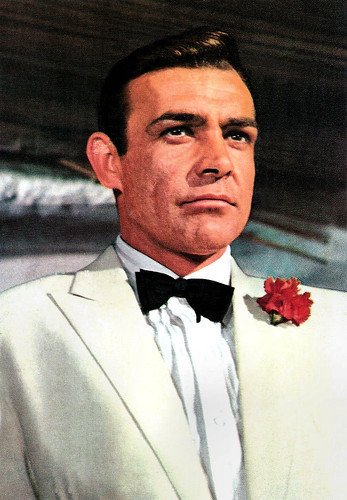
British postcard by Klasik Kards, London, no. 1506. Photo: Sean Connery in Goldfinger (Guy Hamilton, 1964).
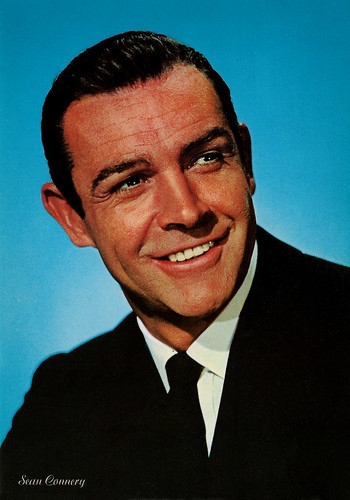
Vintage postcard.
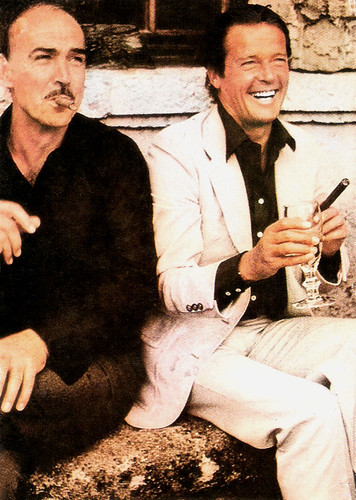
Romanian postcard by Casa Filmului Acin. With Roger Moore.
Italian postcard by Vittorius, Roma (Rome), no. VR 503. Sent by mail in Germany in 1997. Photo: publicity still for Der Name der Rose/The Name of the Rose (Jean-Jacques Annaud, 1986).
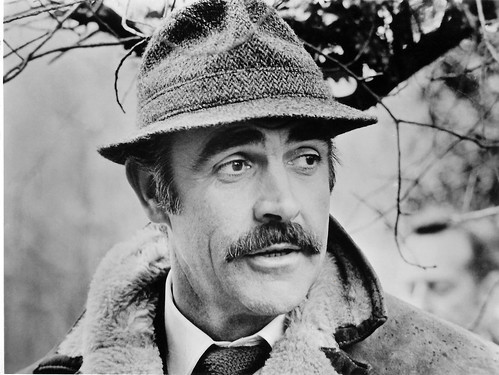
Vintage press photo.
Hard-nosed Veteran Cop
The following year, Sean Connery's acclaimed performance as a hard-nosed veteran cop in The Untouchables (Brian de Palma, 1987) earned him the Oscar for Best Supporting Actor, his sole nomination throughout his career.
Subsequent box-office hits included Indiana Jones and the Last Crusade (Steven Spielberg, 1989), The Hunt for Red October (John McTiernan, 1990), where he was reportedly called in at two weeks' notice, The Rock (Michael Bay, 1996), and Entrapment (Jon Amiel, 1999) with Catherine Zeta-Jones . The latter two he also produced.
Both Last Crusade and The Rock alluded to his James Bond days. Steven Spielberg and George Lucas wanted 'the father of Indiana Jones' to be Connery since Bond directly inspired the Indiana Jones series, while his character in The Rock, John Patrick Mason, was a British secret service agent imprisoned since the 1960s.
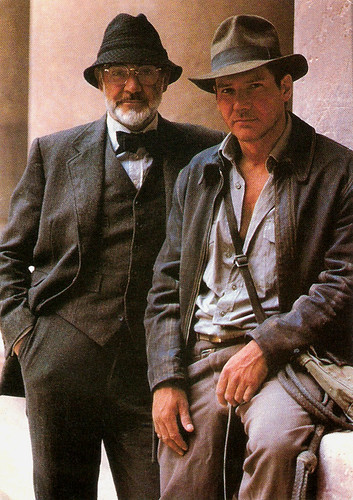
French postcard by Editions Nugeron, no. Star 206. Photo: Lucasfilm. With Harrison Ford in Indiana Jones and the Last Crusade (Steven Spielberg, 1989).
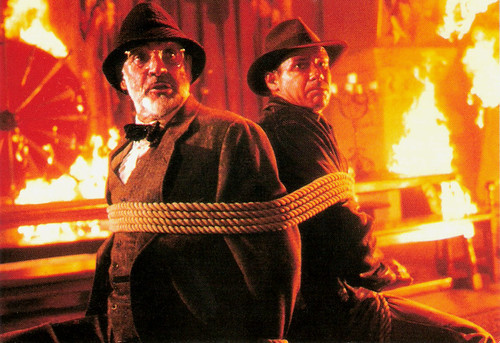
French postcard by Editions Nugeron, no. 198. Photo: Lucasfilm. With Harrison Ford in Indiana Jones and the Last Crusade (Steven Spielberg, 1989).
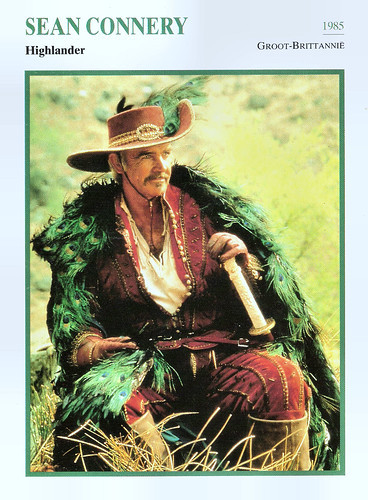
Dutch collectors card in the series 'Filmsterren: een Portret' by Edito-Service, 1993. Photo: A. Pélé / Stills. Publicity still for Highlander (Russell Mulcahy, 1985).
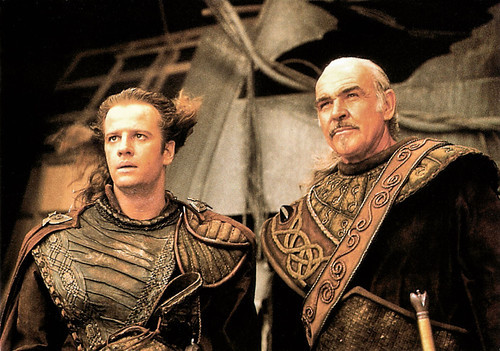
French postcard by Sonis, no. C. 160. Photo: Christopher Lambert and Sean Connery in Highlander II: The Quickening (Russell Mulcahy, 1991).
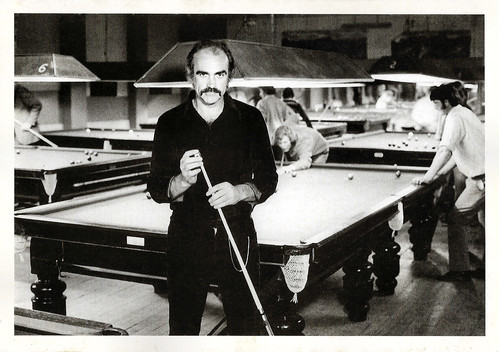
British postcard by Black & White Images Ltd., London, no. 1181. Photo: David Steen.
Being A Scot
In later years, Sean Connery's filmography included several box office and critical disappointments such as First Knight (Jerry Zucker, 1995), The Avengers (Jeremiah S. Chechik, 1998), and The League of Extraordinary Gentlemen (Stephen Norrington, 2003).
Connery received positive reviews, including his performance in Finding Forrester (Gus Van Sant, 2000). When Connery received the American Film Institute's Lifetime Achievement Award on 8 June 2006, he confirmed his retirement from acting.
In 2008, on his 78th birthday, Connery unveiled his autobiography 'Being a Scot', co-written with Murray Grigor. Connery briefly came out of retirement in 2012 by voice acting the title character in the Scottish animated film Sir Billi the Vet (Sascha Hartmann, 2012). Connery served as executive producer for an expanded 80-minute version.
Sean Connery was married to actress Diane Cilento from 1962 to 1973. They had a son, actor Jason Connery . Since 1975 he was married to Moroccan-French painter painter Micheline Roquebrune. In 2000, Sean Connery was knighted. On 31 October 2020, Sir Sean Connery died peacefully in his sleep at his home in Nassau in the Bahamas, surrounded by family. His son stated that he "had been unwell for some time". He was 90.
Trailer Dr. No (1962). Source: Movieclips Classic Trailers (YouTube).
Trailer From Russia With Love (1963). Source: Movieclips Classic Trailers (YouTube).
Trailer Goldfinger (1964). Source: Movieclips Classic Trailers (YouTube).
Trailer Thunderball (1965). Source: Movieclips Classic Trailers (YouTube).
Trailer You Only Live Twice (1967). Source: Movieclips Classic Trailers (YouTube).
Sources: Hal Erickson (AllMovie), Brian McFarlane (Encyclopedia of British Cinema), SeanConnery.com, Wikipedia, and .

Spanish postcard. Photo: United Artists.

Vintage German postcard. Photo: P.A. Reuter.

Spanish postcard by Postal Oscarcolor, no. 13. Sean Connery and Tippi Hedren in Marnie (Alfred Hitchcock, 1964).

French postcard by Editions F. Nugeron, no. Star57.

American postcard by Fotofolio, New York, N.Y., no. HR 62. Photo: Herb Ritts. Caption: Sean Connery, Hollywood, 1989.
Mr. Universe
Thomas Sean Connery was born in Edinburgh, Scotland, UK, in 1930. He was the son of Euphemia 'Effie' Connery-Maclean, a cleaning woman, and Joseph Connery, a factory worker, and truck driver. He had a younger brother, Neil.
At 13, he left school and worked as a milkman in Edinburgh with St. Cuthbert's Co-operative Society. In 1947 he joined the Royal Navy, but after three years he was discharged on medical grounds because of severe stomach ulcers. First, he returned to the co-op, then worked as a lorry driver, an artist's model for the Edinburgh College of Art, and as a coffin polisher.
Looking to pick up some extra money, he helped out backstage at the King's Theatre around Christmas of 1951. He became interested in the proceedings, and got a job as a singing and dancing sailor in the chorus of 'South Pacific'. More bit parts followed.
He also took up bodybuilding as a hobby. His official website claims he was third in the 1950 Mr. Universe contest, other sources place him in the 1953 competition.
He made his film debut as an extra in the musical Lilacs in the Spring (Herbert Wilcox, 1955) with Anna Neagle and Errol Flynn .
No Road Back (Montgomery Tully, 1957) was Sean's first major film role, and it was followed by such films as Hell Drivers (Cy Endfield, 1957) starring Stanley Baker , Darby O'Gill and the Little People (Robert Stevenson, 1959), and The Frightened City (John Lemont, 1961) with Herbert Lom .

German postcard by Rüdel-Verlag, Hamburg-Bergedorf, no. 4258. Photo: Rank. Sean Connery and Yvonne Romain in The Frightened City (John Lemont, 1961).

Dutch postcard. Sean Connery in From Russia with Love (Terence Young, 1963).

Dutch card, no. AX 6263. Publicity still for Goldfinger (Guy Hamilton, 1964).

Dutch postcard.

German postcard by Kolibri-Verlag, Minden/Westf., no. 2268. Photo: Universal-International. Sean Connery in Marnie (Alfred Hitchcock, 1964).
Possessive Gangster Boyfriend
Sean Connery played another early film part in Another Time, Another Place (Lewis Allen, 1958) as Lana Turner's romantic interest.
During filming, Turner's possessive gangster boyfriend, Johnny Stompanato, believed she was having an affair with Connery. He stormed onto the set and pointed a gun at Connery, only to have Connery disarm Stompanato and knock him flat on his back.
Shortly thereafter, Stompanato met his end at the hands of Lana Turner 's teenage daughter, Cheryl Crane. The film was released four months ahead of schedule to capitalise on the murder.
Meanwhile, Connery also appeared regularly on television. He played the leads in an ITV Teleplay of Anna Christie (1957) with his later wife Diane Cilento, and in a Canadian TV adaptation of Macbeth (Paul Almond, 1961).
He also had a prominent role in a BBC production of Anna Karenina (Rudolph Cartier, 1961), in which he co-starred with Claire Bloom .

British postcard by Klasik Kards, London, no. 1543. Photos: publicity stills for From Russia with Love (Terence Young, 1963) with Daniela Bianchi and Martine Beswick.

Spanish postcard by Postal Oscarcolor, no. 12.

Spanish postcard by Postal Oscarcolor, no. 356, Dep Legal B 17-165-VIII.

French postcard by E.D.U.G., no. 454. Photo: Lynx. Sean Connery in Thunderball (Terence Young, 1965).

French postcard by E.D.U.G.
Suave and Sophisticated
Sean Connery's big breakthrough came in the role of the suave and sophisticated secret agent James Bond.
He played 007 in seven Bond films: Dr. No (Terence Young, 1962), From Russia with Love (Terence Young, 1963), Goldfinger (Guy Hamilton, 1964), Thunderball (Terence Young, 1965), You Only Live Twice (Lewis Gilbert, 1967), Diamonds Are Forever (Guy Hamilton, 1971), and finally Never Say Never Again (Irvin Kershner, 1983).
All seven films were big box-office hits, if not critically acclaimed as well. Among his many Bond girls were Ursula Andress , Daniela Bianchi , Honor Blackman , Shirley Eaton, Claudine Auger , Karin Dor , Lana Wood, Jill St. John, Barbara Carrera, and Kim Basinger .
At first, James Bond's creator, Ian Fleming, doubted the casting, saying, "He's not what I envisioned of James Bond looks" and "I’m looking for Commander Bond and not an overgrown stunt-man," adding that the muscular Connery was unrefined.
However, Fleming's girlfriend told him Connery had the requisite sexual charisma. Fleming changed his mind after the successful Dr. No premiere. He was so impressed, he created a half-Scottish, half-Swiss heritage for the literary James Bond in the later novels.

German postcard. Photo: dpa. Sean Connery and Molly Peters in Thunderball (Terence Young, 1965).

Vintage postcard. Photo: fpa.

German postcard. Photo: dpa. Publicity still for Thunderball (Terence Young, 1965).

German postcard. Photo: P.A. Reuter. Publicity still for Goldfinger (Guy Hamilton, 1964).

German postcard. Photo: P.A. Reuter. Sean Connery as James Bond.
Stylistic Tutelage
Sean Connery's portrayal of Bond owes much to stylistic tutelage from director Terence Young, polishing the actor while using his physical grace and presence for the action.
While making the Bond films, Connery also starred in other acclaimed films such as The Longest Day (Ken Annakin, Andrew Marton, Bernhard Wicki, 1962), the romantic melodrama Woman of Straw (Basil Dearden, 1964) with Gina Lollobrigida , Marnie (Alfred Hitchcock, 1964), the excellent war film The Hill (Sidney Lumet, 1965), and the Western Shalako (Edward Dmytryk, 1968) with Brigitte Bardot.
Two of his most moving films were The Offence (Sidney Lumet, 1972) and the wise and romantic version of the Robin Hood legend, Robin and Marian (Richard Lester, 1976) with Audrey Hepburn .
Apart from these films and The Man Who Would Be King (John Huston, 1975) with Michael Caine , and The Wind and the Lion (John Milius, 1975), most of Connery's successes in the seventies were as part of ensemble casts in films such as the Agatha Christie mystery Murder on the Orient Express (Sidney Lumet, 1974) and the war epic A Bridge Too Far (Richard Attenborough, 1977).
Four years later, Sean Connery appeared in the Sci-Fi comedy Time Bandits (Terry Gilliam, 1981) as King Agamemnon. The casting choice derives from a joke Michael Palin included in the script, in which he describes the character as being 'Sean Connery — or someone of equal but cheaper stature'. However, when shown the script, Connery was happy to play the supporting role.

West-German postcard by ISV, no. H 119.

West-German postcard by ISV, no. H 123.

West-German postcard, no. 902/413.

Romanian postcard by Casa Filmului Acin. Luciana Paluzzi and Sean Connery in Thunderball (Terence Young, 1965).

Israelian postcard by Editions de Luxe, no. 104.
A Nightmarish Experience
Never Say Never Again in 1983 was a nightmarish experience for him because of difficulties with the production staff.
After this experience and the following court case, Sean Connery became unhappy with the major studios and for two years did not make any films.
He returned to the screen in the successful European production Der Name der Rose/The Name of the Rose (Jean-Jacques Annaud, 1986), for which he won a BAFTA award.
That same year, a supporting role in Highlander (Russell Mulcahy, 1986) with Christophe(r) Lambert also showcased his ability to play older mentors to younger leads, which would become a recurring role in many of his later films.

British postcard by Klasik Kards, London, no. 1506. Photo: Sean Connery in Goldfinger (Guy Hamilton, 1964).

Vintage postcard.

Romanian postcard by Casa Filmului Acin. With Roger Moore.
Italian postcard by Vittorius, Roma (Rome), no. VR 503. Sent by mail in Germany in 1997. Photo: publicity still for Der Name der Rose/The Name of the Rose (Jean-Jacques Annaud, 1986).

Vintage press photo.
Hard-nosed Veteran Cop
The following year, Sean Connery's acclaimed performance as a hard-nosed veteran cop in The Untouchables (Brian de Palma, 1987) earned him the Oscar for Best Supporting Actor, his sole nomination throughout his career.
Subsequent box-office hits included Indiana Jones and the Last Crusade (Steven Spielberg, 1989), The Hunt for Red October (John McTiernan, 1990), where he was reportedly called in at two weeks' notice, The Rock (Michael Bay, 1996), and Entrapment (Jon Amiel, 1999) with Catherine Zeta-Jones . The latter two he also produced.
Both Last Crusade and The Rock alluded to his James Bond days. Steven Spielberg and George Lucas wanted 'the father of Indiana Jones' to be Connery since Bond directly inspired the Indiana Jones series, while his character in The Rock, John Patrick Mason, was a British secret service agent imprisoned since the 1960s.

French postcard by Editions Nugeron, no. Star 206. Photo: Lucasfilm. With Harrison Ford in Indiana Jones and the Last Crusade (Steven Spielberg, 1989).

French postcard by Editions Nugeron, no. 198. Photo: Lucasfilm. With Harrison Ford in Indiana Jones and the Last Crusade (Steven Spielberg, 1989).

Dutch collectors card in the series 'Filmsterren: een Portret' by Edito-Service, 1993. Photo: A. Pélé / Stills. Publicity still for Highlander (Russell Mulcahy, 1985).

French postcard by Sonis, no. C. 160. Photo: Christopher Lambert and Sean Connery in Highlander II: The Quickening (Russell Mulcahy, 1991).

British postcard by Black & White Images Ltd., London, no. 1181. Photo: David Steen.
Being A Scot
In later years, Sean Connery's filmography included several box office and critical disappointments such as First Knight (Jerry Zucker, 1995), The Avengers (Jeremiah S. Chechik, 1998), and The League of Extraordinary Gentlemen (Stephen Norrington, 2003).
Connery received positive reviews, including his performance in Finding Forrester (Gus Van Sant, 2000). When Connery received the American Film Institute's Lifetime Achievement Award on 8 June 2006, he confirmed his retirement from acting.
In 2008, on his 78th birthday, Connery unveiled his autobiography 'Being a Scot', co-written with Murray Grigor. Connery briefly came out of retirement in 2012 by voice acting the title character in the Scottish animated film Sir Billi the Vet (Sascha Hartmann, 2012). Connery served as executive producer for an expanded 80-minute version.
Sean Connery was married to actress Diane Cilento from 1962 to 1973. They had a son, actor Jason Connery . Since 1975 he was married to Moroccan-French painter painter Micheline Roquebrune. In 2000, Sean Connery was knighted. On 31 October 2020, Sir Sean Connery died peacefully in his sleep at his home in Nassau in the Bahamas, surrounded by family. His son stated that he "had been unwell for some time". He was 90.
Trailer Dr. No (1962). Source: Movieclips Classic Trailers (YouTube).
Trailer From Russia With Love (1963). Source: Movieclips Classic Trailers (YouTube).
Trailer Goldfinger (1964). Source: Movieclips Classic Trailers (YouTube).
Trailer Thunderball (1965). Source: Movieclips Classic Trailers (YouTube).
Trailer You Only Live Twice (1967). Source: Movieclips Classic Trailers (YouTube).
Sources: Hal Erickson (AllMovie), Brian McFarlane (Encyclopedia of British Cinema), SeanConnery.com, Wikipedia, and .
Published on October 31, 2020 12:34
October 30, 2020
More Cinémagazine postcards, Part 2
Five years ago, we did a post about Cinémagazine. Cinémagazine-Edition or CE was a small French publishing company, located in Paris, which had a good reputation. Cinémagazine's star postcards from the 1920s and 1930s are still mesmerising. Recently, we found a lot of Cinémagazine postcard which we share with you in two posts. Today, the second post with cards of which the photos have a white frame. At the end of the series, the postcards also came in a lighter version, and sometimes the colour differed too. There were even a few coloured cards.
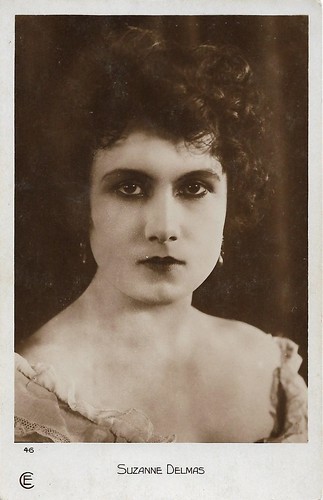
French postcard by Cinémagazine-Edition, Paris, no. 46.
Suzanne Delmas (1901–1984) was a French film actress, who acted in 12 French and German silent films between 1923 and 1930. These included the spy drama L'espionne aux yeux noirs (1926), Poker d'as (Henri Desfontaines, 1928), Dornenweg einer Fürstin/Rasputin (Nikolai Larin, Boris Nevolin, 1928) starring Gregori Chmara, and Souris d'hôtel (Adelqui Migliar, 1929) with Ica von Lenkeffy. Le procureur Hallers (Robert Wiene, 1930) was her first sound film but also her last film.
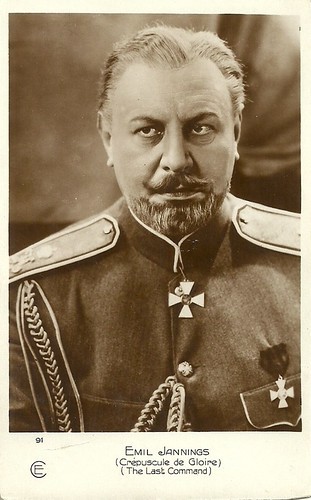
French postcard by Cinémagazine-Edition, no. 91. Emil Jannings in The Last Command (Josef von Sternberg, 1928).
If Weimar cinema had one film star, then it was Emil Jannings (1884-1950) for sure. He was a great actor in the silent era and won the first Oscar for Best Actor. Priceless are his performances as Louis XV in Lubitsch' Madame Dubarry (1919), as the doorman in Murnau's The Last Laugh (1924), the jealous acrobat in Dupont's Variety (1925) and the professor in Von Sternberg's The Blue Angel (1930).
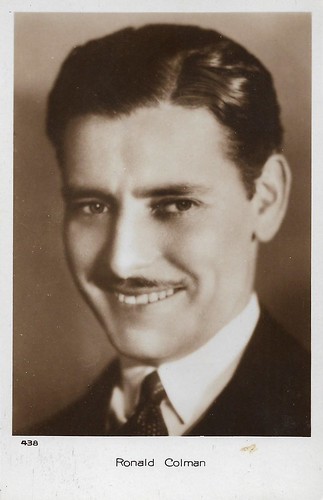
French postcard by Cinémagazine-Edition, Paris, no. 438.
English gentleman-actor Ronald Colman (1891-1958) was a top box office draw in Hollywood films throughout the 1920s, 1930s, and 1940s. ‘The man with the velvet voice’ was nominated for four Academy Awards. In 1948 he finally won the Oscar for his splendid portrayal of a tormented actor in A Double Life.
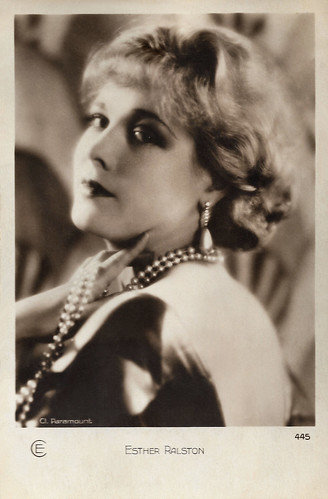
French postcard by Cinémagazine-Edition, Paris, no. 445. Photo: Paramount.
Projected as wholesome but fun-loving, Maine-born leading lady Esther Ralston (1902-1994) enjoyed a prime silent age career. She appeared in close to 100 films over a nearly 30-year period. At her peak, she was packaged and publicised as 'The American Venus' by Florenz Ziegfeld Jr. after appearing as a dazzling beauty queen in the film The American Venus (1926). A decade later, the blonde beauty's career, however, had tapered off.
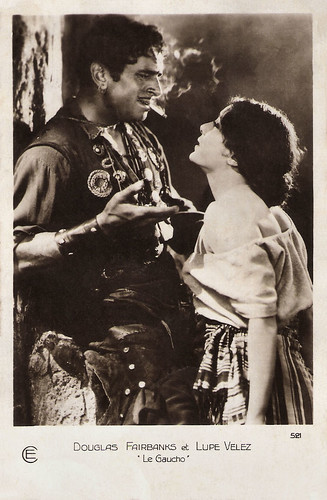
French postcard by Cinémagazine-Edition, Paris, no. 521. Douglas Fairbanks and Lupe Velez in The Gaucho (F. Richard Jones, 1927). Sent by mail in 1930.
American actor Douglas Fairbanks (1883-1939) was best known for his swashbuckling roles in silent films such as The Mark of Zorro (1920), Robin Hood (1922), and The Thief of Bagdad (1924), but spent the early part of his career making comedies. Fairbanks was a founding member of United Artists and of The Motion Picture Academy. Lupe Velez (1908-1944), was one of the first Mexican actresses to succeed in Hollywood. Her nicknames were 'The Mexican Spitfire' and 'Hot Pepper'. She was the leading lady in such silent films as The Gaucho (1927), Lady of the Pavements (1928), and Wolf Song (1929). During the 1930s, her well-known explosive screen persona was exploited in a series of successful films like Hot Pepper (1933), Strictly Dynamite (1934), and Hollywood Party (1934). In the 1940s, Vélez's popularity peaked after appearing in the Mexican Spitfire films.
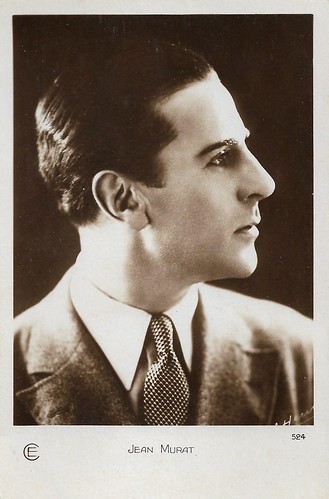
French postcard by Cinémagazine-Edition, Paris, no. 524.
French actor Jean Murat (1888-1968) became a star as a handsome young soldier in silent films of the 1920s. Later, he appeared in such classic French films as La Kermesse Heroique (1935) and L'Eternal Retour (1943).

French postcard by Cinémagazine-Edition, no. 568. Photo: Fox Film.
American film actor Tom Mix (1880-1940) was the star of many early Westerns between 1909 and 1935. Mix appeared in 291 films, all but nine of which were silent movies. He was Hollywood's first Western megastar and helped to define the genre for all cowboy actors who followed.
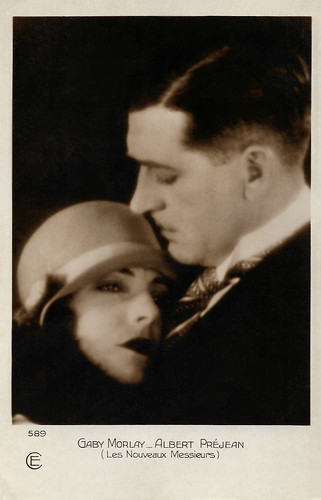
French postcard by Cinémagazine-Edition, Paris, no. 589. Albert Préjean and Gaby Morlay in Les nouveaux messieurs/The New Gentlemen (Jacques Feyder, 1928).
Gaby Morlay (1893-1964) was a French actress with a long-standing career, playing in over 100 films. She compensated for her small size (1.53 m.) with passion and enthusiasm. French actor and singer Albert Préjean (1894-1979) was a former WWI flying ace. He is best known for playing heroes in the silent and early sound films of René Clair, and for playing George Siménon's detective Maigret.
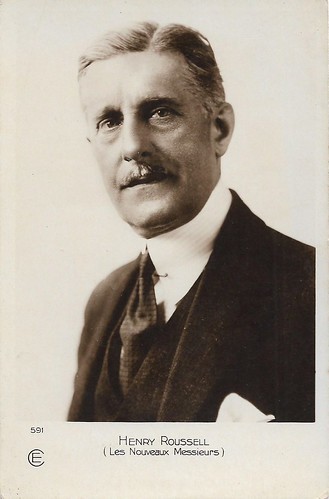
French postcard by Cinémagazine-Edition, Paris, no. 591. Henry Roussel in Les nouveaux messieurs/The New Gentlemen (Jacques Feyder, 1928).
Henry Roussel (1875–1946), also known as Henry Roussell, was a French silent film actor, film director, and screenwriter best known for his silent films of the 1910s and 1920s. He starred in well over 40 films between 1912 and 1939 and directed such films as Visages voilés... âmes closes (1921), Les opprimés (1923), Violettes impériales/Imperial Violets (1924) and Paris' Girls (1929), while in the early 1910s he was a regular actor of the Eclair company, often directed by Maurice Tourneur, and later on had memorable parts in e.g. Les nouveaux messieurs (1929).
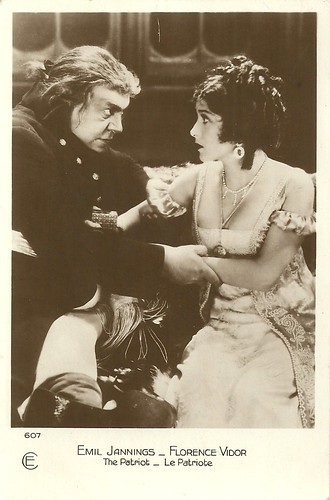
French postcard by Cinémagazine-Edition, no. 607. Emil Jannings and Florence Vidor in The Patriot (Ernst Lubitsch, 1928).
If Weimar cinema had one film star, then it was Emil Jannings (1884-1950) for sure. He was a great actor in the silent era and won the first Oscar for Best Actor. Priceless are his performances as Louis XV in Lubitsch' Madame Dubarry (1919), as the doorman in Murnau's The Last Laugh (1924), the jealous acrobat in Dupont's Variety (1925) and the professor in Von Sternberg's The Blue Angel (1930).
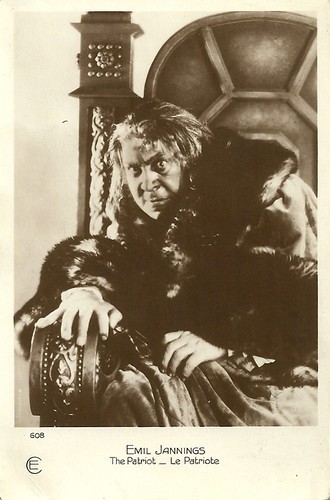
French postcard by Cinémagazine-Edition, no. 608. Emil Jannings again in The Patriot (Ernst Lubitsch, 1928).
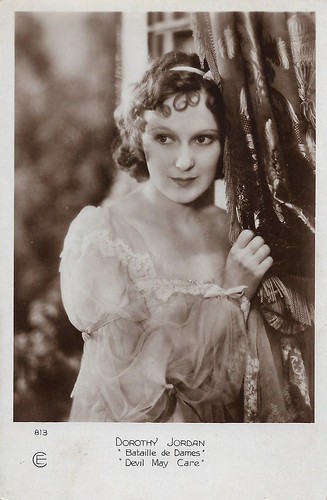
French postcard by Cinémagazine-Edition, Paris, no. 613. Dorothy Jordan in Devil-May-Care (Sidney Franklin, 1929). The French title was Bataille de Dames.
Dorothy Jordan (1906-1988) was an American film actress, who emerged at the start of the talkies. She made her film debut in 1929 as Mary Pickford's sister in Sam Taylor's The Taming of the Shrew. Jordan worked for various studios and until 1933 played the female lead in various films. Important parts she had in Min and Bill (1930) with Wallace Beery and Marie Dressler and in The Cabin in the Cotton (1932) with Bette Davis. In 1933 Jordan left the film industry to marry film producer and director Merian C. Cooper.
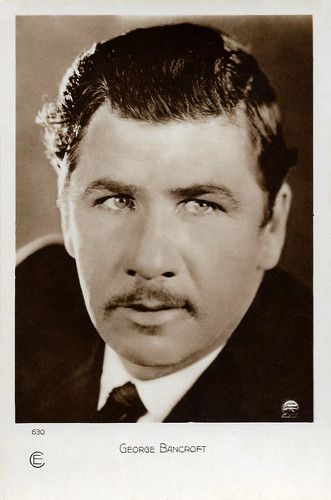
French postcard by Cinémagazine-Edition, Paris, no. 630. Photo: Paramount.
Burly, beefy and tall George Bancroft (1882-1956) was an American film and stage actor who played many ill-tempered tough guys. He received an Oscar nomination for his part as Thunderbolt Jim Lang in Josef von Sternberg's gangster film Thunderbolt (1929). Bancroft is also well remembered as Marshal Curly Wilcox in John Ford's Western Stagecoach (1939).
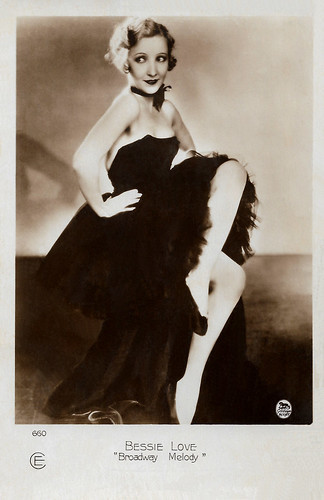
French postcard by Cinémagazine-Edition, Paris, no. 660. Photo: Metro-Goldwyn-Mayer. Bessie Love in The Broadway Melody (Harry Beaumont, 1929).
American actress Bessie Love (1898-1986) was introduced to the cinema by D.W. Griffith. He also gave the actress her screen name. She played innocent young girls and wholesome leading ladies in silent films and early talkies. Her acting career spanned eight decades, and her role in The Broadway Melody (1929) earned her a nomination for the Oscar for Best Actress.
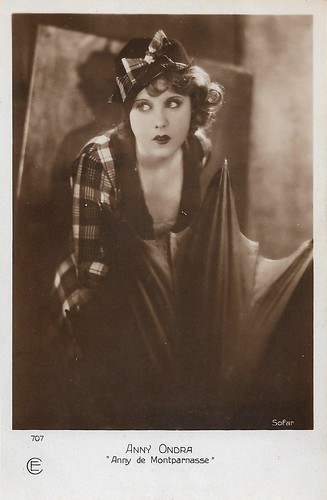
French postcard by Cinémagazine-Edition, Paris, no. 707. Photo: Sofar. Anny Ondra in Sündig und süß/Sinful and Sweet (Carl Lamac, 1929), released in France as Anny de Montparnasse.
Anny Ondra (1903-1987) was a Polish-Czech-Austrian-German-French singer, film, and stage actress. During the 1920s and 1930s, she was a popular actress in Czech, Austrian and German comedies, and she was Alfred Hitchcock’s first ‘Blonde’.
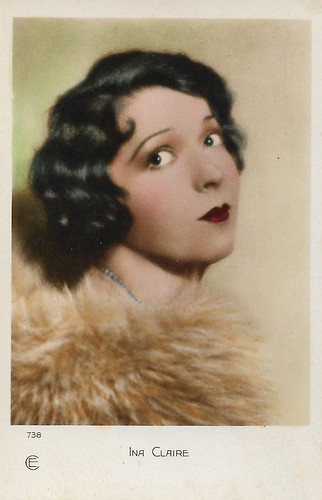
French postcard by Cinémagazine-Edition, Paris, no. 738.
Ina Claire (1893-1985) was an American stage and film actress. In the 1910s, 1920s, and 1930s, she was a big Broadway star. She could be seen in several early Pre-Code sound films such as the first version of The Awful Truth (1929), but she is best remembered as Grandduchess Swana in Ninotchka (1939) by Ernst Lubitsch, starring Greta Garbo. Claire was married to actor John Gilbert in 1929-1931.
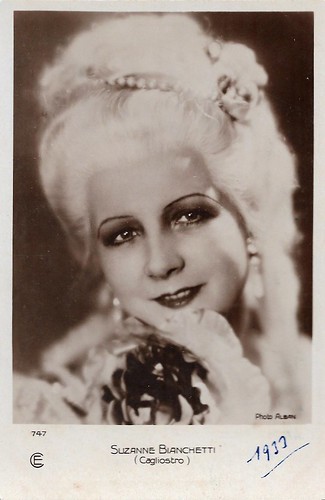
French postcard by Cinémagazine-Edition, Paris, no. 747. Photo: Alban. Suzanne Bianchetti as Queen Marie-Antoinette of France in the Franco-German coproduction Cagliostro (Richard Oswald, 1929). The year written on the card does not refer to the French release, as that was in 1929 as well.
French film actress Suzanne Bianchetti (1889-1936) was one of France's most loved and respected actresses of her time. She played Marie Antoinette in Abel Gance's epic Napoléon (1927) and worked with many other great names of the silent cinema. After her death the Prix Suzanne Bianchetti was created in her memory, an annual French award to be given to the most promising young actress.
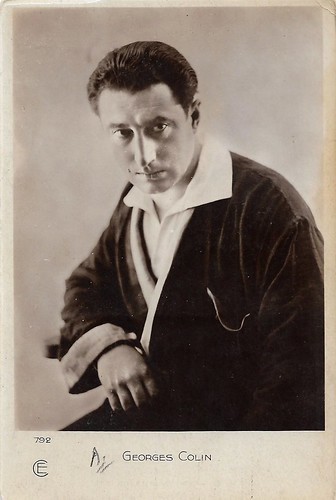
French postcard by Cinémagazine-Edition, Paris, no. 792.
Georges Colin (1880-1945) was a French actor, who appeared in nearly 40 silent and sound films between 1909 and 1945.

French postcard by Cinémagazine-Edition, Paris, no. 928. Photo: Ruben Sobol, Paris.
French film star Annabella (1909-1996) was France's most popular actress during the mid-1930s, but she also achieved some success in Hollywood films of the late 1930s.

French postcard by Cinémagazine-Edition, Paris, no. 929. Photo: Les Films Osso. Albert Préjean and Annabella in Un soir de rafle/Dragnet Night (Carmine Gallone, 1931).
French actor and singer Albert Préjean (1894-1979) was a former WWI flying ace. He is best known for playing heroes in the silent and early sound films of René Clair, and for playing George Siménon's detective Maigret. French film star Annabella (1909-1996) was France's most popular actress during the mid-1930s, but she also achieved some success in Hollywood films of the late 1930s.

French postcard by Cinémagazine-Édition, Paris, no. 930. Photo: Paramount.
Fernand Gravey (1905-1970) was an elegant Franco-Belgian stage, screen, and television actor, successfully working in Belgium, France, England, and Hollywood. He was also a war hero, who was active as a member of the French Intelligence and in particular for the Foreign Legion during the Second World War.
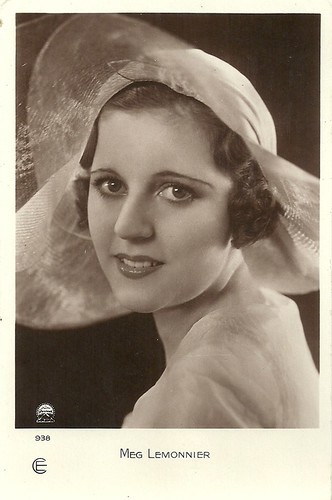
French postcard by Cinémagazine-Edition, Paris, no. 938. Photo: Paramount.
French actress and singer Meg Lemonnier (1905-1988) was most active in the French cinema of the 1930s.
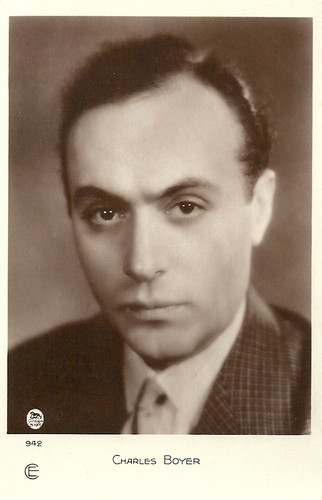
French postcard by Cinémagazine-Edition, Paris, no. 942. Photo: Metro-Goldwyn-Mayer.
Suave and sophisticated French actor Charles Boyer (1899-1978) began his career in French silent films and in 1936 he became an international star with his role in Mayerling opposite Danielle Darrieux. His long career earned him the title of 'the last of the cinema's great lovers'.
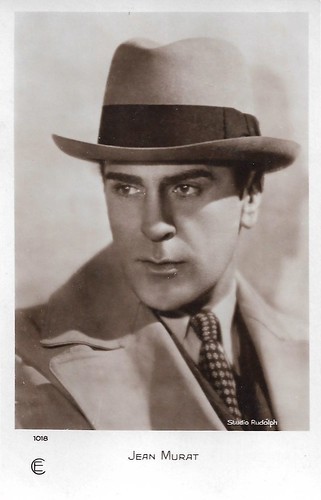
French postcard by Cinémagazine-Edition, Paris, no. 1018. Photo: Studio Rudolph.
French actor Jean Murat (1888-1968) became a star as a handsome young soldier in silent films of the 1920s. Later, he appeared in such classic French films as La Kermesse Heroique (1935) and L'Eternal Retour (1943).
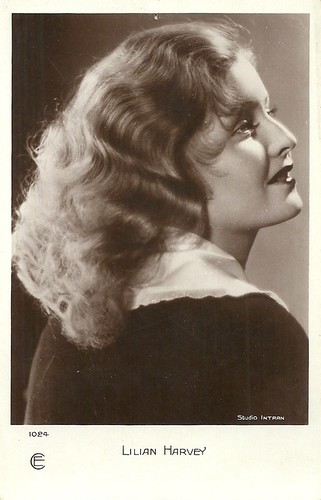
French postcard by Cinémagazine-Edition, Paris, no. 1024. Photo: Studio Intran.
British born, German actress and singer Lilian Harvey (1906-1968) was Ufa's biggest star of the 1930s. With Willy Fritsch, she formed the 'Dream Team of the European Cinema'. Their best film was the immensely popular film operetta Der Kongress tanzt/The Congress Dances (Erik Charell, 1931).
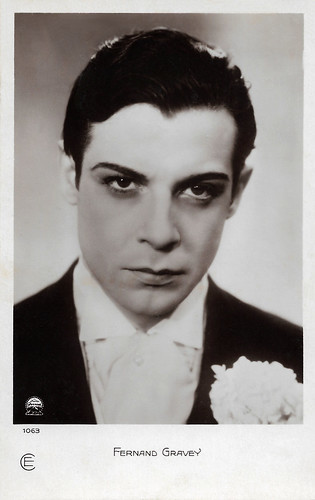
French postcard by Cinémagazine-Édition, Paris, no. 1063. Photo: Paramount. Fernand Gravey in Coiffeur pour dames/Ladies Hairdresser (René Guissart, 1932).
Fernand Gravey (1905-1970) was an elegant Franco-Belgian stage, screen, and television actor, successfully working in Belgium, France, England, and Hollywood. He was also a war hero, who was active as a member of the French Intelligence and in particular for the Foreign Legion during the Second World War.
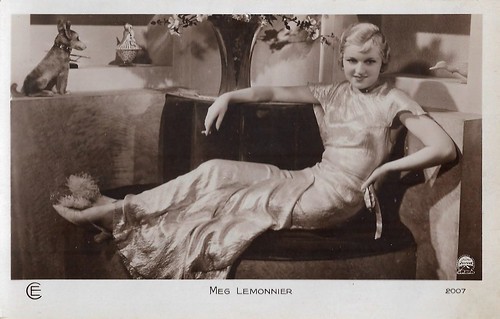
French postcard by Cinémagazine-Edition, Paris, no. 2007. Photo: Paramount.
French actress and singer Meg Lemonnier (1905-1988) was most active in the French cinema of the 1930s.
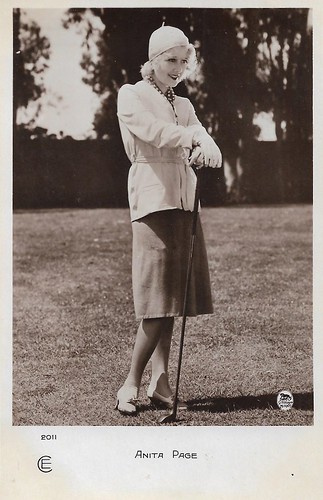
French postcard by Cinémagazine-Edition, Paris, no. 2011. Photo: Metro Goldwyn Mayer.
Beautiful Anita Page (1910–2008) was one of the most popular leading ladies of Hollywood during the last years of the silent screen and the first years of the sound era.
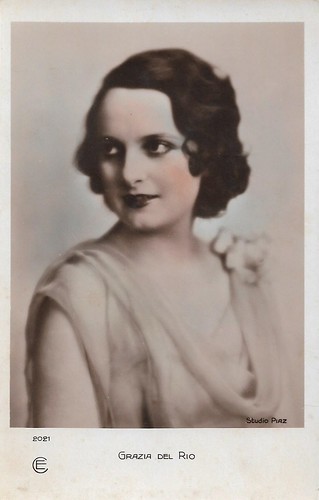
French postcard by Cinémagazine-Editions, no. 2021. Photo: Studio Piaz.
Little is known about the personal life of Italian actress and singer Grazia Del Rio, but probably because of her singing voice and clear vocals she had a prolific career in the earliest years of sound cinema. Between 1930 and 1933 she had a short but intense film career in Italy and France, peaking with La Stella del cinema (Mario Almirante, 1931) in which she starred herself. In the late 1930s, she had a second career in Argentina and Chile.
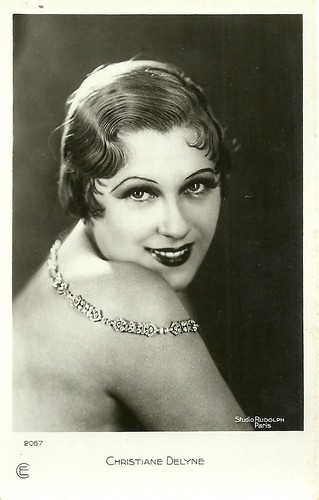
French postcard by Cinémagazine-Edition, Paris, no. 2067. Photo: Studio Rudolph, Paris.
Christiane Delyne (1902–1966) was an American-born French actress, whose film career peaked in early and mid-1930s French sound cinema.

French postcard by Cinémagazine-Edition, Paris, no. 46.
Suzanne Delmas (1901–1984) was a French film actress, who acted in 12 French and German silent films between 1923 and 1930. These included the spy drama L'espionne aux yeux noirs (1926), Poker d'as (Henri Desfontaines, 1928), Dornenweg einer Fürstin/Rasputin (Nikolai Larin, Boris Nevolin, 1928) starring Gregori Chmara, and Souris d'hôtel (Adelqui Migliar, 1929) with Ica von Lenkeffy. Le procureur Hallers (Robert Wiene, 1930) was her first sound film but also her last film.

French postcard by Cinémagazine-Edition, no. 91. Emil Jannings in The Last Command (Josef von Sternberg, 1928).
If Weimar cinema had one film star, then it was Emil Jannings (1884-1950) for sure. He was a great actor in the silent era and won the first Oscar for Best Actor. Priceless are his performances as Louis XV in Lubitsch' Madame Dubarry (1919), as the doorman in Murnau's The Last Laugh (1924), the jealous acrobat in Dupont's Variety (1925) and the professor in Von Sternberg's The Blue Angel (1930).

French postcard by Cinémagazine-Edition, Paris, no. 438.
English gentleman-actor Ronald Colman (1891-1958) was a top box office draw in Hollywood films throughout the 1920s, 1930s, and 1940s. ‘The man with the velvet voice’ was nominated for four Academy Awards. In 1948 he finally won the Oscar for his splendid portrayal of a tormented actor in A Double Life.

French postcard by Cinémagazine-Edition, Paris, no. 445. Photo: Paramount.
Projected as wholesome but fun-loving, Maine-born leading lady Esther Ralston (1902-1994) enjoyed a prime silent age career. She appeared in close to 100 films over a nearly 30-year period. At her peak, she was packaged and publicised as 'The American Venus' by Florenz Ziegfeld Jr. after appearing as a dazzling beauty queen in the film The American Venus (1926). A decade later, the blonde beauty's career, however, had tapered off.

French postcard by Cinémagazine-Edition, Paris, no. 521. Douglas Fairbanks and Lupe Velez in The Gaucho (F. Richard Jones, 1927). Sent by mail in 1930.
American actor Douglas Fairbanks (1883-1939) was best known for his swashbuckling roles in silent films such as The Mark of Zorro (1920), Robin Hood (1922), and The Thief of Bagdad (1924), but spent the early part of his career making comedies. Fairbanks was a founding member of United Artists and of The Motion Picture Academy. Lupe Velez (1908-1944), was one of the first Mexican actresses to succeed in Hollywood. Her nicknames were 'The Mexican Spitfire' and 'Hot Pepper'. She was the leading lady in such silent films as The Gaucho (1927), Lady of the Pavements (1928), and Wolf Song (1929). During the 1930s, her well-known explosive screen persona was exploited in a series of successful films like Hot Pepper (1933), Strictly Dynamite (1934), and Hollywood Party (1934). In the 1940s, Vélez's popularity peaked after appearing in the Mexican Spitfire films.

French postcard by Cinémagazine-Edition, Paris, no. 524.
French actor Jean Murat (1888-1968) became a star as a handsome young soldier in silent films of the 1920s. Later, he appeared in such classic French films as La Kermesse Heroique (1935) and L'Eternal Retour (1943).

French postcard by Cinémagazine-Edition, no. 568. Photo: Fox Film.
American film actor Tom Mix (1880-1940) was the star of many early Westerns between 1909 and 1935. Mix appeared in 291 films, all but nine of which were silent movies. He was Hollywood's first Western megastar and helped to define the genre for all cowboy actors who followed.

French postcard by Cinémagazine-Edition, Paris, no. 589. Albert Préjean and Gaby Morlay in Les nouveaux messieurs/The New Gentlemen (Jacques Feyder, 1928).
Gaby Morlay (1893-1964) was a French actress with a long-standing career, playing in over 100 films. She compensated for her small size (1.53 m.) with passion and enthusiasm. French actor and singer Albert Préjean (1894-1979) was a former WWI flying ace. He is best known for playing heroes in the silent and early sound films of René Clair, and for playing George Siménon's detective Maigret.

French postcard by Cinémagazine-Edition, Paris, no. 591. Henry Roussel in Les nouveaux messieurs/The New Gentlemen (Jacques Feyder, 1928).
Henry Roussel (1875–1946), also known as Henry Roussell, was a French silent film actor, film director, and screenwriter best known for his silent films of the 1910s and 1920s. He starred in well over 40 films between 1912 and 1939 and directed such films as Visages voilés... âmes closes (1921), Les opprimés (1923), Violettes impériales/Imperial Violets (1924) and Paris' Girls (1929), while in the early 1910s he was a regular actor of the Eclair company, often directed by Maurice Tourneur, and later on had memorable parts in e.g. Les nouveaux messieurs (1929).

French postcard by Cinémagazine-Edition, no. 607. Emil Jannings and Florence Vidor in The Patriot (Ernst Lubitsch, 1928).
If Weimar cinema had one film star, then it was Emil Jannings (1884-1950) for sure. He was a great actor in the silent era and won the first Oscar for Best Actor. Priceless are his performances as Louis XV in Lubitsch' Madame Dubarry (1919), as the doorman in Murnau's The Last Laugh (1924), the jealous acrobat in Dupont's Variety (1925) and the professor in Von Sternberg's The Blue Angel (1930).

French postcard by Cinémagazine-Edition, no. 608. Emil Jannings again in The Patriot (Ernst Lubitsch, 1928).

French postcard by Cinémagazine-Edition, Paris, no. 613. Dorothy Jordan in Devil-May-Care (Sidney Franklin, 1929). The French title was Bataille de Dames.
Dorothy Jordan (1906-1988) was an American film actress, who emerged at the start of the talkies. She made her film debut in 1929 as Mary Pickford's sister in Sam Taylor's The Taming of the Shrew. Jordan worked for various studios and until 1933 played the female lead in various films. Important parts she had in Min and Bill (1930) with Wallace Beery and Marie Dressler and in The Cabin in the Cotton (1932) with Bette Davis. In 1933 Jordan left the film industry to marry film producer and director Merian C. Cooper.

French postcard by Cinémagazine-Edition, Paris, no. 630. Photo: Paramount.
Burly, beefy and tall George Bancroft (1882-1956) was an American film and stage actor who played many ill-tempered tough guys. He received an Oscar nomination for his part as Thunderbolt Jim Lang in Josef von Sternberg's gangster film Thunderbolt (1929). Bancroft is also well remembered as Marshal Curly Wilcox in John Ford's Western Stagecoach (1939).

French postcard by Cinémagazine-Edition, Paris, no. 660. Photo: Metro-Goldwyn-Mayer. Bessie Love in The Broadway Melody (Harry Beaumont, 1929).
American actress Bessie Love (1898-1986) was introduced to the cinema by D.W. Griffith. He also gave the actress her screen name. She played innocent young girls and wholesome leading ladies in silent films and early talkies. Her acting career spanned eight decades, and her role in The Broadway Melody (1929) earned her a nomination for the Oscar for Best Actress.

French postcard by Cinémagazine-Edition, Paris, no. 707. Photo: Sofar. Anny Ondra in Sündig und süß/Sinful and Sweet (Carl Lamac, 1929), released in France as Anny de Montparnasse.
Anny Ondra (1903-1987) was a Polish-Czech-Austrian-German-French singer, film, and stage actress. During the 1920s and 1930s, she was a popular actress in Czech, Austrian and German comedies, and she was Alfred Hitchcock’s first ‘Blonde’.

French postcard by Cinémagazine-Edition, Paris, no. 738.
Ina Claire (1893-1985) was an American stage and film actress. In the 1910s, 1920s, and 1930s, she was a big Broadway star. She could be seen in several early Pre-Code sound films such as the first version of The Awful Truth (1929), but she is best remembered as Grandduchess Swana in Ninotchka (1939) by Ernst Lubitsch, starring Greta Garbo. Claire was married to actor John Gilbert in 1929-1931.

French postcard by Cinémagazine-Edition, Paris, no. 747. Photo: Alban. Suzanne Bianchetti as Queen Marie-Antoinette of France in the Franco-German coproduction Cagliostro (Richard Oswald, 1929). The year written on the card does not refer to the French release, as that was in 1929 as well.
French film actress Suzanne Bianchetti (1889-1936) was one of France's most loved and respected actresses of her time. She played Marie Antoinette in Abel Gance's epic Napoléon (1927) and worked with many other great names of the silent cinema. After her death the Prix Suzanne Bianchetti was created in her memory, an annual French award to be given to the most promising young actress.

French postcard by Cinémagazine-Edition, Paris, no. 792.
Georges Colin (1880-1945) was a French actor, who appeared in nearly 40 silent and sound films between 1909 and 1945.

French postcard by Cinémagazine-Edition, Paris, no. 928. Photo: Ruben Sobol, Paris.
French film star Annabella (1909-1996) was France's most popular actress during the mid-1930s, but she also achieved some success in Hollywood films of the late 1930s.

French postcard by Cinémagazine-Edition, Paris, no. 929. Photo: Les Films Osso. Albert Préjean and Annabella in Un soir de rafle/Dragnet Night (Carmine Gallone, 1931).
French actor and singer Albert Préjean (1894-1979) was a former WWI flying ace. He is best known for playing heroes in the silent and early sound films of René Clair, and for playing George Siménon's detective Maigret. French film star Annabella (1909-1996) was France's most popular actress during the mid-1930s, but she also achieved some success in Hollywood films of the late 1930s.

French postcard by Cinémagazine-Édition, Paris, no. 930. Photo: Paramount.
Fernand Gravey (1905-1970) was an elegant Franco-Belgian stage, screen, and television actor, successfully working in Belgium, France, England, and Hollywood. He was also a war hero, who was active as a member of the French Intelligence and in particular for the Foreign Legion during the Second World War.

French postcard by Cinémagazine-Edition, Paris, no. 938. Photo: Paramount.
French actress and singer Meg Lemonnier (1905-1988) was most active in the French cinema of the 1930s.

French postcard by Cinémagazine-Edition, Paris, no. 942. Photo: Metro-Goldwyn-Mayer.
Suave and sophisticated French actor Charles Boyer (1899-1978) began his career in French silent films and in 1936 he became an international star with his role in Mayerling opposite Danielle Darrieux. His long career earned him the title of 'the last of the cinema's great lovers'.

French postcard by Cinémagazine-Edition, Paris, no. 1018. Photo: Studio Rudolph.
French actor Jean Murat (1888-1968) became a star as a handsome young soldier in silent films of the 1920s. Later, he appeared in such classic French films as La Kermesse Heroique (1935) and L'Eternal Retour (1943).

French postcard by Cinémagazine-Edition, Paris, no. 1024. Photo: Studio Intran.
British born, German actress and singer Lilian Harvey (1906-1968) was Ufa's biggest star of the 1930s. With Willy Fritsch, she formed the 'Dream Team of the European Cinema'. Their best film was the immensely popular film operetta Der Kongress tanzt/The Congress Dances (Erik Charell, 1931).

French postcard by Cinémagazine-Édition, Paris, no. 1063. Photo: Paramount. Fernand Gravey in Coiffeur pour dames/Ladies Hairdresser (René Guissart, 1932).
Fernand Gravey (1905-1970) was an elegant Franco-Belgian stage, screen, and television actor, successfully working in Belgium, France, England, and Hollywood. He was also a war hero, who was active as a member of the French Intelligence and in particular for the Foreign Legion during the Second World War.

French postcard by Cinémagazine-Edition, Paris, no. 2007. Photo: Paramount.
French actress and singer Meg Lemonnier (1905-1988) was most active in the French cinema of the 1930s.

French postcard by Cinémagazine-Edition, Paris, no. 2011. Photo: Metro Goldwyn Mayer.
Beautiful Anita Page (1910–2008) was one of the most popular leading ladies of Hollywood during the last years of the silent screen and the first years of the sound era.

French postcard by Cinémagazine-Editions, no. 2021. Photo: Studio Piaz.
Little is known about the personal life of Italian actress and singer Grazia Del Rio, but probably because of her singing voice and clear vocals she had a prolific career in the earliest years of sound cinema. Between 1930 and 1933 she had a short but intense film career in Italy and France, peaking with La Stella del cinema (Mario Almirante, 1931) in which she starred herself. In the late 1930s, she had a second career in Argentina and Chile.

French postcard by Cinémagazine-Edition, Paris, no. 2067. Photo: Studio Rudolph, Paris.
Christiane Delyne (1902–1966) was an American-born French actress, whose film career peaked in early and mid-1930s French sound cinema.
Published on October 30, 2020 23:00
October 29, 2020
Julien Carette
Julien Carette
(1897-1966), often simply billed as Carette, was a distinguished French character screen actor, marked by his cheeky and fiery-eyed face and his Parisian accent. He was famous for his roles in the late 1930s films by Jean Renoir: La grande illusion (1937), La bête humaine/The Human Beast (1938), La Marseillaise (1938), and La règle du jeu/The Rules of the Game (1939). From the early 1940s, he often acted in the films by Claude Autant-Lara. During his 30-year career, Carette played in over 100 films.
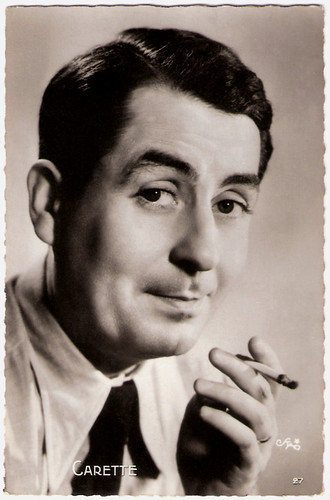
French postcard by Editions O.P., Paris, no. 27. Photo: Star.
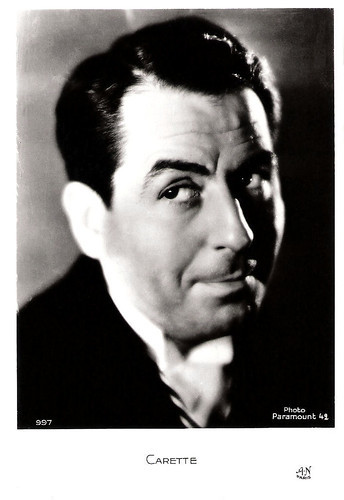
French postcard by A.N., Paris, no. 997. Photo: Paramount.
A carefree wanderer
Julien Henri Carette was born in 1897 in Paris. He was the son of Félix Marius Carette and Valentine Oursel. Carette's childhood did not go smoothly and was marked by a lot of setbacks.
He did many different jobs before enrolling at the ENSAD (École Nationale Supérieure des Arts Décoratifs) in the hope of becoming a painter. He met the future film director Claude Autant-Lara with whom he later collaborated regularly. He soon realised that painting was not his thing. He then took the entrance exam for the Paris Conservatoire. Although he was refused, he still managed to become an extra at the Théâtre de l'Odéon. From then on, he performed in French music halls and in the theatre.
In 1930 he made his film debut in the short film Au coin perdu/At the lost corner (Robert Péguy, 1930) with Kissa Kouprine. The next year followed the short comedy Attaque nocturne/Night attack (Marc Allégret, 1931), with Fernandel in one of his first roles. Marc Allégret cast Carette in two other short films alongside Marcel Dalio .
The Prévert brothers entrusted him with his first major role in the comedy L'affaire est dans le sac/It's in the Bag (1932), Pierre Prévert's directorial debut. That same year he trotted out as a rider in the military satire Les Gaietés de l'escadron/Fun in Barracks (Maurice Tourneur, 1932), starring Jean Gabin , Fernandel , and Raimu .
Marc Allégret gave him some supporting roles, including in the tragicomedies Gribouille/Heart of Paris (Marc Allégret, 1937), in which Michèle Morgan played her first major role alongside Raimu , and Entrée des artistes/The Curtain Rises (Marc Allégret, 1938) with Louis Jouvet. The following year, Carette found Michèle Morgan back in the drama Le Récif de corail/Coral Reefs (Maurice Gleize, 1938), this time in the company of Jean Gabin .
Carette's best-known work of the 1930s is in three classic films by Jean Renoir where he usually played a carefree wanderer. In the pacifist First World War film La Grande Illusion/The Grand Illusion (Jean Renoir, 1937) he portrayed the popular talkative sergeant who was part of a group of imprisoned French officers in a German prison camp. In La Bête Humaine/The Human Beast (Jean Renoir, 1938), a drama based on the fate of the novel by Émile Zola, he played Jean Gabin 's friend and workmate, who drives the train. In La Règle du jeu/The Rules of the Game (Jean Renoir, 1939), a sharp moral comedy about the French upper class and their staff, he played the poacher who becomes a servant in a castle.
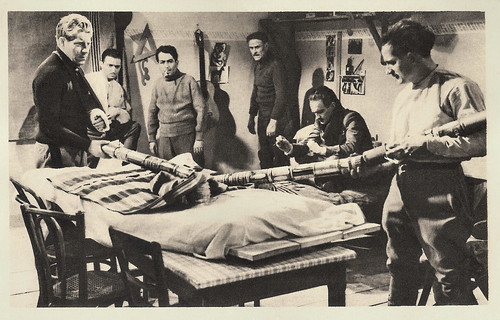
French postcard by Crépa, Editeur, Paris. Photo: Sam Lévin. Jean Gabin , Dalio , Carette, Gaston Modot and Pierre Fresnay in La grande illusion/The Grand Illusion (Jean Renoir, 1937).
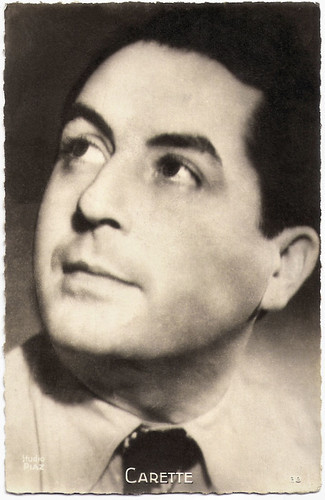
French postcard by Editions O.P., Paris, no. 39. Photo: Studio Piaz.
Titi Parisien
From the early 1940s, Julien Carette acted in eight films by Claude Autant-Lara. In Lettres d'amour/Letters of Love (Claude Autant-Lara, 1942), he played a hectic and devilish dance master. In the period comedy Occupe-toi d'Amélie/Keep an Eye on Amelia (Claude Autant-Lara, 1949), Autant-Lara exploited his comic vein.
In L'Auberge rouge/The Red Inn (Claude Autant-Lara, 1951), alongside Fernandel and Françoise Rosay , he portrayed with verve the menacing hotelier-innkeeper who has the sinister habit of murdering and robbing his customers.The commercial success of this tragicomedy was still eclipsed by the great reception that La Jument verte/The Green Mare (Claude Autant-Lara, 1959) received. In this comedy, based on the successful novel of the same name by Marcel Aymé, Carette portrayed the mayor of a village where two families take each other's lives.
It was Henri Decoin who first cast Carette alongside Danielle Darrieux , in the comedy Battement de cœur/Beating Heart (Henri Decoin, 1940). Jean-Paul Le Chanois gave Carette a supporting role in three of his tragicomedies, each time alongside Bernard Blier . Marcel Carné also managed to use Carette's talent several times, first in Les Portes de la nuit/Gates of the Night (Marcel Carné, 1946), a poetic drama that takes place in Paris in one night. Three years later, Carette bumped into Jean Gabin again, this time in La Marie du port/Marie of the Port (Marcel Carné, 1950), a tragicomedy based on Georges Simenon's novel of the same name.
Carette took the lead on several occasions, especially in the second half of the 1940s. More than 10 years after L'affaire est dans le sac, Carette's second film appearance in 1932, Pierre Prévert gave him the title role in his crime comedy Adieu Léonard/Goodbye Leonard (Pierre Prévert, 1943) with Charles Trenet and Pierre Brasseur . Carette played an ordinary man who commits a blunder and is blackmailed for it by someone who wants to turn him into a murderer.
He preferably embodied simple and straightforward characters who practiced serving professions such as servant, bartender, butler, or coachman. Carette's nickname was 'Titi parisien'. In his films, he often had a mocking and impertinent air and a Parisian swagger about him. This came in handy in the many films set in Paris, including Paris Camargue (Jack Forrester, 1935), Aventure à Paris/Adventure in Paris (Marc Allégret, 1936), Café de Paris (Yves Mirande, Georges Lacombe, 1938), Lumières de Paris/Lights of Paris (Richard Pottier, 1938), Paris, Palace Hôtel (Henri Verneuil, 1956), Rencontre à Paris/Meeting in Paris (Georges Lampin, 1956), and Si Paris nous était conté/If Paris Were Told to Us (Sacha Guitry, 1956).
His career came to a halt around 1960 because he was prone to osteoarthritis. Powerless and helpless, he made his final film, Les Aventures de Salavin/The Adventures of Salavin (Pierre Granier-Deferre, 1964). In 1966, Carette was severely wounded during a fire in his home caused by a burning cigarette. He later passed away in a hospital in Saint-Germain-en-Laye, in the western suburbs of Paris. He was 68. Julien Carette is buried in his hometown Vésinet.
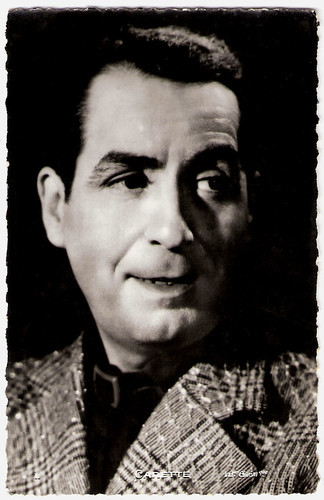
French postcard by Edit. Chantal, Rueil, no. 11. Photo: Industrie Cinématographique.
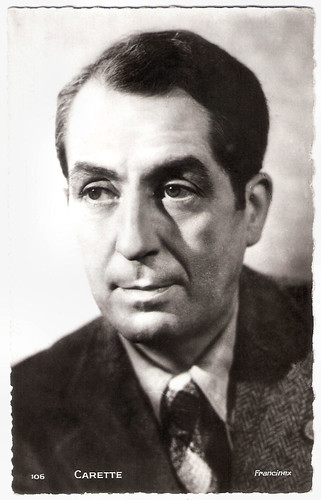
French postcard, no. 106. Photo: Francinex.
Sources: Sandra Brennan (AllMovie), Les Gens du Cinéma (French), Wikipedia (English, Dutch and French), and .

French postcard by Editions O.P., Paris, no. 27. Photo: Star.

French postcard by A.N., Paris, no. 997. Photo: Paramount.
A carefree wanderer
Julien Henri Carette was born in 1897 in Paris. He was the son of Félix Marius Carette and Valentine Oursel. Carette's childhood did not go smoothly and was marked by a lot of setbacks.
He did many different jobs before enrolling at the ENSAD (École Nationale Supérieure des Arts Décoratifs) in the hope of becoming a painter. He met the future film director Claude Autant-Lara with whom he later collaborated regularly. He soon realised that painting was not his thing. He then took the entrance exam for the Paris Conservatoire. Although he was refused, he still managed to become an extra at the Théâtre de l'Odéon. From then on, he performed in French music halls and in the theatre.
In 1930 he made his film debut in the short film Au coin perdu/At the lost corner (Robert Péguy, 1930) with Kissa Kouprine. The next year followed the short comedy Attaque nocturne/Night attack (Marc Allégret, 1931), with Fernandel in one of his first roles. Marc Allégret cast Carette in two other short films alongside Marcel Dalio .
The Prévert brothers entrusted him with his first major role in the comedy L'affaire est dans le sac/It's in the Bag (1932), Pierre Prévert's directorial debut. That same year he trotted out as a rider in the military satire Les Gaietés de l'escadron/Fun in Barracks (Maurice Tourneur, 1932), starring Jean Gabin , Fernandel , and Raimu .
Marc Allégret gave him some supporting roles, including in the tragicomedies Gribouille/Heart of Paris (Marc Allégret, 1937), in which Michèle Morgan played her first major role alongside Raimu , and Entrée des artistes/The Curtain Rises (Marc Allégret, 1938) with Louis Jouvet. The following year, Carette found Michèle Morgan back in the drama Le Récif de corail/Coral Reefs (Maurice Gleize, 1938), this time in the company of Jean Gabin .
Carette's best-known work of the 1930s is in three classic films by Jean Renoir where he usually played a carefree wanderer. In the pacifist First World War film La Grande Illusion/The Grand Illusion (Jean Renoir, 1937) he portrayed the popular talkative sergeant who was part of a group of imprisoned French officers in a German prison camp. In La Bête Humaine/The Human Beast (Jean Renoir, 1938), a drama based on the fate of the novel by Émile Zola, he played Jean Gabin 's friend and workmate, who drives the train. In La Règle du jeu/The Rules of the Game (Jean Renoir, 1939), a sharp moral comedy about the French upper class and their staff, he played the poacher who becomes a servant in a castle.

French postcard by Crépa, Editeur, Paris. Photo: Sam Lévin. Jean Gabin , Dalio , Carette, Gaston Modot and Pierre Fresnay in La grande illusion/The Grand Illusion (Jean Renoir, 1937).

French postcard by Editions O.P., Paris, no. 39. Photo: Studio Piaz.
Titi Parisien
From the early 1940s, Julien Carette acted in eight films by Claude Autant-Lara. In Lettres d'amour/Letters of Love (Claude Autant-Lara, 1942), he played a hectic and devilish dance master. In the period comedy Occupe-toi d'Amélie/Keep an Eye on Amelia (Claude Autant-Lara, 1949), Autant-Lara exploited his comic vein.
In L'Auberge rouge/The Red Inn (Claude Autant-Lara, 1951), alongside Fernandel and Françoise Rosay , he portrayed with verve the menacing hotelier-innkeeper who has the sinister habit of murdering and robbing his customers.The commercial success of this tragicomedy was still eclipsed by the great reception that La Jument verte/The Green Mare (Claude Autant-Lara, 1959) received. In this comedy, based on the successful novel of the same name by Marcel Aymé, Carette portrayed the mayor of a village where two families take each other's lives.
It was Henri Decoin who first cast Carette alongside Danielle Darrieux , in the comedy Battement de cœur/Beating Heart (Henri Decoin, 1940). Jean-Paul Le Chanois gave Carette a supporting role in three of his tragicomedies, each time alongside Bernard Blier . Marcel Carné also managed to use Carette's talent several times, first in Les Portes de la nuit/Gates of the Night (Marcel Carné, 1946), a poetic drama that takes place in Paris in one night. Three years later, Carette bumped into Jean Gabin again, this time in La Marie du port/Marie of the Port (Marcel Carné, 1950), a tragicomedy based on Georges Simenon's novel of the same name.
Carette took the lead on several occasions, especially in the second half of the 1940s. More than 10 years after L'affaire est dans le sac, Carette's second film appearance in 1932, Pierre Prévert gave him the title role in his crime comedy Adieu Léonard/Goodbye Leonard (Pierre Prévert, 1943) with Charles Trenet and Pierre Brasseur . Carette played an ordinary man who commits a blunder and is blackmailed for it by someone who wants to turn him into a murderer.
He preferably embodied simple and straightforward characters who practiced serving professions such as servant, bartender, butler, or coachman. Carette's nickname was 'Titi parisien'. In his films, he often had a mocking and impertinent air and a Parisian swagger about him. This came in handy in the many films set in Paris, including Paris Camargue (Jack Forrester, 1935), Aventure à Paris/Adventure in Paris (Marc Allégret, 1936), Café de Paris (Yves Mirande, Georges Lacombe, 1938), Lumières de Paris/Lights of Paris (Richard Pottier, 1938), Paris, Palace Hôtel (Henri Verneuil, 1956), Rencontre à Paris/Meeting in Paris (Georges Lampin, 1956), and Si Paris nous était conté/If Paris Were Told to Us (Sacha Guitry, 1956).
His career came to a halt around 1960 because he was prone to osteoarthritis. Powerless and helpless, he made his final film, Les Aventures de Salavin/The Adventures of Salavin (Pierre Granier-Deferre, 1964). In 1966, Carette was severely wounded during a fire in his home caused by a burning cigarette. He later passed away in a hospital in Saint-Germain-en-Laye, in the western suburbs of Paris. He was 68. Julien Carette is buried in his hometown Vésinet.

French postcard by Edit. Chantal, Rueil, no. 11. Photo: Industrie Cinématographique.

French postcard, no. 106. Photo: Francinex.
Sources: Sandra Brennan (AllMovie), Les Gens du Cinéma (French), Wikipedia (English, Dutch and French), and .
Published on October 29, 2020 23:00
October 28, 2020
La Collectionneuse: Alice Guy
In September our friend Marlene Pilaete informed us that the French website l’Encinémathèque doesn’t exist anymore. Webmaster Christian Grenier had decided to close l’encinémathèque down for personal reasons. It’s sad. We offered Marlene to host her sublime blog La Collectionneuse at EFSP from now on, and happily, she accepted! We will mix her old posts (from now on in English) with new posts. You can search all her posts at EFSP under La Colectionneuse in the cross-column above. We start with her last post at l’Encinémathèque on French director and film pioneer Alice Guy. Welcome, Marlene!
The documentary Be Natural: L’histoire cachée d’Alice Guy-Blaché (Be Natural: The Hidden Story of Alice Guy-Blaché) was released in French cinemas last June. This is an opportunity to pay a small tribute to this pioneer of the cinema, unjustly forgotten for several decades, through eight old postcards of actresses who worked under her direction.
Alice Guy (1873-1968)
Born in 1873, Alice Guy became a director at Gaumont in 1896 and, until 1907, she made a number of short films there. The performers were, most of the time, anonymous, except when she was filming music-hall celebrities of the time, like Polin, Mayol, or Saharet.
In 1910, she was in the United States, where she notably founded the Solax company, and from there, we can finally identify the stars of her films.
So, let us discover Blanche Cornwall, Marian Swayne, and Claire Whitney, three actresses under contract with Solax, and directed several times by Alice Guy.
Also at Solax, Sally Crute made her very first film under Alice's direction, before moving on to other horizons.
She was the famous director who also guided Olga Petrova's first steps on the screen by directing her in five consecutive films and who, together with her husband Herbert Blaché, helped to launch Catherine Calvert into the world of movie stars.
As for Bessie Love and Dolores Cassinelli, they were the last two actresses to work under Alice Guy, the first in The Great Adventure (1918) and the second in Tarnished Reputations (1920).
Blanche Cornwall (1868? 1885? - 1918? 1977?)
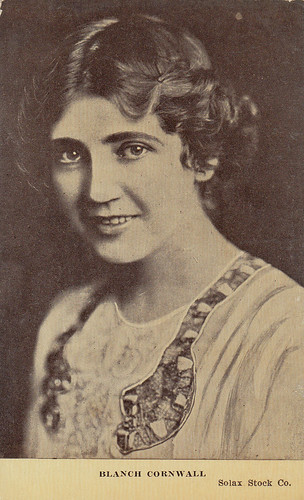
American postcard. Photo: Solax Stock Co. Collection: Marlene Pilaete.
Blanche Cornwall made her film debut in 1911 at the Solax Studios, where she became one of the main female stars.
The co-founder of the company, the French Alice Guy directed the actress on numerous occasions, notably in The Violin Maker of Nuremberg (1911), Mrs. Cranston's Jewels (1912), A Terrible Lesson (1912), Blighted Lives (1912), Child of the Tenements (1912), The Reformation of Mary (1912), The Wooing of Alice (1912), Souls in the Shadow (1912), The Girl in the Arm-Chair (1912), Burstup Homes (1913), …
We can also mention the anticipatory comedy In the Year 2000 (1912), which evokes a world ruled by women at the beginning of the 21st century, and The Pit and the Pendulum (1913), based on the work of Edgar Allan Poe.
She disappeared from the screen in 1914.
Marian Swayne (1891-1973)
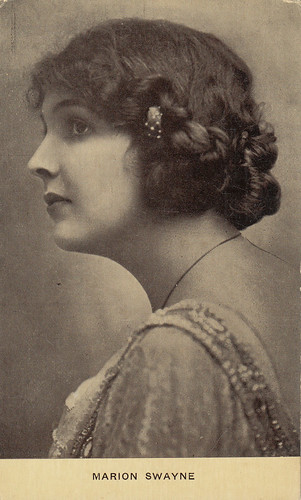
American postcard by Kraus Mfg. Company, N.Y. Collection: Marlene Pilaete.
Marian Swayne (born in Philadelphia, USA) made her film debut at the Solax Company, where, from 1911 to 1913, she was the protagonist of, among others, The Interrupted Elopement (1911), Husbands Wanted (1911), Mignon (1912), Lend Me Your Wife (1912), A Question of Hair (1912), Where Love Dwells (1913), A House Divided (1913), The Hopes of Belinda (1913), The Heavenly Widow (1913), ...
During her early years of stardom, she had the opportunity to be directed several times by Alice Guy.
She then continued her career at other studios and made such films as A Discolored Romance (1914), The Adventures of Kitty Cobb (1914), The Red Cross Nurse (1914), The Winning Loser (1915), The Road Between (1915), The Turning Point (1915), The Carriage of Death (1916), Paying the Price (1916), The Adventurer (1917), with Alice Guy behind the cameras, The Deemster (1917), and The Little Samaritan (1917).
After The Transgressor (1918), a social drama produced by the Catholic Art Association and directed by Joseph Levering, her husband from 1914 until the mid-1930s, she stayed away from the film sets for some time.
From 1921 to 1924, she was still the performer of some films produced by secondary studios.
Claire Whitney (1890-1969)
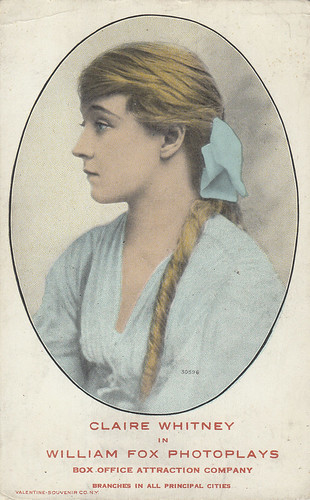
American postcard by Valentine Souvenir Co., no. 30596. Collection: Marlene Pilaete.
Claire Whitney (born in New York, USA) made her screen debut in 1912 at the Solax Studios and quickly became one of their stars.
Until 1914, she filmed, among others, The Paralytic (1912), The Star of India (1913), Shadows of the Moulin Rouge (1913), Beneath the Czar (1914), The Dream Woman (1914), The Woman of Mystery (1914), …
During her time at Solax, she had the opportunity to be directed, several times, by Alice Guy.
From 1915 to 1917, she was employed by Fox, where she was one of the protagonists of, among others, The Girl I Left Behind Me (1915), Blindness of Devotion (1915), The Ruling Passion (1916), A Wife's Sacrifice (1916), Heart and Soul (1917), When False Tongues Speak (1917), ...
Subsequently, she continued her career with films such as Kaiser's Finish (1918), The Man Who Stayed at Home (1919), Mothers of Men (1920), The Chamber Mystery (1920), A Common Level (1920), ...
After The Leech (1921), she was absent from the screens for a few years, before making a brief comeback in The Great Gatsby (1926), in which she played Catherine, the sister-in-law of George Wilson, the character played by William Powell.
From 1929 to 1949, she still appeared in some sixty productions, in small roles, sometimes uncredited.
Sally Crute (1896-1971)
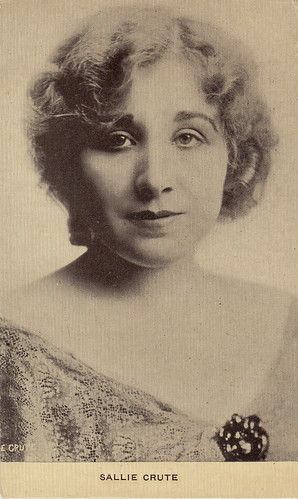
American postcard by Kraus Mfg. Company, N.Y. Photo: E. Crute. Collection: Marlene Pilaete.
Sally Crute (born in Chattanooga, United States) made her film debut with the Solax company in The Woman Behind the Man (1912), directed by Alice Guy. She embodied a wife whose luxury tastes lead her marriage to ruin.
The famous director would not have the opportunity to direct the actress again, who soon signed a contract with Edison Studios. Becoming one of their main stars, she was then, until 1916, the interpreter of, among others, The Price of Human Lives (1913), A Pious Undertaking (1913), A Treacherous Rival (1914), An American King (1914), The Song of Solomon (1914), The Letter That Never came Out (1914), The Voice of Conscience (1915), Seen Through the Make-Up (1915), The Widow's Breezy Suit (1915), The Matchmakers (1915), A Mix-Up in Black (1916), Helen of the Chorus (1916), …
Subsequently, she worked for various studios. She still got a few leading female roles, for example in The Avenging Trail (1917) and Perjury (1921) alongside, respectively, Harold Lockwood and William Farnum .
But, most of the time, she now instead played secondary characters in films starring artists more in vogue then such as Mabel Taliaferro, Norma Talmadge , Shirley Mason, Viola Dana , Alla Nazimova , Beverly Bayne, Sylvia Breamer, Corinne Griffith , Bebe Daniels , Doris Kenyon or Gladys Walton.
She disappeared from the screens in 1926.
Olga Petrova (1884-1977)
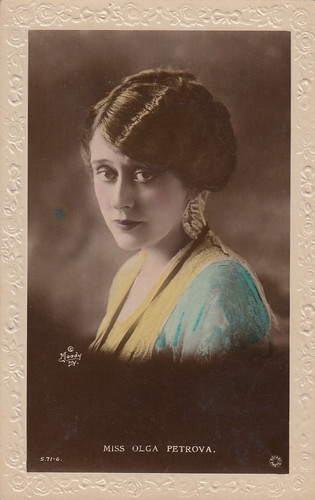
British postcard by Rotary, no. S 71-6. Photo: Moody, N.Y. Collection: Marlene Pilaete.
After making a name for herself on stage in her native country, Olga Petrova (born in Great Britain) moved to the United States in the early 1910s and quickly conquered American audiences.
For her career, she decided to embellish her past and to transform herself into an exotic character. While her real name was Muriel Harding, she called herself Madame Olga Petrova, made up her Slavic origins, and spoke with an accent appropriate to her new identity.
She performed in music halls with monologues, songs, and imitations. In 1914, she tried out classical theatre by playing ‘Panthea’ on Broadway. Such a personality soon became interesting for the world of the Seventh Art. She made her screen debut in 1914, directly as a star.
Alice Guy directed Petrova’s first five films: The Tigress (1914), The Heart of a Painted Woman (1915), The Vampire (1915), My Madonna (1915), and What Will People Say? (1916). Subsequently, she appeared in, among others, The Scarlet Woman (1916), Extravagance (1916), The Secret of Eve (1917), and The Soul of a Magdalen (1917). She was also directed by Maurice Tourneur in The Undying Flame (1917), The Law of the Land (1917), and Exile (1917).
At the end of her cinematographic career, a production firm in her name was created, the ‘Petrova Picture Company’, for which she was the star of Daughter of Destiny (1917), The Light Within (1918), The Life Mask (1918), Tempered Steel (1918) and The Panther Woman (1918). This concluded her filmography.
Note that IMDb adds two Russian titles, in 1912 and 1928, but ‘Petrova’ being a very common surname in Russia, this is a case of disambiguation. After leaving the world of film sets, she returned to the stage. She was then the author and performer of three Broadway plays: ‘The White Peacock’ (1921-1922), ‘Hurricane’ (1923-1924), and ‘What Do We Know?’ (1927-1928). She retired at the end of the 1920s.
Catherine Calvert (1890-1971)
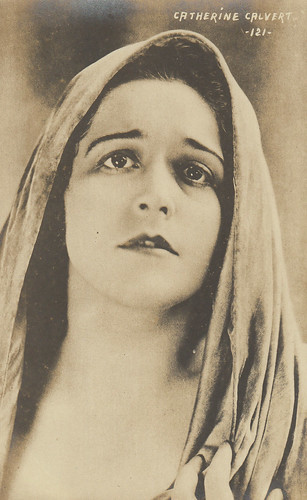
Vintage Artura postcard, no. 121. Collection: Marlene Pilaete.
Catherine Calvert (born in Baltimore, United States) began her career as an actress on stage.
In the early 1910s, she was known as the Broadway performer of ‘The Deep Purple’ and ‘The Escape’, two plays by author Paul Armstrong, whom she married in 1913.
After the death of her husband in 1915, she decided to turn to the cinema and thus appeared in her first film, Partners (1916). It was nevertheless the couple Alice Guy and Herbert Blaché who made her a star of the Seventh Art. They first directed her in House of Cards (1917) and Behind the Mask (1917) and then in The Peddler (1917) and Think It Over (1917).
Other titles in her filmography include The Uphill Path (1918), Out of the Night (1918), Marriage for Convenience (1919), The Career of Katherine Bush (1919), Dead Men Tell No Tales (1920), The Heart of Maryland (1921), and That Woman (1922). She was also the protagonist of The Green Caravan (1922), The Indian Love Lyrics (1923) and Out to Win (1923) in England.
She disappeared from the screens in 1924 and in 1925 she married Canadian millionaire George A. Carruthers.
Bessie Love (1898-1986)

Scandinavian postcard by Eneret B.C. & A.H, no. 246. Photo: Vitagraph. Collection: Marlene Pilaete.
Bessie Love (born in Midland, USA) made her film debut in the mid-1910s. She became known opposite William S. Hart in The Aryan (1916) and Douglas Fairbanks in The Good Bad Man (1916), Reggie Mixes In (1916), and The Mystery of the Leaping Fish (1916).
She quickly elevated to the rank of star and, for fifteen years, she remained so. From time to time, she experienced dips in her career but she did not hesitate to work for second-rate companies or to accept to play more secondary characters, which allowed her to stay active and to be able to bounce back when new opportunities arose to relaunch her career.
Among her films, notable are Hell-to-Pay Austin (1916), A Sister of Six (1916), The Heiress at Coffee Dan’s (1916), Nina, the Flower Girl (1917), A Daughter of the Poor (1917), Wee Lady Betty (1917), Polly Ann (1917), The Great Adventure (1918), directed by Alice Guy, How Could You, Caroline? (1918), A Little Sister of Everybody (1918), The Enchanted Barn (1919), Carolyn of the Corners (1919), A Yankee Princess (1919), A Fighting Colleen (1919), Bonnie May (1920), The Midlanders (1920), Penny of Top Hill Trail (1921), Forget Me Not (1922), Deserted at the Altar (1922), Gentle Julia (1923), Torment (1924), The Lost World (1925), Soul-Fire (1925), New Brooms (1925), The Song and Dance Man (1926), Lovey Mary (1926), Young April (1926), Dress Parade (1927), The Matinee Idol (1928), Anybody Here Seen Kelly? (1928), Sally of the Scandals (1928), …
According to numerous sources, she was the first actress to dance the Charleston on screen in The King on Main Street (1925).
With the advent of sound film, she was chosen to be one of the protagonists of the musical Broadway Melody (1929), which was a triumph and earned her an Oscar nomination for Best Actress. She was later seen in, The Girl in the Show (1929), Chasing Rainbows (1930), They Learned About Women (1930), Good News (1930), See America Thirst (1930), ... Unfortunately, her come-back did not last and the Hollywood future of Bessie Love looked very uncertain. After filming Morals for Women (1931) for Tiffany, a Poverty Row studio, she was absent from the cinemas for some time.
In the mid-1930s, she moved to Britain, where she was last featured in I Live Again (1936). From 1941 to 1983, she still played secondary and small roles in some thirty productions. These include, for example, The Barefoot Contessa (1954), The Roman Spring of Mrs. Stone (1961), Isadora (1968), Sunday, Bloody Sunday (1971), The Ritz (1976), Reds (1981), and The Hunger (1983). She was also active on stage and television.
Dolores Cassinelli (1888-1984)
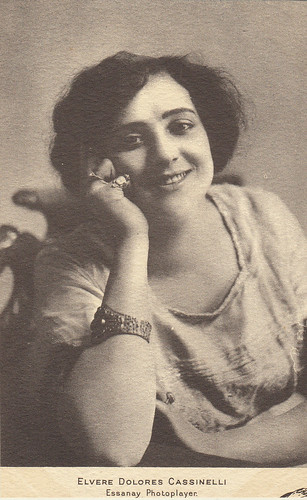
American postcard. Photo: Essanay. Collection: Marlene Pilaete.
Dolores Cassinelli (born in Chicago, USA) made her film debut in 1911 at Essanay, where she became one of the leading female stars.
She was the leading lady of, among others, Two Men and a Girl (1911), Winning an Heiress (1911), Do Dreams Come True? (1912), Napatia, the Greek Singer (1912), The Laurel Wrath of Fame (1912), When Soul Meets Soul (1913), The Girl at the Brook (1913), The Girl in the Case (1913), A Wolf Among Lambs (1913), and A Successful Failure (1913).
After leaving Essanay, she made The Wolf and the City (1913) and Too Late (1914) for Selig and in 1916 she played Mrs. Jerry Simpson, wife of one of the two heroes of the comedy series Tom and Jerry, produced by Emerald Pictures.
She starred in Lafayette, We Come (1918), Unknown Love (1919), and Tarnished Reputations (1920), directed by Alice Guy, the only three titles from the short-lived company created by Léonce Perret.
Albert Capellani, another Frenchman who was based in the United States at the time and who also founded a production unit there, hired her for The Virtuous Model (1919) and The Right to Love (1919). Other notable titles of her filmography are The Web of Deceit (1920), Anne of Little Smoky (1921), The Challenge (1922), and Christopher Columbus (1923).
She ended her film career with a few supporting roles in 1924 and 1925, alongside Doris Kenyon, Bebe Daniels , and Lila Lee, younger and more popular actresses.
Text: Marlene Pilaete. Check out other EFSP posts by Marlene here.
The documentary Be Natural: L’histoire cachée d’Alice Guy-Blaché (Be Natural: The Hidden Story of Alice Guy-Blaché) was released in French cinemas last June. This is an opportunity to pay a small tribute to this pioneer of the cinema, unjustly forgotten for several decades, through eight old postcards of actresses who worked under her direction.
Alice Guy (1873-1968)
Born in 1873, Alice Guy became a director at Gaumont in 1896 and, until 1907, she made a number of short films there. The performers were, most of the time, anonymous, except when she was filming music-hall celebrities of the time, like Polin, Mayol, or Saharet.
In 1910, she was in the United States, where she notably founded the Solax company, and from there, we can finally identify the stars of her films.
So, let us discover Blanche Cornwall, Marian Swayne, and Claire Whitney, three actresses under contract with Solax, and directed several times by Alice Guy.
Also at Solax, Sally Crute made her very first film under Alice's direction, before moving on to other horizons.
She was the famous director who also guided Olga Petrova's first steps on the screen by directing her in five consecutive films and who, together with her husband Herbert Blaché, helped to launch Catherine Calvert into the world of movie stars.
As for Bessie Love and Dolores Cassinelli, they were the last two actresses to work under Alice Guy, the first in The Great Adventure (1918) and the second in Tarnished Reputations (1920).
Blanche Cornwall (1868? 1885? - 1918? 1977?)

American postcard. Photo: Solax Stock Co. Collection: Marlene Pilaete.
Blanche Cornwall made her film debut in 1911 at the Solax Studios, where she became one of the main female stars.
The co-founder of the company, the French Alice Guy directed the actress on numerous occasions, notably in The Violin Maker of Nuremberg (1911), Mrs. Cranston's Jewels (1912), A Terrible Lesson (1912), Blighted Lives (1912), Child of the Tenements (1912), The Reformation of Mary (1912), The Wooing of Alice (1912), Souls in the Shadow (1912), The Girl in the Arm-Chair (1912), Burstup Homes (1913), …
We can also mention the anticipatory comedy In the Year 2000 (1912), which evokes a world ruled by women at the beginning of the 21st century, and The Pit and the Pendulum (1913), based on the work of Edgar Allan Poe.
She disappeared from the screen in 1914.
Marian Swayne (1891-1973)

American postcard by Kraus Mfg. Company, N.Y. Collection: Marlene Pilaete.
Marian Swayne (born in Philadelphia, USA) made her film debut at the Solax Company, where, from 1911 to 1913, she was the protagonist of, among others, The Interrupted Elopement (1911), Husbands Wanted (1911), Mignon (1912), Lend Me Your Wife (1912), A Question of Hair (1912), Where Love Dwells (1913), A House Divided (1913), The Hopes of Belinda (1913), The Heavenly Widow (1913), ...
During her early years of stardom, she had the opportunity to be directed several times by Alice Guy.
She then continued her career at other studios and made such films as A Discolored Romance (1914), The Adventures of Kitty Cobb (1914), The Red Cross Nurse (1914), The Winning Loser (1915), The Road Between (1915), The Turning Point (1915), The Carriage of Death (1916), Paying the Price (1916), The Adventurer (1917), with Alice Guy behind the cameras, The Deemster (1917), and The Little Samaritan (1917).
After The Transgressor (1918), a social drama produced by the Catholic Art Association and directed by Joseph Levering, her husband from 1914 until the mid-1930s, she stayed away from the film sets for some time.
From 1921 to 1924, she was still the performer of some films produced by secondary studios.
Claire Whitney (1890-1969)

American postcard by Valentine Souvenir Co., no. 30596. Collection: Marlene Pilaete.
Claire Whitney (born in New York, USA) made her screen debut in 1912 at the Solax Studios and quickly became one of their stars.
Until 1914, she filmed, among others, The Paralytic (1912), The Star of India (1913), Shadows of the Moulin Rouge (1913), Beneath the Czar (1914), The Dream Woman (1914), The Woman of Mystery (1914), …
During her time at Solax, she had the opportunity to be directed, several times, by Alice Guy.
From 1915 to 1917, she was employed by Fox, where she was one of the protagonists of, among others, The Girl I Left Behind Me (1915), Blindness of Devotion (1915), The Ruling Passion (1916), A Wife's Sacrifice (1916), Heart and Soul (1917), When False Tongues Speak (1917), ...
Subsequently, she continued her career with films such as Kaiser's Finish (1918), The Man Who Stayed at Home (1919), Mothers of Men (1920), The Chamber Mystery (1920), A Common Level (1920), ...
After The Leech (1921), she was absent from the screens for a few years, before making a brief comeback in The Great Gatsby (1926), in which she played Catherine, the sister-in-law of George Wilson, the character played by William Powell.
From 1929 to 1949, she still appeared in some sixty productions, in small roles, sometimes uncredited.
Sally Crute (1896-1971)

American postcard by Kraus Mfg. Company, N.Y. Photo: E. Crute. Collection: Marlene Pilaete.
Sally Crute (born in Chattanooga, United States) made her film debut with the Solax company in The Woman Behind the Man (1912), directed by Alice Guy. She embodied a wife whose luxury tastes lead her marriage to ruin.
The famous director would not have the opportunity to direct the actress again, who soon signed a contract with Edison Studios. Becoming one of their main stars, she was then, until 1916, the interpreter of, among others, The Price of Human Lives (1913), A Pious Undertaking (1913), A Treacherous Rival (1914), An American King (1914), The Song of Solomon (1914), The Letter That Never came Out (1914), The Voice of Conscience (1915), Seen Through the Make-Up (1915), The Widow's Breezy Suit (1915), The Matchmakers (1915), A Mix-Up in Black (1916), Helen of the Chorus (1916), …
Subsequently, she worked for various studios. She still got a few leading female roles, for example in The Avenging Trail (1917) and Perjury (1921) alongside, respectively, Harold Lockwood and William Farnum .
But, most of the time, she now instead played secondary characters in films starring artists more in vogue then such as Mabel Taliaferro, Norma Talmadge , Shirley Mason, Viola Dana , Alla Nazimova , Beverly Bayne, Sylvia Breamer, Corinne Griffith , Bebe Daniels , Doris Kenyon or Gladys Walton.
She disappeared from the screens in 1926.
Olga Petrova (1884-1977)

British postcard by Rotary, no. S 71-6. Photo: Moody, N.Y. Collection: Marlene Pilaete.
After making a name for herself on stage in her native country, Olga Petrova (born in Great Britain) moved to the United States in the early 1910s and quickly conquered American audiences.
For her career, she decided to embellish her past and to transform herself into an exotic character. While her real name was Muriel Harding, she called herself Madame Olga Petrova, made up her Slavic origins, and spoke with an accent appropriate to her new identity.
She performed in music halls with monologues, songs, and imitations. In 1914, she tried out classical theatre by playing ‘Panthea’ on Broadway. Such a personality soon became interesting for the world of the Seventh Art. She made her screen debut in 1914, directly as a star.
Alice Guy directed Petrova’s first five films: The Tigress (1914), The Heart of a Painted Woman (1915), The Vampire (1915), My Madonna (1915), and What Will People Say? (1916). Subsequently, she appeared in, among others, The Scarlet Woman (1916), Extravagance (1916), The Secret of Eve (1917), and The Soul of a Magdalen (1917). She was also directed by Maurice Tourneur in The Undying Flame (1917), The Law of the Land (1917), and Exile (1917).
At the end of her cinematographic career, a production firm in her name was created, the ‘Petrova Picture Company’, for which she was the star of Daughter of Destiny (1917), The Light Within (1918), The Life Mask (1918), Tempered Steel (1918) and The Panther Woman (1918). This concluded her filmography.
Note that IMDb adds two Russian titles, in 1912 and 1928, but ‘Petrova’ being a very common surname in Russia, this is a case of disambiguation. After leaving the world of film sets, she returned to the stage. She was then the author and performer of three Broadway plays: ‘The White Peacock’ (1921-1922), ‘Hurricane’ (1923-1924), and ‘What Do We Know?’ (1927-1928). She retired at the end of the 1920s.
Catherine Calvert (1890-1971)

Vintage Artura postcard, no. 121. Collection: Marlene Pilaete.
Catherine Calvert (born in Baltimore, United States) began her career as an actress on stage.
In the early 1910s, she was known as the Broadway performer of ‘The Deep Purple’ and ‘The Escape’, two plays by author Paul Armstrong, whom she married in 1913.
After the death of her husband in 1915, she decided to turn to the cinema and thus appeared in her first film, Partners (1916). It was nevertheless the couple Alice Guy and Herbert Blaché who made her a star of the Seventh Art. They first directed her in House of Cards (1917) and Behind the Mask (1917) and then in The Peddler (1917) and Think It Over (1917).
Other titles in her filmography include The Uphill Path (1918), Out of the Night (1918), Marriage for Convenience (1919), The Career of Katherine Bush (1919), Dead Men Tell No Tales (1920), The Heart of Maryland (1921), and That Woman (1922). She was also the protagonist of The Green Caravan (1922), The Indian Love Lyrics (1923) and Out to Win (1923) in England.
She disappeared from the screens in 1924 and in 1925 she married Canadian millionaire George A. Carruthers.
Bessie Love (1898-1986)

Scandinavian postcard by Eneret B.C. & A.H, no. 246. Photo: Vitagraph. Collection: Marlene Pilaete.
Bessie Love (born in Midland, USA) made her film debut in the mid-1910s. She became known opposite William S. Hart in The Aryan (1916) and Douglas Fairbanks in The Good Bad Man (1916), Reggie Mixes In (1916), and The Mystery of the Leaping Fish (1916).
She quickly elevated to the rank of star and, for fifteen years, she remained so. From time to time, she experienced dips in her career but she did not hesitate to work for second-rate companies or to accept to play more secondary characters, which allowed her to stay active and to be able to bounce back when new opportunities arose to relaunch her career.
Among her films, notable are Hell-to-Pay Austin (1916), A Sister of Six (1916), The Heiress at Coffee Dan’s (1916), Nina, the Flower Girl (1917), A Daughter of the Poor (1917), Wee Lady Betty (1917), Polly Ann (1917), The Great Adventure (1918), directed by Alice Guy, How Could You, Caroline? (1918), A Little Sister of Everybody (1918), The Enchanted Barn (1919), Carolyn of the Corners (1919), A Yankee Princess (1919), A Fighting Colleen (1919), Bonnie May (1920), The Midlanders (1920), Penny of Top Hill Trail (1921), Forget Me Not (1922), Deserted at the Altar (1922), Gentle Julia (1923), Torment (1924), The Lost World (1925), Soul-Fire (1925), New Brooms (1925), The Song and Dance Man (1926), Lovey Mary (1926), Young April (1926), Dress Parade (1927), The Matinee Idol (1928), Anybody Here Seen Kelly? (1928), Sally of the Scandals (1928), …
According to numerous sources, she was the first actress to dance the Charleston on screen in The King on Main Street (1925).
With the advent of sound film, she was chosen to be one of the protagonists of the musical Broadway Melody (1929), which was a triumph and earned her an Oscar nomination for Best Actress. She was later seen in, The Girl in the Show (1929), Chasing Rainbows (1930), They Learned About Women (1930), Good News (1930), See America Thirst (1930), ... Unfortunately, her come-back did not last and the Hollywood future of Bessie Love looked very uncertain. After filming Morals for Women (1931) for Tiffany, a Poverty Row studio, she was absent from the cinemas for some time.
In the mid-1930s, she moved to Britain, where she was last featured in I Live Again (1936). From 1941 to 1983, she still played secondary and small roles in some thirty productions. These include, for example, The Barefoot Contessa (1954), The Roman Spring of Mrs. Stone (1961), Isadora (1968), Sunday, Bloody Sunday (1971), The Ritz (1976), Reds (1981), and The Hunger (1983). She was also active on stage and television.
Dolores Cassinelli (1888-1984)

American postcard. Photo: Essanay. Collection: Marlene Pilaete.
Dolores Cassinelli (born in Chicago, USA) made her film debut in 1911 at Essanay, where she became one of the leading female stars.
She was the leading lady of, among others, Two Men and a Girl (1911), Winning an Heiress (1911), Do Dreams Come True? (1912), Napatia, the Greek Singer (1912), The Laurel Wrath of Fame (1912), When Soul Meets Soul (1913), The Girl at the Brook (1913), The Girl in the Case (1913), A Wolf Among Lambs (1913), and A Successful Failure (1913).
After leaving Essanay, she made The Wolf and the City (1913) and Too Late (1914) for Selig and in 1916 she played Mrs. Jerry Simpson, wife of one of the two heroes of the comedy series Tom and Jerry, produced by Emerald Pictures.
She starred in Lafayette, We Come (1918), Unknown Love (1919), and Tarnished Reputations (1920), directed by Alice Guy, the only three titles from the short-lived company created by Léonce Perret.
Albert Capellani, another Frenchman who was based in the United States at the time and who also founded a production unit there, hired her for The Virtuous Model (1919) and The Right to Love (1919). Other notable titles of her filmography are The Web of Deceit (1920), Anne of Little Smoky (1921), The Challenge (1922), and Christopher Columbus (1923).
She ended her film career with a few supporting roles in 1924 and 1925, alongside Doris Kenyon, Bebe Daniels , and Lila Lee, younger and more popular actresses.
Text: Marlene Pilaete. Check out other EFSP posts by Marlene here.
Published on October 28, 2020 23:00
October 27, 2020
... des Films Paramount
Europe was an interesting market for the Paramount studios. During the silent era, there was a close connection between the Ufa in Berlin and Paramount. In the early sound period, Paramount built a special studio near Paris, where many multi-language films were produced during the early 1930s. During the 1920s, 'Édition Paramount' in Paris published a series of postcards of Paramount stars for the French fans. This sepia-tinted series was called ... des Films Paramount.
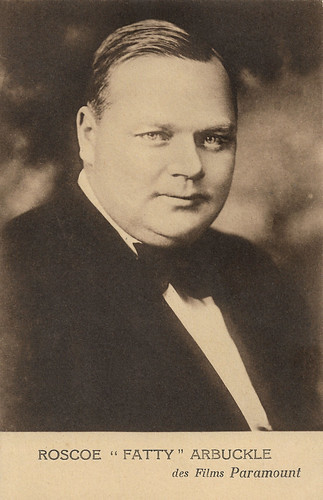
French postcard by Édition Paramount, Paris.
American comedian Roscoe ‘Fatty’ Arbuckle (1887-1933) was one of the most popular silent stars of the 1910s. He started at the Selig Polyscope and moved to Keystone Studios, where he worked with Mabel Normand and Harold Lloyd . Arbuckle mentored Charlie Chaplin and discovered Buster Keaton and Bob Hope. In 1920, he signed a contract with Paramount Pictures for US$ 1 million. Between November 1921 and April 1922, Arbuckle was the defendant in three widely publicised trials for the rape and manslaughter of actress Virginia Rappe. Following the trials, his films were banned and he was publicly ostracised. Arbuckle only later worked as a film director under the alias William Goodrich. He was finally able to return to acting, making short two-reel comedies in 1932 for Warner Bros. He died in his sleep of a heart attack in 1933 at age 46, reportedly on the same day he signed a contract with Warner Brothers to make a feature film.
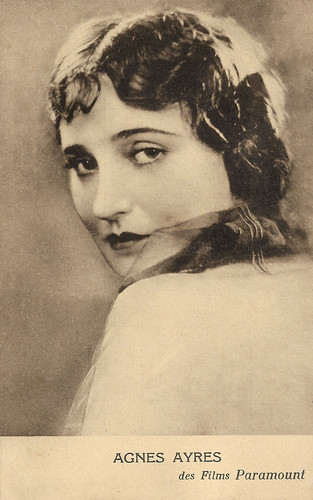
French postcard by Édition Paramount, Paris.
Agnes Ayres (1898-1940) was an American film actress. After her debut with Chaplin and acting at Essanay and Fox, she had her breakthrough in The Sheik (1921) with Rudolph Valentino . Several important parts at Paramount followed in e.g. The Affairs of Anatol (1921) and The Ten Commandments (1923). After a dip in the mid-1920s, she had her comeback in The Son of the Sheik (1926), but the arrival of sound cinema made an end to her career.
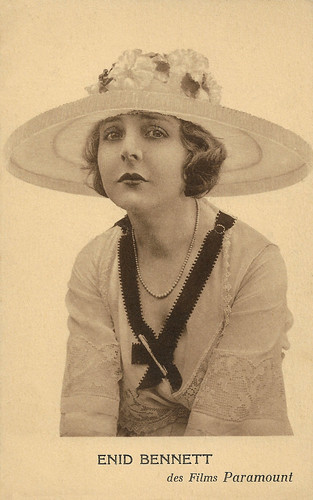
French postcard by Édition Paramount, Paris.
Enid Bennett (1893–1969) was an Australian silent film actress, mostly active in American film. She peaked in the late 1910s and early 1920s with films such as Robin Hood (1922), starring Douglas Fairbanks . In 1931 she played Jackie Coogan 's mother in the Oscar-winning film Skippy. She was the wife of director Fred Niblo and after his death, she married director Sidney Franklin.
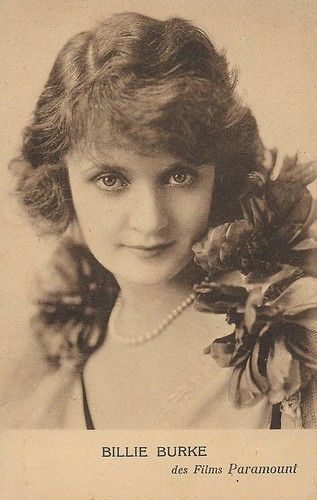
French postcard by Édition Paramount, Paris.
American actress Billie Burke (1884–1970) is now primarily known as Glinda the Good Witch of the North in The Wizard of Oz (Victor Fleming, 1939), but she had an impressive career both on stage and in the cinema, in Britain and the US.
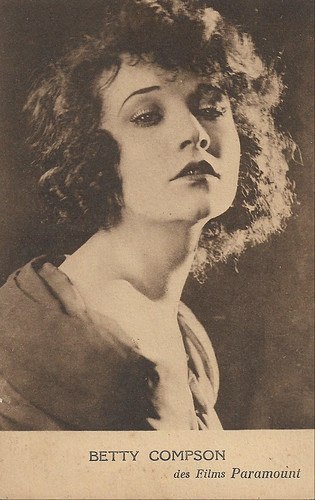
French postcard by Édition Paramount, Paris.
American actress and film producer Betty Compson (1897–1974) peaked in the silent cinema and the early talkies. She is best known for her performances as a suicidal prostitute rescued by a stoker ( George Bancroft ) in The Docks of New York (Joseph Von Sternberg, 1928), and as the manipulative carnival girl Carrie in the part-talkie The Barker (George Fitzmaurice, 1928), the latter earning her a nomination for the Academy Award for Best Actress.
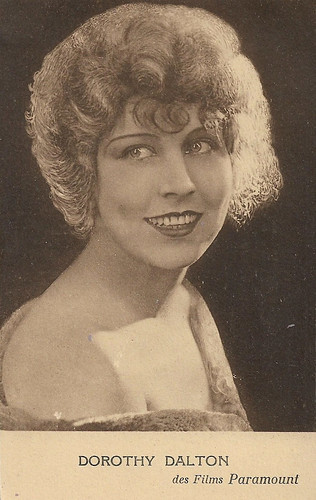
French postcard by Édition Paramount, Paris.
Dorothy Dalton (1893-1972) was an American actress, who was highly popular in the silent era. She worked for Kay-Bee, Thomas Ince Corp., and Famous Players (Paramount), but left the film sets in 1924 when she married theatre producer Arthur Hammerstein.
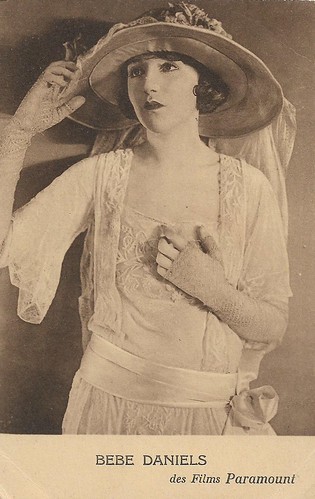
French postcard by Édition Paramount, Paris.
Bebe Daniels (1901-1971) began her career in Hollywood during the silent film era as a child actress. She later became the love interest of Harold Lloyd in dozens of short comedies. Cecil B. de Mille made her a silent star and later she sang and danced in early musicals like Rio Rita (1929) and 42nd Street (1933). In Great Britain, she gained further fame on stage, radio, and television. In her long career, Bebe Daniels appeared in 230 films.
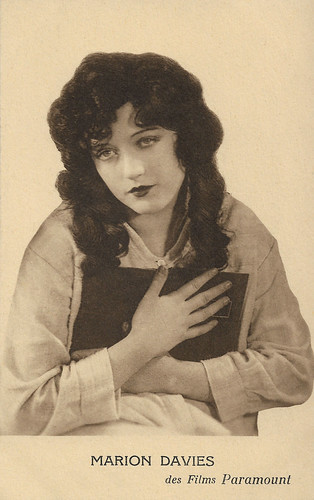
French postcard by Édition Paramount, Paris. Photo: Marion Davies in The Bride's Play (George Terwilliger, 1922).
Marion Davies (1897-1961) was one of the great comedic actresses of the silent era. She starred in nearly four dozen films between 1917 and 1937.
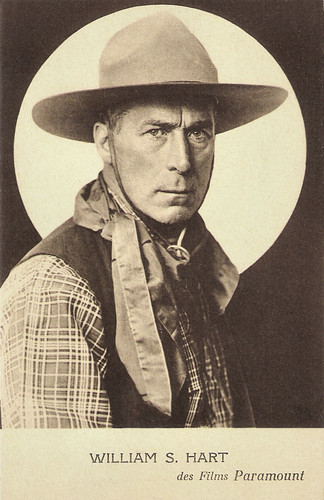
French postcard by Édition Paramount, Paris.
William Surrey Hart (1864–1946) was an American silent film actor, screenwriter, director, and producer. He entered films in 1914 where, after playing supporting roles in two short films, he achieved stardom as the lead in The Bargain (Reginald Barker, 1914), his first Western. He became a foremost Western star of the silent era who played characters with honour and integrity. Hart was particularly interested in making realistic Westerns, and his films are noted for their authentic costumes and props. Hart also had an extraordinary acting ability, honed on Shakespearean theatre stages in the United States and England.
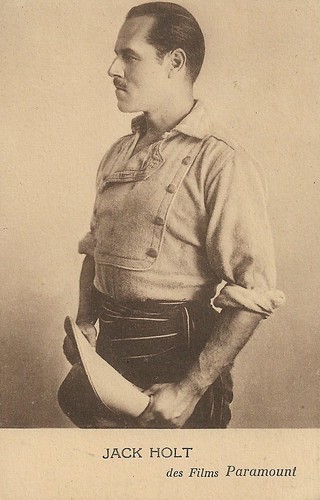
French postcard by Édition Paramount, Paris.
Jack Holt (1888–1951), was an American film actor in both silent and sound movies, particularly in Westerns.
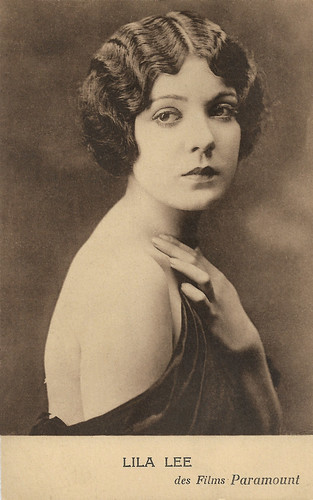
French postcard by Édition Paramount, Paris.
Lila Lee (1901–1973) was a prominent screen actress, primarily a leading lady, of the silent film and early sound film eras.
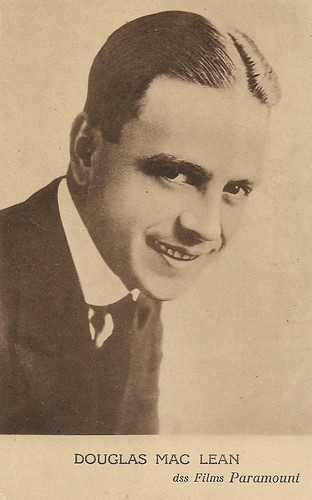
French postcard by Édition Paramount, Paris.
American silent film actor Douglas MacLean (1890–1967) acted in many romantic comedies, and was known as 'The Man With the Million Dollar Smile'. MacLean started in the pictures in 1914, acted opposite Alice Brady, Mary Pickford, and Dorothy Gish. After some 25 films for various companies, he worked for Paramount and First National between 1922 and 1929. In the 1930s, he produced films for Paramount and afterward was a freelance writer for film and television.
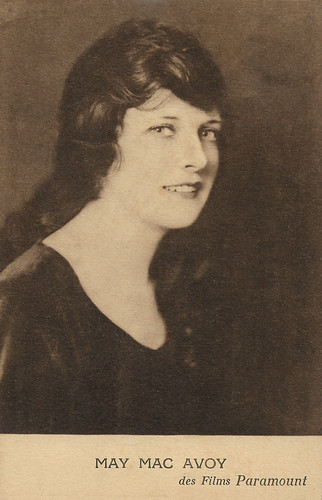
French postcard by Édition Paramount, Paris.
May McAvoy (1899-1984), also written as MacAvoy and Mac Avoy, was an American actress of the silent screen, best known as Esther in the classic epic Ben-Hur (Fred Niblo, 1925).
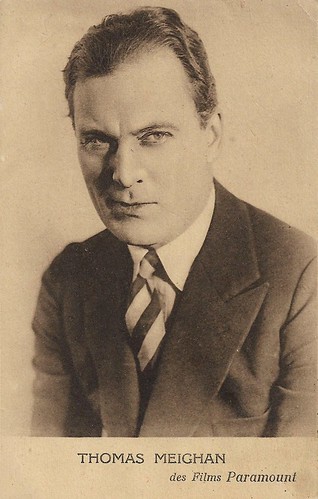
French postcard by Édition Paramount, Paris.
Thomas Meighan (1879-1936) was an American stage and screen actor, noted for his films with directors William and Cecil B. DeMille.
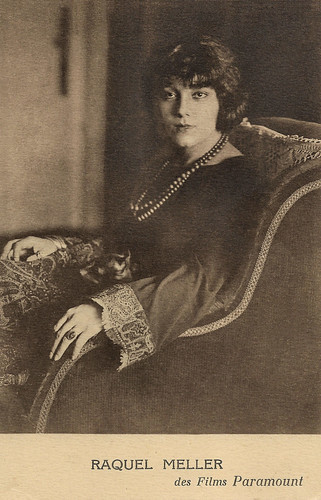
French postcard by Édition Paramount, Paris.
Spanish diva Raquel Meller (1888-1962) was already a highly popular singer before debuting as a film actress in 1919. She performed not only in Spain but also in France and the USA.
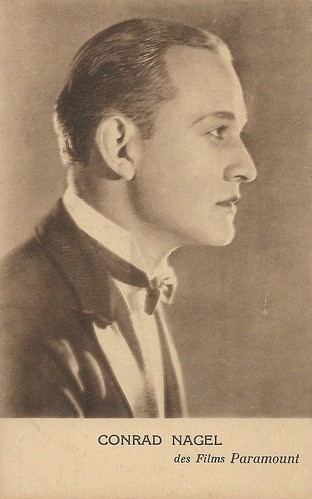
French postcard by Édition Paramount, Paris.
American actor Conrad Nagel (1897-1970) was a tall, blue-eyed matinee idol of the 1920s. He successfully made the transition to sound film.
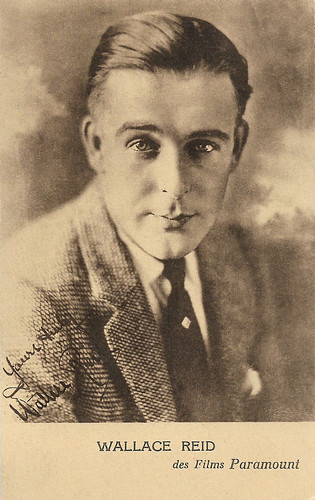
French postcard by Édition Paramount, Paris.
American silent film actor Wallace Reid (1891–1923) was 'the screen's most perfect lover'. Born in a vaudeville family, he became an all-around athlete and a gifted musician. When his father entered the film business in 1910, he brought along his teenage son, who debuted at Selig but soon rose to popularity at Vitagraph. After some 100 shorts and parts in films like Birth of a nation and Intolerance by D.W. Griffith, Paramount hired him for some 60 more films. By the 1920s, Reid was one of Hollywood's major heartthrobs. En route to Oregon for a film shooting in 1919, he was injured in a train wreck and took morphine to continue filming. This led to an addiction, which in 1923 killed him, at the age of only 31.
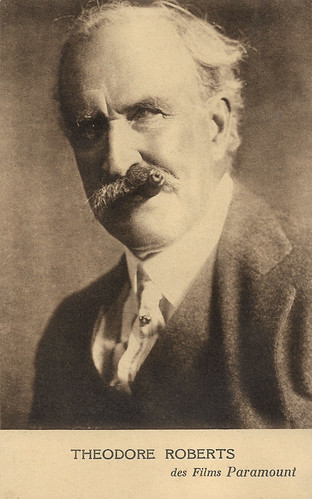
French postcard by Édition Paramount, Paris.
Theodore Roberts (1861–1928) was an American stage and screen actor, who is known for his many parts in films by Cecil B. DeMille and his brother William.
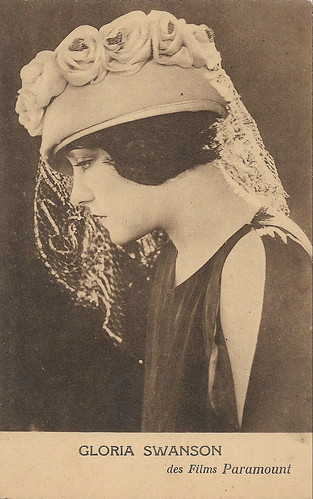
French postcard by Édition Paramount, Paris.
Gloria Swanson (1899-1983) was one of the biggest Hollywood stars of the silent era. She transformed from a typical Mack Sennett comedienne into a lively, provocative, even predatory, star in films by Cecil B. De Mille. She received Oscar nominations for Sadie Thompson (1928), The Trespasser (1929), and Sunset Blvd. (1950).
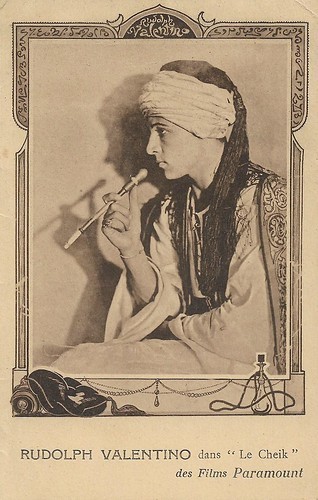
French postcard by Édition Paramount, Paris. Rudolph Valentino in The Sheik (George Melford, 1921).
Rudolph Valentino (1895-1926) was Hollywood's ultimate 'Latin Lover'. The Italian-born American actor starred in several well-known silent films including The Four Horsemen of the Apocalypse (1921), The Sheik (1921), Blood and Sand (1922), The Eagle (1925), and The Son of the Sheik (1926). His early death at age 31 caused mass hysteria among his female fans and propelled him into iconic status.
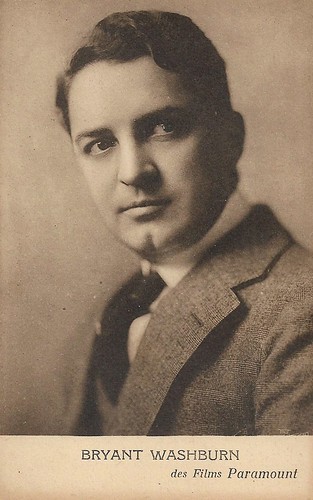
French postcard by Édition Paramount, Paris.
American film actor Bryant Washburn (1889–1963) appeared in 375 films between 1911 and 1947. From 1911, he was one of the leading actors of the Essanay company. He quickly became a comedy star after appearing in films such as Skinner's Baby and Skinner's Dress Suit in 1917. In 1918 he moved over to Paramount/Famous Players-Lasky. In the 1910s and the early 1920s, he was one of the most popular American actors. From the mid-1920s he played supporting parts and managed to continue so well into the sound era.
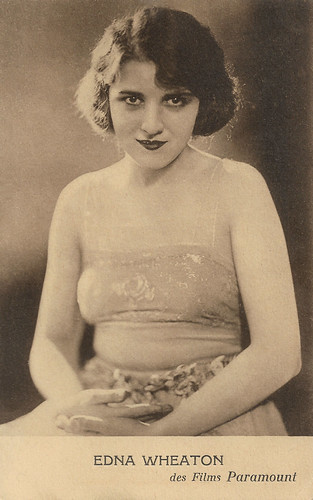
French postcard by Édition Paramount, Paris. Photo: Films Paramount.
American dancer and actress Edna Wheaton (1882-1967) was the star of only one film, the Paramount production Experience (George Fitzmaurice, 1921). She appeared as Beauty while co-stars Richard Barthelmess played Youth, Lilyan Tashman played Pleasure and Nita Naldi played Temptation. The title role, Experience, was performed by John Miltern.

French postcard by Édition Paramount, Paris.
American comedian Roscoe ‘Fatty’ Arbuckle (1887-1933) was one of the most popular silent stars of the 1910s. He started at the Selig Polyscope and moved to Keystone Studios, where he worked with Mabel Normand and Harold Lloyd . Arbuckle mentored Charlie Chaplin and discovered Buster Keaton and Bob Hope. In 1920, he signed a contract with Paramount Pictures for US$ 1 million. Between November 1921 and April 1922, Arbuckle was the defendant in three widely publicised trials for the rape and manslaughter of actress Virginia Rappe. Following the trials, his films were banned and he was publicly ostracised. Arbuckle only later worked as a film director under the alias William Goodrich. He was finally able to return to acting, making short two-reel comedies in 1932 for Warner Bros. He died in his sleep of a heart attack in 1933 at age 46, reportedly on the same day he signed a contract with Warner Brothers to make a feature film.

French postcard by Édition Paramount, Paris.
Agnes Ayres (1898-1940) was an American film actress. After her debut with Chaplin and acting at Essanay and Fox, she had her breakthrough in The Sheik (1921) with Rudolph Valentino . Several important parts at Paramount followed in e.g. The Affairs of Anatol (1921) and The Ten Commandments (1923). After a dip in the mid-1920s, she had her comeback in The Son of the Sheik (1926), but the arrival of sound cinema made an end to her career.

French postcard by Édition Paramount, Paris.
Enid Bennett (1893–1969) was an Australian silent film actress, mostly active in American film. She peaked in the late 1910s and early 1920s with films such as Robin Hood (1922), starring Douglas Fairbanks . In 1931 she played Jackie Coogan 's mother in the Oscar-winning film Skippy. She was the wife of director Fred Niblo and after his death, she married director Sidney Franklin.

French postcard by Édition Paramount, Paris.
American actress Billie Burke (1884–1970) is now primarily known as Glinda the Good Witch of the North in The Wizard of Oz (Victor Fleming, 1939), but she had an impressive career both on stage and in the cinema, in Britain and the US.

French postcard by Édition Paramount, Paris.
American actress and film producer Betty Compson (1897–1974) peaked in the silent cinema and the early talkies. She is best known for her performances as a suicidal prostitute rescued by a stoker ( George Bancroft ) in The Docks of New York (Joseph Von Sternberg, 1928), and as the manipulative carnival girl Carrie in the part-talkie The Barker (George Fitzmaurice, 1928), the latter earning her a nomination for the Academy Award for Best Actress.

French postcard by Édition Paramount, Paris.
Dorothy Dalton (1893-1972) was an American actress, who was highly popular in the silent era. She worked for Kay-Bee, Thomas Ince Corp., and Famous Players (Paramount), but left the film sets in 1924 when she married theatre producer Arthur Hammerstein.

French postcard by Édition Paramount, Paris.
Bebe Daniels (1901-1971) began her career in Hollywood during the silent film era as a child actress. She later became the love interest of Harold Lloyd in dozens of short comedies. Cecil B. de Mille made her a silent star and later she sang and danced in early musicals like Rio Rita (1929) and 42nd Street (1933). In Great Britain, she gained further fame on stage, radio, and television. In her long career, Bebe Daniels appeared in 230 films.

French postcard by Édition Paramount, Paris. Photo: Marion Davies in The Bride's Play (George Terwilliger, 1922).
Marion Davies (1897-1961) was one of the great comedic actresses of the silent era. She starred in nearly four dozen films between 1917 and 1937.

French postcard by Édition Paramount, Paris.
William Surrey Hart (1864–1946) was an American silent film actor, screenwriter, director, and producer. He entered films in 1914 where, after playing supporting roles in two short films, he achieved stardom as the lead in The Bargain (Reginald Barker, 1914), his first Western. He became a foremost Western star of the silent era who played characters with honour and integrity. Hart was particularly interested in making realistic Westerns, and his films are noted for their authentic costumes and props. Hart also had an extraordinary acting ability, honed on Shakespearean theatre stages in the United States and England.

French postcard by Édition Paramount, Paris.
Jack Holt (1888–1951), was an American film actor in both silent and sound movies, particularly in Westerns.

French postcard by Édition Paramount, Paris.
Lila Lee (1901–1973) was a prominent screen actress, primarily a leading lady, of the silent film and early sound film eras.

French postcard by Édition Paramount, Paris.
American silent film actor Douglas MacLean (1890–1967) acted in many romantic comedies, and was known as 'The Man With the Million Dollar Smile'. MacLean started in the pictures in 1914, acted opposite Alice Brady, Mary Pickford, and Dorothy Gish. After some 25 films for various companies, he worked for Paramount and First National between 1922 and 1929. In the 1930s, he produced films for Paramount and afterward was a freelance writer for film and television.

French postcard by Édition Paramount, Paris.
May McAvoy (1899-1984), also written as MacAvoy and Mac Avoy, was an American actress of the silent screen, best known as Esther in the classic epic Ben-Hur (Fred Niblo, 1925).

French postcard by Édition Paramount, Paris.
Thomas Meighan (1879-1936) was an American stage and screen actor, noted for his films with directors William and Cecil B. DeMille.

French postcard by Édition Paramount, Paris.
Spanish diva Raquel Meller (1888-1962) was already a highly popular singer before debuting as a film actress in 1919. She performed not only in Spain but also in France and the USA.

French postcard by Édition Paramount, Paris.
American actor Conrad Nagel (1897-1970) was a tall, blue-eyed matinee idol of the 1920s. He successfully made the transition to sound film.

French postcard by Édition Paramount, Paris.
American silent film actor Wallace Reid (1891–1923) was 'the screen's most perfect lover'. Born in a vaudeville family, he became an all-around athlete and a gifted musician. When his father entered the film business in 1910, he brought along his teenage son, who debuted at Selig but soon rose to popularity at Vitagraph. After some 100 shorts and parts in films like Birth of a nation and Intolerance by D.W. Griffith, Paramount hired him for some 60 more films. By the 1920s, Reid was one of Hollywood's major heartthrobs. En route to Oregon for a film shooting in 1919, he was injured in a train wreck and took morphine to continue filming. This led to an addiction, which in 1923 killed him, at the age of only 31.

French postcard by Édition Paramount, Paris.
Theodore Roberts (1861–1928) was an American stage and screen actor, who is known for his many parts in films by Cecil B. DeMille and his brother William.

French postcard by Édition Paramount, Paris.
Gloria Swanson (1899-1983) was one of the biggest Hollywood stars of the silent era. She transformed from a typical Mack Sennett comedienne into a lively, provocative, even predatory, star in films by Cecil B. De Mille. She received Oscar nominations for Sadie Thompson (1928), The Trespasser (1929), and Sunset Blvd. (1950).

French postcard by Édition Paramount, Paris. Rudolph Valentino in The Sheik (George Melford, 1921).
Rudolph Valentino (1895-1926) was Hollywood's ultimate 'Latin Lover'. The Italian-born American actor starred in several well-known silent films including The Four Horsemen of the Apocalypse (1921), The Sheik (1921), Blood and Sand (1922), The Eagle (1925), and The Son of the Sheik (1926). His early death at age 31 caused mass hysteria among his female fans and propelled him into iconic status.

French postcard by Édition Paramount, Paris.
American film actor Bryant Washburn (1889–1963) appeared in 375 films between 1911 and 1947. From 1911, he was one of the leading actors of the Essanay company. He quickly became a comedy star after appearing in films such as Skinner's Baby and Skinner's Dress Suit in 1917. In 1918 he moved over to Paramount/Famous Players-Lasky. In the 1910s and the early 1920s, he was one of the most popular American actors. From the mid-1920s he played supporting parts and managed to continue so well into the sound era.

French postcard by Édition Paramount, Paris. Photo: Films Paramount.
American dancer and actress Edna Wheaton (1882-1967) was the star of only one film, the Paramount production Experience (George Fitzmaurice, 1921). She appeared as Beauty while co-stars Richard Barthelmess played Youth, Lilyan Tashman played Pleasure and Nita Naldi played Temptation. The title role, Experience, was performed by John Miltern.
Published on October 27, 2020 23:00
October 26, 2020
Gyurkovicsarna (1920)
Gösta Ekman and Pauline Brunius were the stars in the silent Swedish comedy Gyurkovicsarna/Lieutenant Tophat (John W. Brunius, 1920). Ekman and Brunius also wrote the script. For this Skandia Film production, Förlag Nordisk Konst in Stockholm made a series of six sepia postcards.
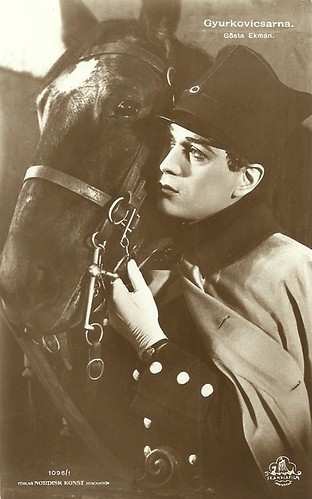
Swedish postcard by Forlag Nordisk Konst, Stockholm, no. 1096/1. Photo: Skandia Film. Gösta Ekman in Gyurkovicsarna/Lieutenant Tophat (John W. Brunius, 1920).
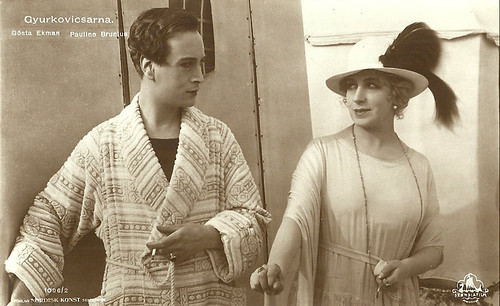
Swedish postcard by Forlag Nordisk Konst, Stockholm, no. 1096/2. Photo: Skandia Film. Gösta Ekman and Pauline Brunius in Gyurkovicsarna/Lieutenant Tophat (John W. Brunius, 1920).
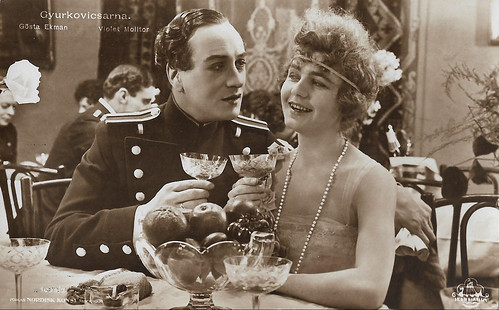
Swedish postcard by Förlag Nordisk Konst, Stockholm, no. 1096/3. Photo: Skandia Film. Gösta Ekman and Violet Molitor in Gyurkovicsarna/Lieutenant Tophat (John W. Brunius, 1920).
Happily not-married ever after
The plot of Gyurkovicsarna/Lieutenant Tophat (John W. Brunius, 1920) evolves in Hungary. Mr. Gyurkovics (Julius Hälsig) and Mrs. Gyurkovics (Gucken Cederborg) have a dozen children of whom the eldest, the twins Géza ( Gösta Ekman ) and Bandi ( Nils Asther ), just prepare for their matriculation exam.
When graduation day arrives, Géza refuses to come but is taken by force by the principal's attendant. When father Gyurkovics dies later, Bandi takes over the estate while Géza becomes an officer aspirant in the nearby garrison city.
Géza soon meets an angry colonel (opera singer Emil Stiebel) who puts him in his place. He goes to the restaurant and chases out all the other guests with his dragon saber, for which he is arrested. Once out again, he immediately begins to make boys' streaks, is discovered by the colonel, and is chased around the regiment building.
He takes refuge in a room where it appears that, at the top, the colonel's young daughter, Jutka (Violet Molitor), is sleeping. When the customary ball takes place in Baja, Géza awakens by continuously dancing with Jutka. The colonel orders a lieutenant to make sure the couple is divorced. The lieutenant executes the order such that Géza challenges him to a duel. None of them, however, are particularly keen to hurt the other and no accident occurs.
After a while Géza becomes under-lieutenant. He wins at card games and gets permission to visit a seaside resort, where he meets a general, a minister, and Freiherr Hetvics-Janky (Henrik Ljungberg). The Freiherr's wife ( Pauline Brunius ) is unhappily married and wants to provoke her husband to get a divorce. She immediately appeals to Géza and suggests that he will abduct her, as he would like to do.
Meanwhile, Mother Gyurkovic sends her son Bandi to the garrison city to keep an eye on Géza. Bandi meets Jutka and sweet love arises between them. Géza and the Freiherr's wife make a compromising train journey. Her husband, the field-marshall, meets them on their trip, behaves extremely favorably to Géza, and refuses to be provoked. Thus, Géza avoids all obligations versus the intriguing Freiherr's wife. There will be a wedding between Bandi and Jutka. Among the wedding guests, there is Géza, who is happy to have failed to marry.
Gyurkovicsarna was a film adaptation of the novel 'A Gyurkovics-fiúk' by author Ferenc Herczeg. Exteriors were shot in Kalrberg and Falsterbo near Stockhlm and Mölle, Skane, while interiors were shot at the Skandia studios in Stockholm. The film premiered in 20 September 1920 simultaneously at the cinemas Victoria in Göteborg, Skandiabiografen in Norrköping, Skandia in Västerås and the Sture-Teatern in Stockholm.
The full film can be seen on Swedish Wikipedia.
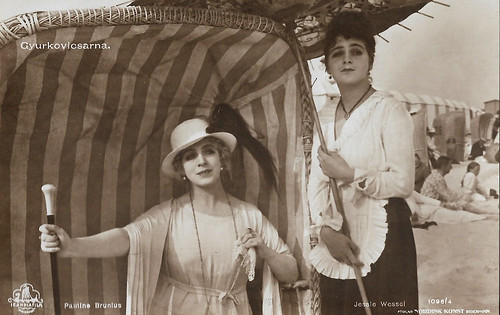
Swedish postcard by Förlag Nordisk Konst, Stockholm, no. 1096/4. Photo: Skandia Film. Pauline Brunius and Jessie Wessel in Gyurkovicsarna/Lieutenant Tophat (John W. Brunius, 1920).
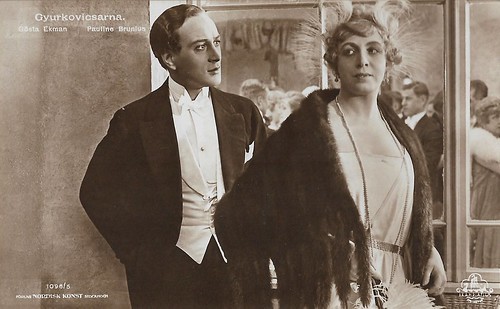
Swedish postcard by Förlag Nordisk Konst, Stockholm, no. 1096/5. Photo: Skandia Film. Gösta Ekman and Pauline Brunius in Gyurkovicsarna/Lieutenant Tophat (John W. Brunius, 1920).
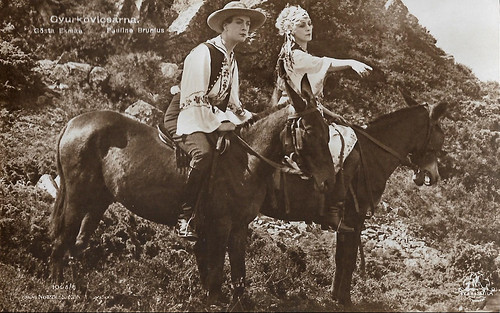
Swedish postcard by Förlag Nordisk Konst, Stockholm, no. 1096/6. Photo: Skandia Film. Gösta Ekman and Pauline Brunius in Gyurkovicsarna/Lieutenant Tophat (John W. Brunius, 1920).
Sources: The Swedish Film Database, Wikipedia (Swedish), and IMDb.

Swedish postcard by Forlag Nordisk Konst, Stockholm, no. 1096/1. Photo: Skandia Film. Gösta Ekman in Gyurkovicsarna/Lieutenant Tophat (John W. Brunius, 1920).

Swedish postcard by Forlag Nordisk Konst, Stockholm, no. 1096/2. Photo: Skandia Film. Gösta Ekman and Pauline Brunius in Gyurkovicsarna/Lieutenant Tophat (John W. Brunius, 1920).

Swedish postcard by Förlag Nordisk Konst, Stockholm, no. 1096/3. Photo: Skandia Film. Gösta Ekman and Violet Molitor in Gyurkovicsarna/Lieutenant Tophat (John W. Brunius, 1920).
Happily not-married ever after
The plot of Gyurkovicsarna/Lieutenant Tophat (John W. Brunius, 1920) evolves in Hungary. Mr. Gyurkovics (Julius Hälsig) and Mrs. Gyurkovics (Gucken Cederborg) have a dozen children of whom the eldest, the twins Géza ( Gösta Ekman ) and Bandi ( Nils Asther ), just prepare for their matriculation exam.
When graduation day arrives, Géza refuses to come but is taken by force by the principal's attendant. When father Gyurkovics dies later, Bandi takes over the estate while Géza becomes an officer aspirant in the nearby garrison city.
Géza soon meets an angry colonel (opera singer Emil Stiebel) who puts him in his place. He goes to the restaurant and chases out all the other guests with his dragon saber, for which he is arrested. Once out again, he immediately begins to make boys' streaks, is discovered by the colonel, and is chased around the regiment building.
He takes refuge in a room where it appears that, at the top, the colonel's young daughter, Jutka (Violet Molitor), is sleeping. When the customary ball takes place in Baja, Géza awakens by continuously dancing with Jutka. The colonel orders a lieutenant to make sure the couple is divorced. The lieutenant executes the order such that Géza challenges him to a duel. None of them, however, are particularly keen to hurt the other and no accident occurs.
After a while Géza becomes under-lieutenant. He wins at card games and gets permission to visit a seaside resort, where he meets a general, a minister, and Freiherr Hetvics-Janky (Henrik Ljungberg). The Freiherr's wife ( Pauline Brunius ) is unhappily married and wants to provoke her husband to get a divorce. She immediately appeals to Géza and suggests that he will abduct her, as he would like to do.
Meanwhile, Mother Gyurkovic sends her son Bandi to the garrison city to keep an eye on Géza. Bandi meets Jutka and sweet love arises between them. Géza and the Freiherr's wife make a compromising train journey. Her husband, the field-marshall, meets them on their trip, behaves extremely favorably to Géza, and refuses to be provoked. Thus, Géza avoids all obligations versus the intriguing Freiherr's wife. There will be a wedding between Bandi and Jutka. Among the wedding guests, there is Géza, who is happy to have failed to marry.
Gyurkovicsarna was a film adaptation of the novel 'A Gyurkovics-fiúk' by author Ferenc Herczeg. Exteriors were shot in Kalrberg and Falsterbo near Stockhlm and Mölle, Skane, while interiors were shot at the Skandia studios in Stockholm. The film premiered in 20 September 1920 simultaneously at the cinemas Victoria in Göteborg, Skandiabiografen in Norrköping, Skandia in Västerås and the Sture-Teatern in Stockholm.
The full film can be seen on Swedish Wikipedia.

Swedish postcard by Förlag Nordisk Konst, Stockholm, no. 1096/4. Photo: Skandia Film. Pauline Brunius and Jessie Wessel in Gyurkovicsarna/Lieutenant Tophat (John W. Brunius, 1920).

Swedish postcard by Förlag Nordisk Konst, Stockholm, no. 1096/5. Photo: Skandia Film. Gösta Ekman and Pauline Brunius in Gyurkovicsarna/Lieutenant Tophat (John W. Brunius, 1920).

Swedish postcard by Förlag Nordisk Konst, Stockholm, no. 1096/6. Photo: Skandia Film. Gösta Ekman and Pauline Brunius in Gyurkovicsarna/Lieutenant Tophat (John W. Brunius, 1920).
Sources: The Swedish Film Database, Wikipedia (Swedish), and IMDb.
Published on October 26, 2020 23:00
Paul van Yperen's Blog
- Paul van Yperen's profile
- 13 followers
Paul van Yperen isn't a Goodreads Author
(yet),
but they
do have a blog,
so here are some recent posts imported from
their feed.



